Team Accountability – Workshop 3 (Psychological Safety)

The Appleton Greene Corporate Training Program (CTP) for Team Accountability is provided by Mr. Teschner MBA BA Certified Learning Provider (CLP). Program Specifications: Monthly cost USD$2,500.00; Monthly Workshops 6 hours; Monthly Support 4 hours; Program Duration 12 months; Program orders subject to ongoing availability.
If you would like to view the Client Information Hub (CIH) for this program, please Click Here
Learning Provider Profile

Mr. Teschner is a transformational Leadership Coach and Trainer and Founder & CEO of VMax Group. VMax Group is a St Louis-based Leadership Development company specializing in teaching accountable leadership and high-performing teamwork to businesses across the globe. VMax Group has centered much of its signature training around the proper practice of Accountability. Real Accountability—positive, forward-focused Accountability centered around the process of taking Absolute Ownership for the outcomes the team achieves—is something Mr. Teschner and his team lived during their collective time as member of high-performance military teams. Now they’ve made it their mission to teach what they know to those who need to learn it.

A decorated graduate of the U.S. Air Force Academy, Air University, and the National War College, Mr. Teschner is also both a Distinguished Graduate and former F-15 Instructor at the USAF Weapons School – the Air Force version of “TOP GUN”. It was there that he honed his craft of teaching accountable leadership to the top practitioners in the world. Additionally, Mr. Teschner was privileged to command an operational F-22 “Raptor” squadron, flying America’s most advanced air supremacy platform. Mr. Teschner was ultimately honored to be promoted to the rank of full Colonel but retired early as a result of a battle with colon-rectal cancer. Mr. Teschner has over 20 years of hands-on leadership experience in High-Performance, High-Reliability Organizations and brings all of that experience with him wherever he speaks, teaches or coaches.

Mr. Teschner has a special way of connecting with his audiences, blending high-impact stories of fighter aviation and personal humility to achieve the intended outcome. In addition, his story of his personal fight with cancer serves as the launch pad for talks about humility, growth, motivation, and constant improvement. Mr. Teschner is the author of the #1 bestselling book, Debrief to Win: How High-Performing Leaders Practice Accountable Leadership, and released his newest bestselling book Aiming Higher: A Journey Through Military Aviation Leadership, a book co-authored with 4 other former Air Force pilots, in May of 2022. His next book, Building Resilience, is due out in the Spring of 2023.
MOST Analysis
Mission Statement
This is the introduction to culture, an exploration of Edmondson’s and Clark’s work on Psychological Safety. Outcome: the team understands. Psychological Safety. Desired Learning Objectives: We understand the impact Fear has on team dynamics. We understand and can start building Psychological Safety. We understand the upside of Failure. We understand Clark’s 4 Stages of Psychological Safety.
Objectives
01. The Importance: departmental SWOT analysis; strategy research & development. Time Allocated: 1 Month
02. Measuring Safety: departmental SWOT analysis; strategy research & development. Time Allocated: 1 Month
03. Inclusion Safety: departmental SWOT analysis; strategy research & development. Time Allocated: 1 Month
04. Learner Safety: departmental SWOT analysis; strategy research & development. Time Allocated: 1 Month
05. Contributor Safety: departmental SWOT analysis; strategy research & development. Time Allocated: 1 Month
06. Challenger Safety: departmental SWOT analysis; strategy research & development. Time Allocated: 1 Month
07. Fear: departmental SWOT analysis; strategy research & development. 1 Month
08. No-Blame Culture: departmental SWOT analysis; strategy research & development. Time Allocated: 1 Month
09. Failure: departmental SWOT analysis; strategy research & development. Time Allocated: 1 Month
10. Manager’s Role: departmental SWOT analysis; strategy research & development. Time Allocated: 1 Month
11. Hybrid Workplaces: departmental SWOT analysis; strategy research & development. Time Allocated: 1 Month
12. Leadership Development: departmental SWOT analysis; strategy research & development. Time Allocated: 1 Month
Strategies
01. The Importance: Each individual department head to undertake departmental SWOT analysis; strategy research & development.
02. Measuring Safety: Each individual department head to undertake departmental SWOT analysis; strategy research & development.
03. Inclusion Safety: Each individual department head to undertake departmental SWOT analysis; strategy research & development.
04. Learner Safety: Each individual department head to undertake departmental SWOT analysis; strategy research & development.
05. Contributor Safety: Each individual department head to undertake departmental SWOT analysis; strategy research & development.
06. Challenger Safety: Each individual department head to undertake departmental SWOT analysis; strategy research & development.
07. Fear: Each individual department head to undertake departmental SWOT analysis; strategy research & development.
08. No-Blame Culture: Each individual department head to undertake departmental SWOT analysis; strategy research & development.
09. Failure: Each individual department head to undertake departmental SWOT analysis; strategy research & development.
10. Manager’s Role: Each individual department head to undertake departmental SWOT analysis; strategy research & development.
11. Hybrid Workplaces: Each individual department head to undertake departmental SWOT analysis; strategy research & development.
12. Leadership Development: Each individual department head to undertake departmental SWOT analysis; strategy research & development.
Tasks
01. Create a task on your calendar, to be completed within the next month, to analyze The Importance.
02. Create a task on your calendar, to be completed within the next month, to analyze Measuring Safety.
03. Create a task on your calendar, to be completed within the next month, to analyze Inclusion Safety.
04. Create a task on your calendar, to be completed within the next month, to analyze Learner Safety.
05. Create a task on your calendar, to be completed within the next month, to analyze Contributor Safety.
06. Create a task on your calendar, to be completed within the next month, to analyze Challenger Safety.
07. Create a task on your calendar, to be completed within the next month, to analyze Fear.
08. Create a task on your calendar, to be completed within the next month, to analyze No-Blame Culture.
09. Create a task on your calendar, to be completed within the next month, to analyze Failure.
10. Create a task on your calendar, to be completed within the next month, to analyze Manager’s Role.
11. Create a task on your calendar, to be completed within the next month, to analyze Hybrid Workplaces.
12. Create a task on your calendar, to be completed within the next month, to analyze Leadership Development.
Introduction
What Exactly Is Psychological Safety?
Simply said, psychological safety is the confidence that you can be yourself at work – that you can work honestly, openly, and truthfully without worrying about criticism or repercussions.
Our confidence to enter the office each day, feeling strong and prepared to face whatever the workweek may bring, is supported by psychological safety.
Importantly, psychological safety fosters a culture of prudent risk-taking, encouraging you to take on new challenges with the confidence that your staff won’t criticize you or point out your “mistakes” if you fall short of the target. They’ll assist you in getting to your destination instead.
This is how corporate culture, or the assurance that “this is the way we do things around here,” plays a key role in fostering psychological safety. In the aforementioned scenario, it is probably because you are afraid of the unknown that your initial reaction is to get off the train and come up with reasons not to enter. How are errors like these handled in your company? Will your boss be furious? Will they shout? In what way will you be repaid? Will you face retribution? Do you have anything to worry about?
A culture that values education and views mistakes as learning opportunities rather than failures is a natural fit for psychological safety. Employees in these businesses are motivated to promote innovative working methods because they know that not only will their ideas be listened, but also if something goes wrong, blame will be shared.
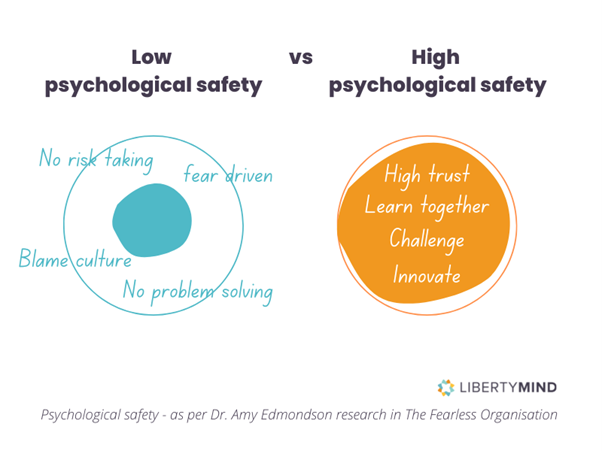
Because of this, psychological safety is a requirement of effective organizations. Failure to establish a culture that encourages speaking up will probably result in skyrocketing turnover rates and declining productivity. Even worse, you’ll foster a culture where taking chances is discouraged, which will stifle innovation and demoralize your most skilled employees.
The Four Stages Of Psychological Safety
Dr. Timothy Clark identified the following as the four levels of psychological safety:
• Stage 1 – The first stage of safety is known as inclusion safety, and it focuses on meeting the fundamental human need for connection and belonging. You feel secure and loved just as you are at this initial stage, weird traits and all.
• Stage 2: Learner security. You feel comfortable learning, asking questions, and trying new things at this point. You’re more willing to provide and accept criticism now (and you even feel safe to make mistakes).
• Stage 3 – Contributor safety. At this stage, you finally feel secure enough to use your abilities and gifts to contribute in a meaningful way.
• Stage 4 –Challenger safety. In the last phase, you must feel secure enough to question the status quo when you notice a chance for improvement or change.
Dr. Clark asserts that team members need to move through these phases in order to feel confident enough to speak up and offer significant contributions.
It Takes Time To Establish Psychological Safety At Work
The goal of psychological safety in the workplace is to create an environment where people can be authentically themselves. The following excerpt from the New York Times Magazine story about Google’s hunt for the ideal team sums it all up wonderfully (and is more pertinent than ever given our efforts to create hybrid workplaces):
Nobody wants to leave a piece of their individuality or inner life at home. However, in order to be completely present at work and to be “psychologically safe,” we must be confident that we may occasionally be free enough to discuss the things that frighten us without worrying about being blamed. To have difficult conversations with coworkers who are driving us crazy, we must be able to talk about what is messy or sad. Efficiency cannot be our only priority.
Furthermore, it’s crucial to avoid making the mistake of assuming that once the prerequisites for an emotionally secure workplace are in place, employee engagement and a healthy workplace culture will naturally follow. These are likewise crucial components of a thriving organization and call for concentrated work.
But if you don’t put psychological safety at work first, you’ll find it difficult to engage staff members and watch your culture flourish.
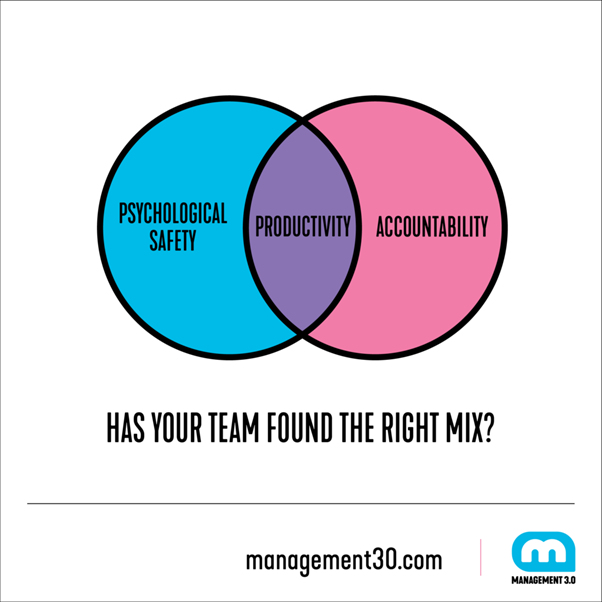
Psychological Safety: What It Is Not
A psychological safety net does not protect you from responsibility. It’s not rhetorical assurance, political correctness, coddling, consensus decision-making, unearned autonomy, or niceness. Let’s agree on what it is first before talking further about what it isn’t.
In their 1965 book, Personal and Organizational Change Through Group Methods, Edgar Schein and Warren Bennis of MIT introduced the idea of psychological safety to the academic research community by defining it as “providing an atmosphere where one can take risks without fear and with sufficient protection.” Psychological safety allows you to:
1. Feel included
2. Learn
3. Contribute
4. Challenge the status quo
And you’re free to engage in those activities without worrying about embarrassment, exclusion, or negative consequences.
Psychological safety is becoming a top organizational goal all over the world as it is the primary indicator of cultural health and the way to both inclusiveness and innovation. But there is some misunderstanding about what it is and is not (and occasionally deliberate misdirection). People continue to misunderstand and misuse the idea. Look at these instances where organizations and leaders fall short:
A Protection from Accountability
Using psychological safety as a defense against accountability is a frequent and misguided application of it. Employees who don’t perform well often use it as an excuse, arguing that a focus on psychological safety entails valuing people and developing relationships. That is accurate, but they argue that we should excuse them when they don’t perform, straining the idea.
The faulty reasoning goes on: We are now letting go of such industrial artifacts because we may have previously employed forceful and manipulative tactics, fear and intimidation, command and control, and other similar methods with people. People should be allowed to govern themselves completely without any kind of framework.
This point of view regards psychological safety as a form of diplomatic immunity from the need to produce outcomes. Organizations that adhere to this trend routinely transfer underperformers around and shove them into awkward positions in an effort to reduce risk rather than holding employees accountable for their performance. That suggests that someone may be avoiding responsibility by utilizing psychological safety as a barrier.

Niceness
The fallacious justification that psychological safety entails being kind is closely related to employing it as a defense against responsibility. What happens when we are too cordial with one another? We produce phony peace and phony compassion. Although it is only a façade, leaders and institutions frequently cling to it. This overemphasis on being friendly, welcoming, and compassionate can result in a cheery disregard for the difficult choices that must be made. We avoid having the difficult conversations and intellectual friction needed to come up with new ideas, solve problems, make breakthroughs, and innovate.
Organizations that continue to act in this way become indecisive. We certainly don’t want to offend anyone, but a constant and uncritical focus on being polite creates a barrier between us and reality. Have you ever been in their presence and not felt safe despite their niceness? Although a barracuda could smile at you, avoid petting it. Niceness without sincere intentions is fake. It continues to inspire dread and mistrust.
Coddling
The idea that psychological safety entails wrapping everyone in bubble wrap is a third trap. We lavish you with excessive care and attention rather than affording you the respect and liberty you are due as a human. We overprotect you against trauma, stress, worry, and other negative emotions.
Because of this misunderstanding, dependencies, learned helplessness, and victimhood develop. We cushion reality rather than empowering you with difficult effort and the presumption of some failure along the road. We give in to your demands rather than letting you battle through the challenges that will strengthen you and increase your sense of self-efficacy.
Being treated with respect, but no more than the next person, is necessary for psychological safety. There is no special consideration. There is no specific exemption for you. In spite of hierarchy and positional authority, psychological safety really acts as an equalizing force to produce a culturally flat company. Psychological safety entails maintaining your humanity rather than becoming more brittle.
Making Decisions via Consensus
The idea that psychological safety democratizes decision-making and provides everyone a voice is another serious fallacy. According to this line of reasoning, choices are now being made by consensus, and we cannot proceed until everyone is on the same page. Often employees have been observed assuming that a focus on psychological safety suddenly gives them power and a place at the table, not just to discuss matters but to determine them. This is certainly illogical. It’s untrue.
Yes, psychological safety should greatly reduce the power imbalance brought about by hierarchy, titles, and position, but there are workers who mistakenly assumed that they had veto power since their company placed such a high priority on psychological safety. Although psychological safety should give you a voice, it does not alter who has the final say. The level of participation and collaboration that guides decisions needs to alter. You should always be free to bring up and talk about topics. But to be heard is not to be heeded, as the saying goes. Only consultative decision-making can keep up with the pace of change in large, complex organizations.
Unearned Independence
People occasionally think that psychological safety reflects a move to universal and self-directed empowerment, which is related to the fallacy that it legislates consensual decision making. If people participate more actively, psychological safety does have the potential to redistribute influence, but that doesn’t mean you suddenly have more autonomy. You are not entitled to less supervision. You are not entitled to be handled carelessly or not at all. You don’t have the right to act as though you already have permission to be your own employer without consulting anyone else or getting their agreement. These goods may someday become available to you, but skill, not entitlement, will be required.
Some workers who have adopted this incorrect view, thinking they have been suddenly given the authority to act even if they have not demonstrated the ability to do so through a personal record of performance. We now have psychological safety, they remark as they turn to face you. You must have faith in me. Please keep in mind that freedom must be gained, not given.
Political Correctness
Another fallacy is the idea that establishing psychological safety entails abiding by political correctness’ unwritten rules. Psychological safety does entail attention to the opinions, sentiments, and characteristics that make persons unique. In actuality, it depends on respect and permission, respectively. Psychological safety increases when we treat each other with more respect and give each other the freedom to be who we are and accomplish our best work. In fact, preserving psychological safety necessitates that we guard the lines of decency and refrain from saying or acting in a way that would intentionally denigrate, disparage, or mock others.
However, psychological security is independent of politics. It doesn’t affix itself to any organization, person, or policy. There are others who would hijack and weaponize the idea, but that won’t happen since psychological safety is really an apolitical, non-partisan, and unifying concept that refers to a social setting that frees people’s potential. Nobody should or can attempt to use it to further their political goals.
Reassurance through Rhetoric
Last but not least, some leaders use language to create psychological safety. They incorrectly think that by just declaring that “Psychological safety is a priority for our organization,” they can make it happen. Do not be silent. Please share your frank opinions with us. It is now secure. Just saying it won’t make it happen.
When a leader acts in this manner in a culture that is only marginally healthy, it is one thing; acting in such a manner in a toxic atmosphere is quite another. Lip service of this nature just serves to exacerbate the already present poisonous environment and the underlying fear of reprisal for speaking your thoughts, and it shows that the leader is either culturally tone deaf or hypocritical. Keep in mind that leaders’ modeling conduct is the single most crucial element in the building of cultures. Therefore, a leader that adopts this strategy is putting on a show.
Knowing what psychological safety is not will help you build and maintain what it really is, an environment of rewarded vulnerability that enables you to:
1. Feel Included
2. Learn
3. Contribute
4. Challenge the status quo.
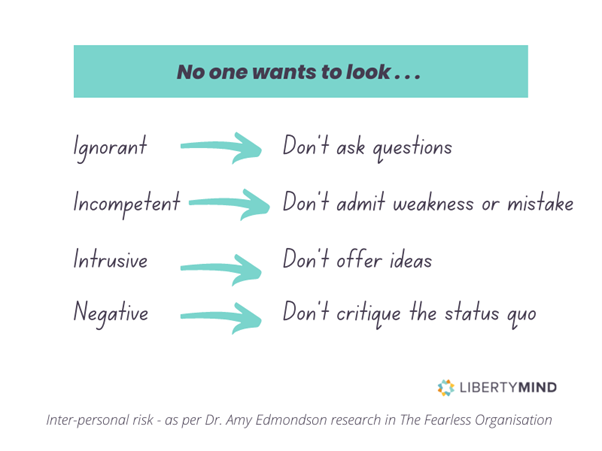
Best Performance Requires Psychological Safety
What causes a worker to be content and effective at work?
Role independence? Yes. Sense of direction? Most likely.
But what matters most are the interpersonal connections they make with their teammates and managers. Lack of business culture, lack of appreciation from coworkers and seniors, and unsatisfactory relationships with the boss and/or team are typically the most frequently mentioned reasons given by employees for quitting a job. In fact, managers “account for up to 70% of the variance in team engagement,” according to Gallup.
Furthermore, psychological safety is necessary for effective working relationships. In fact, psychological safety was “the most crucial dynamic in team effectiveness,” according to Google’s research on team dynamics.
The significant impact employee-manager dynamics have on employee experience is a given for many HR managers and leaders. But do we go far enough to maintain direct lines of communication between team members A and B?
How straightforward is it for teams to create their own system of psychological safety? Do the members of your team have colleagues they can talk to if they need to run ideas by someone or seek their opinion on a delicate business matter? Do people feel free to express their opinions and contribute their ideas at meetings without fear of being judged as “correct” or “wrong”? Is perseverance rewarded? And mistakes viewed as opportunities for learning?
These are the inquiries we should be asking ourselves to better understand the level of psychological security we should anticipate from our personnel. Consequently, how effectively we may predict their performance.
It’s important to note that providing psychological safety for your staff does not require you to be too sentimental. We shouldn’t try to shield our teams from controversy, risk, and failure by covering them in cotton wool.
Advantages Of Psychological Safety
Teams perform better in cultures where there is a higher level of psychological safety. Intuitively, this makes sense. You’ll almost surely waste time and effort attempting to seem like everything is fine if you don’t feel comfortable around your coworkers to ask questions, make errors, and learn from them.
A team’s or organization’s culture is supported by psychological safety so that members can:
• exchange information and knowledge;
• recommend organizational improvements;
• take the initiative to create new goods and services;
• draw lessons from their own and others’ errors.
Building A Culture Requires Time
According to Edmondson, psychological safety is a result of three things: mutual interpersonal trust, respect for one another’s knowledge, and concern for one another’s well-being.
For team members to feel comfortable speaking up, asking questions, and accepting responsibility, all three conditions must be met.
Developing psychological safety takes time. It requires persistence over time. Interpersonal trust is therefore a pipe dream if a leader declares that learning from mistakes is something to be valued but then criticizes someone who made a mistake.
Additionally, team members need to be respectful of one another’s abilities and treat one another with compassion. This indicates that psychological safety is unlikely to arise in situations when team members are competing with one another.
What About Accountability And Motivation?
Trust, respect, and care do not excuse us from being productive or from holding ourselves and others responsible for the decisions we make and the results we encounter.
To build a high-performance learning culture where employees are motivated, held accountable, and capable of doing their best work, our organization needs to address both of these dimensions (motivation and accountability as well as psychological safety). Anything less would be a disservice to both our organizations and our workforce.
Anxiety is likely to be produced in environments with strong drive and accountability but low levels of psychological safety, which tends to lower people’s performance. As anxiety increases in response to poor performance, the downward spiral that results can be quite dangerous.
Apathy is brought on by a lack of motivation, accountability, and psychological safety. People think there is no use in striving to do anything and that there are no negative repercussions for failing to produce. Additionally, there is probably little to no support for attempting novel approaches. That’s the ideal environment for passivity and disengagement to flourish.
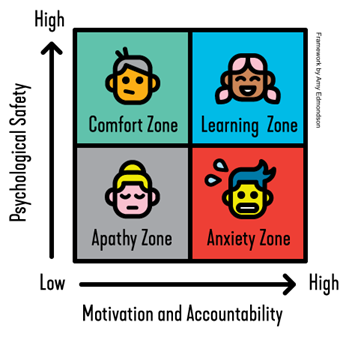
In contrast, comfort is produced in environments with great psychological safety and little motivation and accountability. Although everyone feels valued, respected, and cared for, there is little motivation to move things along. Given that employees enjoy the setting, get along with their coworkers, and feel appreciated at work, this scenario may perform pretty well on traditional workplace culture metrics. However, it doesn’t provide opportunity for people to grow, learn, and take on new challenges—all of which are fundamental to human flourishing.
Taking Lessons From Errors (A.K.A. Continuous Improvement)
Since perfection is impossible, we must acknowledge mistakes when they happen and foster a culture of learning that will allow us to identify methods to advance in the future. This necessitates a readiness to own up to errors and discuss honestly what went wrong and what needs to improve. And before we have those dialogues, we need to have high levels of psychological safety in place.
As you can see, fostering a climate of psychological safety does not lessen the significance of accountability and drive. Your motivation and willingness to hold yourself and others accountable will actually increase if you create a psychologically safe atmosphere. Likewise, it will affect the other members of your squad.
While acknowledging it’s hard to stay there permanently, your goal should be for you, your team, and your organization to spend as much time as possible in the learning zone. Changes in internal and external circumstances will impact how motivated, accountable, and psychologically safe people are. Recognizing when they have changed is crucial so that you may take strategic and tactical actions to turn things around. A little bit of preparation now will spare you hours of stress and misery when the unavoidable occurs!
Executive Summary
Chapter 1: The Importance
How Vital Is Psychological Safety?
Teams and organizations in the modern economy are looking for qualities like ideas, innovation, and creativity, which require the right system (environment) to spark. Talent attraction and retention are also crucial. Can a team that is extraordinarily bright, imaginative, and creative reach its full potential if they do not feel free to express their opinions? With a few lone geniuses (bosses), you might be able to get some results in a command and control structure, but these outcomes are not long-lasting.
Okay, so not every idea is a game-changer. Yes, there are questions that are foolish. Yes, disagreement can make things take longer (again). However, discussing these issues is a crucial step in the creative process.
Taking a chance around your team mates may sound easy, as Google’s research noted. However, a simple query like “what is the purpose of this project?” could give the impression that you are unaware of the situation. To avoid appearing ignorant, it could be simpler to carry on without seeking clarification.
Taking a chance in front of your team members could seem easy. However, a simple query like “what is the purpose of this project?” could give the impression that you are unaware of the situation. To avoid appearing ignorant, it could be simpler to keep going without seeking clarification.
In addition to supporting innovation, workplaces where psychological safety is a core component of the culture and system also promote a more positive, productive, and creative environment.
We need to decentralize decisions and ideas more than ever in a VUCA/BANI society. Teams require freedom to come up with ideas based on the environment they are working in. Failure is a necessary component of innovation, thus people must feel free to attempt new things without worrying about being fired or subjected to other negative consequences if their experiments do not turn out as planned.
Organizations will lag behind the competition if they continue to think that only leaders can come up with ideas or recognize dangers and possibilities. And here is one of the main advantages of having a psychologically secure workplace: People who do not hesitate to speak up, share their opinions, or ask questions serve as the organization’s sensors since everyone is present and aware of what is actually happening.
Where are the advancements, innovations, dangers, and chances? These inquiries are not delegated to executives or leadership. Everyone in the system should be concerned with these issues.
What Advantages Does Psychological Safety Offer?
The NHS National Workforce Skills Development Unit has named psychological safety as one of five interrelated pillars for building a healthy workplace.
Good psychological safety fosters flexible thinking and intrapreneurship within workforces, according to PwC research.
This conclusion is supported by MIT professors Warren Bennis and Edgar Schein, who believe it is a crucial element for empowering individuals to more effectively change their behavior in response to evolving organizational difficulties.
Over a two-year period, Google examined 250 qualities and the dynamics of more than 180 active teams. The results showed that all of the top-performing teams shared a high level of psychological safety.
Organizations that foster psychological safety benefit from things like: improved employee wellbeing, engagement, and problem-solving skills; increased collaboration and knowledge sharing; stronger workplace diversity and inclusion; lower employee turnover; higher-performing teams; and employees who are more change-resistant.
Silence can appear to be the safest course of action in situations where there seems to be a threat. Organizations lose out on chances for short successes and minor learning because of this silence.

Chapter 2: Measuring Safety
How can psychological safety at work be measured?
When assessing the psychological safety of an organization, those in HR roles or people analytics teams should make sure they have the necessary training and abilities to adopt a data-driven, business-focused, and experience-led approach.
Maintaining awareness of the psychological safety of your job is the first requirement. Before meetings, conduct check-ins. If a new dynamic occurs, such as the promotion of an ineffective leader, a change in teams, or the hiring of a toxic new employee, psychological safety may be quickly lost. You’ll stay informed if you send out pulse surveys with crucial questions.
Ask your team members and staff the challenging questions. Utilize surveys to gather and analyze data. The level of psychological safety at your company will be determined by the answers provided by your employees. Some things to ask include:
• Do they believe that their mistakes are held against them? If the answer is yes—whether the mistake is large or small—there is a chance that their psychological safety is not good. In this situation, analyzing performance reports can also provide you with a clear picture of how errors are handled.
• Are there instances where team members undermine or sabotage one another? If you discover that multiple people are criticizing bad teamwork, your psychological safety may be in danger.
• Do they feel confident asking for assistance when they need it? If not, they could be less likely to do so, which could hurt productivity. Examine failed projects to determine if a lack of support was a contributing factor.
Also keep in mind that even in psychological safety surveys, they might be afraid to speak up for fear of being punished. Again, in this situation, executives must set the example and demonstrate the safety of sharing knowledge that may help the organization better.
Looking at the variations inside the organization is something else you might want to think about. This has great significance and can provide more insight than surveys alone. investigating the reasons why certain sales teams are more successful than others. Could it be that their psychological safety is stronger? If so, it might be a good idea to change the way they operate.
Remember that you can’t quantify success that you didn’t experience. If you didn’t put all of your effort into establishing psychological safety in your organization, it will be challenging to measure it at first.

Chapter 3: Inclusion Safety
Diversity Is Not Possible Without Inclusion
Think about throwing a dinner party.
Each visitor has a unique set of preferences. While some people are vegans, others are vegetarians. Some people can’t have gluten, while others can’t stand eggs.
You have a fixed menu, which is the issue. You have even accidentally alienated half of your visitors.
The following time you hosted a meal, you made a few adjustments after realizing the issue. and the week after that. and the following week. Until you eventually come up with a menu that each visitor can eat and appreciate.
Diversity has been invited to dinner. Making sure everyone enjoys the food is being inclusive.
Simply fostering a varied workplace culture is significantly different from fostering an inclusive workplace culture.
A diverse workforce entails having a headcount of people of different sexes, races, and sexual orientations just for marketing purposes.
An inclusive corporate culture, on the other hand, sets itself apart from any potential unconscious bias in the workplace. No matter who they are or how they identify themselves, employees feel accepted.
Gain from establishing a truly welcoming safe space
There are many advantages to making the workplace truly safe for everyone:
• Encourage employees to express their opinions.
Teams are better equipped to capitalize on the skills and abilities that each member brings to the table when they feel free to openly discuss their ideas with one another, especially when those perspectives differ from the rest of the group. These groups are more likely to take the initiative and think critically about every circumstance. The team is then able to innovate and come up with workable ideas as a result.
• Establish a solid culture of feedback.
In order for a team to be able to give and receive direct, respectful feedback, psychological safety is also essential. As a result, if your company wants to develop a stronger feedback culture, start by looking at how employees perceive their psychological safety.
True psychological safety in the workplace—which Edmondson defines as “a confidence that one would not be punished or humiliated for coming out with ideas, questions, worries, or mistakes”—is more important than ever in these times of great complexity and uncertainty.
• Make allies who can stop damage from happening.
The unfortunate truth is that when harm is occurring, a privileged individual—often a leader or manager—has neglected to intervene. In other words, there has been an ally there, but they have not acted to defend the victim.
Undoubtedly, we would all want to avoid conflict at work. We may combat harm in the workplace and support cultures of inclusion, belonging, and psychological safety, however, if we are able to “call in” or “call out” bias by arming ourselves with timely expressions and intentional language.
In business, we are all role models. It is crucial to make sure that everyone can show up to work as their actual honest self if you are close to power and privilege. No one individual can build a brave, inclusive safe space; it takes all of us to level the playing field. The moment has come for leaders to make a commitment to holding individuals accountable and, most crucially, to stop harm when they witness it. Without allies, the situation can only be improved so much, and worker safety will never fully be achieved.
• Relieve persons belonging to underrepresented groups of the pressure to integrate or code-switch
Many people who identify as members of underrepresented groups may experience satisfaction at finally feeling secure enough to be themselves in their own space as a result of this.
In addition, they won’t have to put on a passive voice all day to avoid being labelled “aggressive” or pretend to be happy even when they’re not in order to avoid avoiding curious hands seeking to inspect a new hairstyle.
Therefore, it should come as no surprise that 97% of Black workers said they preferred to continue working remotely or in a hybrid model in the future, according to study by Future Forum. Additionally, only 3% of Black employees indicated that they were eager to return to their jobs on a full-time basis, compared to 21% of white employees.
All of this teaches business leaders a crucial lesson. The pressure many Black or ethnic minority persons feel to code-switch or assimilate has been reduced by remote working, which has created a secure zone where many people feel they can be themselves.
The truth is that many people go to work dreading the repercussions because our systems were not designed with underrepresented groups in mind. It is hard and constricting to hide your individuality, distinctiveness, history, and voice.

Chapter 4: Learner Safety
The second stage of the four stages of psychological safety is learner safety.
The underlying human desire to learn and develop is satisfied by learner safety. It enables us to feel secure while we participate in all parts of the learning process, including asking questions, providing and receiving feedback, experimenting, and even making mistakes—not if, but when—we do. To some extent, the learning process involves inhibition and anxiety from all of us. Everybody has insecurities. Who hasn’t been afraid of appearing foolish when raising their hand to ask a question in front of a group? Learning involves both mental and emotional processes. It involves the interaction of the heart and the head. We are more inclined to take chances, be vulnerable, and acquire resilience when we feel that the learners are safe. In contrast, a lack of learner safety sets off the instinct to self-censor, which makes us shut down, retrench, and control personal risk. We encourage others to learn in exchange for their readiness to learn when we build learner safety for them.
If a coworker begins speaking on a subject in a meeting that you are unfamiliar with, you would feel safe and at ease raising your hand to ask questions, seek clarification, and gain understanding. You would be reluctant to ask questions and might not even seek explanation in a company that does not prioritize learner safety, which would undermine the team’s best efforts.
The risks of participating in the learning process exceed the advantages if learner safety is not in place, quickly snuffing out any potential you may have once had.
The other three psychological safety quadrants of collaboration, challenge, and inclusion will become simpler for you as you gain more learner safety, raising your overall psychological safety to new heights.
So, get the conversation going. How do you plan to define yourself in terms of learner safety? How will you improve the environment’s ability to protect students? What steps can your company take to promote learner safety?

Chapter 5: Contributor Safety
Giving someone permission to contribute is a form of contributor safety. The person is now prepared to assume responsibility after learning about other people’s interests and having their abilities evaluated. Dr. Clark defines contributor safety as autonomy with direction in exchange for outcomes. Additionally, it is a process of fostering awareness and respect for each team member’s vulnerability. According to Patrick Lencioni, lack of trust is the primary indicator of a dysfunctional team and is the ultimate currency in team formation.
“If you get all the people in an organization rowing in the same direction, you could dominate any industry, in any market, against any competition, at any time.” — Patrick Lencioni
Don’t think that your team will immediately offer assistance or contribute to the team. Leaders may do the following to foster contributor safety:
• establish recurring touchpoints for people to provide and receive feedback
• Ask them directly and often to bring up any issues with their assignments.
• adapting the archaic notion of a suggestion box or setting up a channel where people can report threats and damaged things.
• Encourage others to share unfavorable news
Leaders must react with extreme caution. People listen for voices, micro-emotions, and faces to determine whether it is safe to contribute. One of the keys to establishing trust is anticipating how others will respond. Due to the fact that you cannot trust someone whose actions you cannot foresee. When someone is knowledgeable on how to create a trustworthy environment, they can encourage one.
This does not imply that in times of crisis, leaders should be aware of disappointments and frustrations. A managed crisis might actually strengthen a team. It is a chance for collaboration and shared vulnerability. When a team can overcome obstacles collectively, they begin to become more conscious of how each member responds under pressure. They are better able to position themselves strategically when trying to avoid or press each other’s buttons as a result of being able to recognize their unique emotional triggers.
You don’t gain someone’s trust by being vulnerable. Being open and vulnerable fosters trust. Being open and vulnerable with one another fosters intimacy.
Accountability must go hand in hand with psychological safety. Giving someone responsibility involves trust, which takes time and work. A gradual buildup of confidence necessitates various degrees of accountability. These are what Dr. Clark defines as:
• Level 1: Task
• Level 2: Process
• Level 3: Outcome
These thresholds specify the amount of risk that a person may accept from the management. The management can promote them to the next level if he continuously displays good performance at that level.
One can advance to the next level, for instance, when an employee has proven their capacity to pick up new material quickly and complete tasks with respectable outcomes. The employee can be eligible for process-level tasks and subsequently graduated to outcome-level accountability when he feels confident if he is prepared to put in extra effort and can work unsupervised.
The “how” he solved the problem doesn’t matter as much under outcome-level accountability because it’s the result that counts. This is the change from a managerial to an individual contributor job.
The most effective method to gain trust is to show it. The more exposed we are, the greater the potential reward. Vulnerability combined with responsibility fosters high levels of commitment to the common objective and encourages people to take calculated risks.

Chapter 6: Challenger Safety
What would the world be like if there was never any disagreement? What if the present order was never questioned? Imagine that world or that version of us is so challenging. Without the wheel, science would have made only modest progress. Electricity? No. organizations like Apple, Microsoft, Tesla, NASA, and the Red Cross that advanced humanity? Nada. Forget about the discovery of America or globalization. We would still be riding horses, if you think about transportation, but then even the first person to mount a horse would have been defying the current quo! We are constrained because we lack the freedom to disagree or attempt something new. Without the ability to challenge, we cannot advance.
Challenger safety is the ability to challenge the status quo in an organization without fear of retaliation or consequences. When something has to change and the time has come to say it, it can be a powerful tool. If you have the freedom to disagree, you speak up if you have challenger safety. You attract inspiration when you freely communicate your ideas; you reveal issues and find answers.
Progress is hampered in the absence of challenger safety. Despite what your instincts may be telling you or what inspiration you have struck, talking in ways that support the status quo destroys your capacity to uniquely contribute.
Increasing your challenger safety, one of the four distinct yet connected quadrants of psychological safety, will give you the foundation and the resources you need to also raise the inclusion, challenger, and learner safety of your environment. So, get the conversation going. Develop the ability to quickly advance a team or project by challenging the current quo. What are three things you can do in your environment to promote challenger safety?

Chapter 7: Fear
Learning about fear is a necessary component of learning about courage. Fear and courage are closely related and intertwined. Most of the time, when we choose to act bravely, we are choosing to confront our fear. And we should participate. Fear has the greatest erasing impact on performance of any other emotion. Despite this, workplace environments are thriving with dread.
The workplace is one of the most frightening places, and leaders’ actions are one of the most powerful generators of terror. Inflaming people’s concerns in order to accomplish goals reinforces the traditional hierarchical concept of authority and obedience. Many workplaces still employ words like “superior” and “subordinate” in the twenty-first century. If you take a moment to consider what you mean when you refer to your boss as your “superior,” what does it make you? Inferior?
Fear Affects Performance
Sadly, leaders frequently utilize fear to persuade individuals to take action in many companies. But fear permeates the entire organizational structure and is not only restricted to the actions of leaders. The majority of performance appraisal systems are unidirectional, cascading downward in a straight line, and are frequently more concerned with monitoring performance than they are with improving it. Time reporting systems make sure that every worker’s precise activities are monitored and recorded. To track employee emails and Internet usage, complex and expensive software systems are put in place. Additionally, workers may be subject to random drug testing at their places of employment.
Regardless of how justified such systems may be, taken as a whole, they send the workforce two very strong messages:
1. You are being observed.
2. No one trusts you.
The distrust and unease brought on by this lack of trust, when permeated across the entire workplace, might result in a fear-based organization.
Fear Can Hurt Your Business
Despite being a common motivator, fear is detrimental to business. While fear may spur employees to work harder, faster, or longer for a while, it also prevents them from being willing to take the risks that, for instance, are required for innovation, new product development, and sales. Fear makes people clam up, which stops the flow of feedback that is so important for preventing leaders from making poor judgments. On a bigger scale, fear creates barriers between firm divisions and motivates employees to hoard knowledge in an effort to prevent their divisions from losing—often under the pretense of “healthy” internal rivalry. Incidentally, it’s not very enjoyable to operate in frightening situations.
If the complete costs of fear could be calculated, they would be so prohibitive that any organization with a clear sense of morality would rule it out as a performance-enhancing tactic.
Does fear rule the workplace there? What procedures or policies may be causing employees to feel uneasy, afraid, or unsafe? What about your manager? Does he or she act in a fearful manner? Which ways? What concerns YOU, more importantly? Are you fostering a workplace where employees feel secure on a physical, emotional, and psychological level?

Chapter 8: No-Blame Culture
What Is A Culture Of No Blame?
No-blame environments welcome the potential of mistakes and promote their reporting.
They are supported by the idea that mistakes are part of how organizations operate. Errors, or flaws that could lead to errors, are handled as systemic problems (as opposed to individual faults) and dealt with as such.
Speaking up about mistakes is a vital responsibility of every employee in no blame cultures. Although no-blame cultures can exist in highly hierarchical, flat, and everything in between organizations, the obligation to speak up cuts across all levels of organization.
This is how a no-blame culture was traditionally understood, albeit it has since changed. The more contemporary iteration emphasizes encouraging experimentation rather than learning from mistakes. The negative effects of experimenting do not personally affect employees (such as failure).
What Causes No-Blame Cultures?
No-blame cultures first appear in workplaces where even the smallest mistakes can have disastrous results. Hospitals, submarines, and airlines are examples of what are referred to be high reliability organizations (HROs).
It is risky to operate in an environment where employees don’t feel comfortable reporting mistakes that have been made or raising concerns about shortcomings that could lead to future mistakes because errors can be so disastrous in these organizations.
No-blame cultures accept the possibility of mistakes and promote reporting of them.
In order to ensure that faults and shortcomings were pointed out by employees as soon as possible, no blame cultures were adopted. Although it has happened in other businesses as well, the aviation sector is the one that gets mentioned the most.
The National Transportation Safety Board (NTSB), which regulates air travel throughout the US, now bases its decisions on the idea that mistakes are inherent in human behavior rather than directly related to subpar performance.
What Traits Define Cultures That Don’t Place Blame?
No-blame cultures are frequently influenced by particular organizational traits, such as:
• A common understanding of complexity: Sadly, people tend to blame individuals for mistakes even when systemic causes are to blame. Employees in no-blame cultures are given time and resources to ensure they comprehend how complex organizations are so they can more accurately attribute errors to systemic causes.
• Respect for other people: Employees in air traffic control organizations are exposed to the pressures and issues that their coworkers face on the job. When something goes wrong, everyone is more likely to comprehend why it did so than to place the blame on subpar performance.
• Confidence in integrity: Integrity is the lubricant that keeps high dependability organizations running smoothly. Without honesty, organizations lack a true picture of their situation and are unable to take wise and successful decisions. Because of this, no-blame societies value and reward sincerity.
• Debriefings are frequently used: The ability to critically analyze, disassemble, and reassemble systems in more effective ways is critical to the success of no blame cultures. Debriefs make sure that everyone is on the same page, help identify what went wrong and what should be altered going forward.
• Respect for knowledge: In typical organizations, operational decisions typically follow the organizational structure. Despite being frequently in a better position to make wise selections than subject matter specialists. The hierarchy in no-blame cultures is loose enough for experts to take charge of operational matters as necessary.
• A focus on behavioral expectations: In a world where there are more variables at play, getting results becomes more challenging. Therefore, it may be unjust to judge people based on their actions. While evaluating people based on their behavior promotes congruence with the organization’s ideals
• A realistic perception of people: Setting high expectations for others might boost performance. Organizations shouldn’t, however, overlook human limitations (such as the fact that people occasionally have “off days”). People are not supposed to be superhumans, and no-blame societies are based on this understanding. Instead, individuals are urged to view themselves as flawed but important components of a larger system.

Chapter 9: Failure
Many businesses and employees still associate failure with something to be avoided at all costs. Failure can cost you money and hurt you in the short term. But being afraid of failure or avoiding it is not a good thing.
Failure has a connotation, but if you can get over that, you’ll see that making mistakes has always been a given in life. Moreover, they serve as stepping stones for achievement. In actuality, failure is often credited with the creation of breakthroughs and discoveries. For instance, blunders and trial-and-error led to the development of penicillin, pacemakers, and post-it notes.
Failure may be avoided, feared, and punished, which is bad for both your business and people. If you demand perfection from your staff members, they will feel greater pressure and be less willing to attempt new things. That may hinder innovation and creativity.
So, let failure happen at work. Give your staff a secure environment where they can experiment, err, and learn. There are numerous justifications for doing so.
Why is it necessary to accept failure?
1) Promotes candor and openness
Leaders and staff are more inclined to freely acknowledge their errors if you create a culture that accepts failure rather than brushing them under the rug. You must, however, refrain from assigning blame. Employees may be discouraged from sharing their errors freely if there is a culture of finger-pointing. However, by normalizing failure, you incentivize staff members to discuss their errors with supervisors and fellow workers. It also motivates them to talk about lessons learnt and come up with strategies to fix those errors.
2) Lessens strain and stress on workers
By emphasizing to your staff that failure is acceptable, you take some of the burden off on them. As a result, individuals experience reduced anxiety and stress and increase their level of engagement at work, which increases productivity.
3) Encourages teamwork and learning
Your leaders, managers, and staff may learn what works and what doesn’t by being given the freedom to make mistakes. This promotes a culture of ongoing learning and development, laying the groundwork for your business’s success in the future. Additionally, allowing teams and employees to experiment with diverse ideas and learn from mistakes promotes teamwork as they unite around common objectives.
4) Promotes innovation and creativity
Giving your staff a safe environment to experiment and fail enables them to grow and learn. Additionally, it makes it more likely that new problems will be identified and their innovative solutions will be found. This then sparks crucial innovation, which can significantly boost your company’s competitive advantage.

Chapter 10: Manager’s Role
Simply put, psychological safety at work is the conviction that you may take chances around your coworkers and express your opinions without fear. Employees are empowered to be themselves and offer novel and unconventional ideas when they feel psychologically safe doing so. But in the absence of psychological safety, fight-or-flight reactions frequently take over higher brain activities. Analytical thinking and perspective are diverted. Instead, pressure from a boss, a rival coworker, or a disrespectful subordinate is perceived as a threat rather than just a job challenge by the employee. Team members start to concentrate on the possible drawbacks of attempting novel things.
In addition to job expertise, feedback, resources, beneficial relationships, and incentives, a supportive work environment—particularly psychological safety—is crucial for motivating high performance and engagement. The trust, inclusion, belonging, curiosity, confidence, and inspiration that come from a positive mental and emotional state allow workers to be more resilient, driven, persistent, and at ease bringing their complete selves to work.
Managers are responsible for fostering a culture of psychological safety for their teams, even though leaders can set the tone for this at the highest levels of a company. Employees are more likely to speak up, participate, and experiment when they feel psychologically comfortable at work, which eventually leads to stronger engagement and better performance. This is advantageous for the health and morale of employees as well as for the success of the company because highly engaged teams are known to produce positive business results.
Here are some ideas for managers to consider in order to foster a climate of psychological safety:
• Establish a culture of trust by practicing deep respect,
• embracing conflict consciously,
• avoiding blame and criticism,
• modeling curiosity,
• and celebrating taking risks and occasional failures.
Recognize what makes employees fearful of interpersonal risk-taking and do something about it.
The first step in overcoming concerns and creating a culture of psychological safety is to have an understanding of business culture, including when people feel afraid or empowered. Respect, a thoughtful response to dispute, a focus on solutions, and the celebration of risk and failure all contribute to the development of a culture of trust. This takes vulnerability on the part of the leadership level. Managers will ultimately promote participation throughout the company when they establish psychological safety and serve as role models for the actions necessary for its success. The fear of retaliation will eventually give way to increased trust, openness, sharing of ideas, original problem-solving, and creative solutions.

Chapter 11: Hybrid Workplaces
When Working Virtually, What Does Psychological Safety Mean?
The promotion of psychological safety may initially appear to be more difficult when employees are not all based in one location and frequently work from home. After all, how can trust be built when face-to-face interactions must be planned in advance and executed via a screen?
If team members are paying attention, the work-from-home reality that has emerged in the wake of the epidemic may present a special chance to build relationships and boost psychological safety.
When comparing a videoconference call to a typical in-person chat, you have the capacity to gaze carefully at people, not just listening to their words, but seeing and feeling their emotions.
Staring at someone for more than a few seconds at a time can be uncomfortable in many cultures. On Zoom, though, no one can see what you’re looking at, which can occasionally improve your capacity to use emotional intelligence.
Team members must have the bravery to be vulnerable in order to maintain psychological safety at work, and virtual work environments provide that possibility.
Using a computer, you can type more vulnerable statements in chat, spend a little more time considering how you want to convey it, and gauge the impact on others through their comments in response. Perhaps you find it difficult to express vulnerability in person, but you can do so when using a computer. Examine the value of listening as a tool for true conversation in a virtual environment.
Keep in mind that the objective is to foster a work environment where team members may express themselves without fear of being ignored. In that circumstance, team members are more flexible in the face of change and interpersonal risk-taking also becomes the norm.
In other words, they are aware of the possibilities and difficulties faced by the entire organization and recognize how they can improve it.

Chapter 12: Leadership Development
How Can You Lead in a Safe Psychological Environment?
“The shared belief among team members that the team is safe for interpersonal risk-taking” – Amy Edmonson, professor at the Harvard Business School
Setting up a psychologically safe atmosphere does not excuse you from pushing your team members accountable. In her book “The Fearless Organization,” Anne Edmonson established the framework for psychological safety.
The teams that do the best won’t be in the psychologically safe but low-accountability zone of comfort. And it is obvious that anxiety results from having great accountability but poor psychological safety.
A well performing team should have a good balance of psychological safety and accountability.
Your Personal Assessment of Psychological Safety
These are the main qualities a leader needs to cultivate in order to create a psychologically secure team. How many of these do you regularly practice?
1. A mindset of curiosity and growth
Do you possess a growth mentality or an attitude of openness to learning? a spirit of curiosity and lifelong learning to encourage experimentation and taking risks.
The Growth Tribe is successful because it encourages everyone to follow their own curiosity and experiment in a secure environment.
How can you help your team members foster curiosity and a growth mindset?
2. Listen attentively without bias.
How well can you pay attention? Are you paying attention to what your team has to say. A crucial leadership competency is active listening.
Building psychological safety requires cultivating a reputation as a patient listener who can be counted on to maintain confidentiality and who sets clear norms of conduct.
Refrain from the urge to get right in and remedy issues. Give your employees the freedom to consider their own problems and develop their own answers. They will become more assured and trusting of both you and themselves as a result.
3. Exhibit Transparency and Vulnerability
You, I, and everyone else are constantly works in progress. When was the last time you, as a leader, promoted transparency and vulnerability?
The leaders who own up to their mistakes are the ones who are most respected. As a result of your openness and authenticity as a leader, your team will be more inclined to experiment, identify problems early, and place less responsibility on others when anything goes wrong.
Mishaps will occur. However, a team that is psychologically secure and eager to acknowledge and learn from its errors will be to your advantage.
4. Watch, Assess, and Give Feedback
Without measuring and monitoring, all of this is theoretical. How frequently do you rate the psychological safety of your team?
Include inquiries like, “How sure are you that you won’t be punished in your end-of-year review if you express a concern?” in anonymous staff surveys.
You can’t manage what you don’t measure, just like anything else in life. Data is the king.
Curriculum
Team Accountability – Workshop 3 – Psychological Safety
- The Importance
- Measuring Safety
- Inclusion Safety
- Learner Safety
- Contributor Safety
- Challenger Safety
- Fear
- No-Blame Culture
- Failure
- Manager’s Role
- Hybrid Workplaces
- Leadership Development
Distance Learning
Introduction
Welcome to Appleton Greene and thank you for enrolling on the Team Accountability corporate training program. You will be learning through our unique facilitation via distance-learning method, which will enable you to practically implement everything that you learn academically. The methods and materials used in your program have been designed and developed to ensure that you derive the maximum benefits and enjoyment possible. We hope that you find the program challenging and fun to do. However, if you have never been a distance-learner before, you may be experiencing some trepidation at the task before you. So we will get you started by giving you some basic information and guidance on how you can make the best use of the modules, how you should manage the materials and what you should be doing as you work through them. This guide is designed to point you in the right direction and help you to become an effective distance-learner. Take a few hours or so to study this guide and your guide to tutorial support for students, while making notes, before you start to study in earnest.
Study environment
You will need to locate a quiet and private place to study, preferably a room where you can easily be isolated from external disturbances or distractions. Make sure the room is well-lit and incorporates a relaxed, pleasant feel. If you can spoil yourself within your study environment, you will have much more of a chance to ensure that you are always in the right frame of mind when you do devote time to study. For example, a nice fire, the ability to play soft soothing background music, soft but effective lighting, perhaps a nice view if possible and a good size desk with a comfortable chair. Make sure that your family know when you are studying and understand your study rules. Your study environment is very important. The ideal situation, if at all possible, is to have a separate study, which can be devoted to you. If this is not possible then you will need to pay a lot more attention to developing and managing your study schedule, because it will affect other people as well as yourself. The better your study environment, the more productive you will be.
Study tools & rules
Try and make sure that your study tools are sufficient and in good working order. You will need to have access to a computer, scanner and printer, with access to the internet. You will need a very comfortable chair, which supports your lower back, and you will need a good filing system. It can be very frustrating if you are spending valuable study time trying to fix study tools that are unreliable, or unsuitable for the task. Make sure that your study tools are up to date. You will also need to consider some study rules. Some of these rules will apply to you and will be intended to help you to be more disciplined about when and how you study. This distance-learning guide will help you and after you have read it you can put some thought into what your study rules should be. You will also need to negotiate some study rules for your family, friends or anyone who lives with you. They too will need to be disciplined in order to ensure that they can support you while you study. It is important to ensure that your family and friends are an integral part of your study team. Having their support and encouragement can prove to be a crucial contribution to your successful completion of the program. Involve them in as much as you can.
Successful distance-learning
Distance-learners are freed from the necessity of attending regular classes or workshops, since they can study in their own way, at their own pace and for their own purposes. But unlike traditional internal training courses, it is the student’s responsibility, with a distance-learning program, to ensure that they manage their own study contribution. This requires strong self-discipline and self-motivation skills and there must be a clear will to succeed. Those students who are used to managing themselves, are good at managing others and who enjoy working in isolation, are more likely to be good distance-learners. It is also important to be aware of the main reasons why you are studying and of the main objectives that you are hoping to achieve as a result. You will need to remind yourself of these objectives at times when you need to motivate yourself. Never lose sight of your long-term goals and your short-term objectives. There is nobody available here to pamper you, or to look after you, or to spoon-feed you with information, so you will need to find ways to encourage and appreciate yourself while you are studying. Make sure that you chart your study progress, so that you can be sure of your achievements and re-evaluate your goals and objectives regularly.
Self-assessment
Appleton Greene training programs are in all cases post-graduate programs. Consequently, you should already have obtained a business-related degree and be an experienced learner. You should therefore already be aware of your study strengths and weaknesses. For example, which time of the day are you at your most productive? Are you a lark or an owl? What study methods do you respond to the most? Are you a consistent learner? How do you discipline yourself? How do you ensure that you enjoy yourself while studying? It is important to understand yourself as a learner and so some self-assessment early on will be necessary if you are to apply yourself correctly. Perform a SWOT analysis on yourself as a student. List your internal strengths and weaknesses as a student and your external opportunities and threats. This will help you later on when you are creating a study plan. You can then incorporate features within your study plan that can ensure that you are playing to your strengths, while compensating for your weaknesses. You can also ensure that you make the most of your opportunities, while avoiding the potential threats to your success.
Accepting responsibility as a student
Training programs invariably require a significant investment, both in terms of what they cost and in the time that you need to contribute to study and the responsibility for successful completion of training programs rests entirely with the student. This is never more apparent than when a student is learning via distance-learning. Accepting responsibility as a student is an important step towards ensuring that you can successfully complete your training program. It is easy to instantly blame other people or factors when things go wrong. But the fact of the matter is that if a failure is your failure, then you have the power to do something about it, it is entirely in your own hands. If it is always someone else’s failure, then you are powerless to do anything about it. All students study in entirely different ways, this is because we are all individuals and what is right for one student, is not necessarily right for another. In order to succeed, you will have to accept personal responsibility for finding a way to plan, implement and manage a personal study plan that works for you. If you do not succeed, you only have yourself to blame.
Planning
By far the most critical contribution to stress, is the feeling of not being in control. In the absence of planning we tend to be reactive and can stumble from pillar to post in the hope that things will turn out fine in the end. Invariably they don’t! In order to be in control, we need to have firm ideas about how and when we want to do things. We also need to consider as many possible eventualities as we can, so that we are prepared for them when they happen. Prescriptive Change, is far easier to manage and control, than Emergent Change. The same is true with distance-learning. It is much easier and much more enjoyable, if you feel that you are in control and that things are going to plan. Even when things do go wrong, you are prepared for them and can act accordingly without any unnecessary stress. It is important therefore that you do take time to plan your studies properly.
Management
Once you have developed a clear study plan, it is of equal importance to ensure that you manage the implementation of it. Most of us usually enjoy planning, but it is usually during implementation when things go wrong. Targets are not met and we do not understand why. Sometimes we do not even know if targets are being met. It is not enough for us to conclude that the study plan just failed. If it is failing, you will need to understand what you can do about it. Similarly if your study plan is succeeding, it is still important to understand why, so that you can improve upon your success. You therefore need to have guidelines for self-assessment so that you can be consistent with performance improvement throughout the program. If you manage things correctly, then your performance should constantly improve throughout the program.
Study objectives & tasks
The first place to start is developing your program objectives. These should feature your reasons for undertaking the training program in order of priority. Keep them succinct and to the point in order to avoid confusion. Do not just write the first things that come into your head because they are likely to be too similar to each other. Make a list of possible departmental headings, such as: Customer Service; E-business; Finance; Globalization; Human Resources; Technology; Legal; Management; Marketing and Production. Then brainstorm for ideas by listing as many things that you want to achieve under each heading and later re-arrange these things in order of priority. Finally, select the top item from each department heading and choose these as your program objectives. Try and restrict yourself to five because it will enable you to focus clearly. It is likely that the other things that you listed will be achieved if each of the top objectives are achieved. If this does not prove to be the case, then simply work through the process again.
Study forecast
As a guide, the Appleton Greene Team Accountability corporate training program should take 12-18 months to complete, depending upon your availability and current commitments. The reason why there is such a variance in time estimates is because every student is an individual, with differing productivity levels and different commitments. These differentiations are then exaggerated by the fact that this is a distance-learning program, which incorporates the practical integration of academic theory as an as a part of the training program. Consequently all of the project studies are real, which means that important decisions and compromises need to be made. You will want to get things right and will need to be patient with your expectations in order to ensure that they are. We would always recommend that you are prudent with your own task and time forecasts, but you still need to develop them and have a clear indication of what are realistic expectations in your case. With reference to your time planning: consider the time that you can realistically dedicate towards study with the program every week; calculate how long it should take you to complete the program, using the guidelines featured here; then break the program down into logical modules and allocate a suitable proportion of time to each of them, these will be your milestones; you can create a time plan by using a spreadsheet on your computer, or a personal organizer such as MS Outlook, you could also use a financial forecasting software; break your time forecasts down into manageable chunks of time, the more specific you can be, the more productive and accurate your time management will be; finally, use formulas where possible to do your time calculations for you, because this will help later on when your forecasts need to change in line with actual performance. With reference to your task planning: refer to your list of tasks that need to be undertaken in order to achieve your program objectives; with reference to your time plan, calculate when each task should be implemented; remember that you are not estimating when your objectives will be achieved, but when you will need to focus upon implementing the corresponding tasks; you also need to ensure that each task is implemented in conjunction with the associated training modules which are relevant; then break each single task down into a list of specific to do’s, say approximately ten to do’s for each task and enter these into your study plan; once again you could use MS Outlook to incorporate both your time and task planning and this could constitute your study plan; you could also use a project management software like MS Project. You should now have a clear and realistic forecast detailing when you can expect to be able to do something about undertaking the tasks to achieve your program objectives.
Performance management
It is one thing to develop your study forecast, it is quite another to monitor your progress. Ultimately it is less important whether you achieve your original study forecast and more important that you update it so that it constantly remains realistic in line with your performance. As you begin to work through the program, you will begin to have more of an idea about your own personal performance and productivity levels as a distance-learner. Once you have completed your first study module, you should re-evaluate your study forecast for both time and tasks, so that they reflect your actual performance level achieved. In order to achieve this you must first time yourself while training by using an alarm clock. Set the alarm for hourly intervals and make a note of how far you have come within that time. You can then make a note of your actual performance on your study plan and then compare your performance against your forecast. Then consider the reasons that have contributed towards your performance level, whether they are positive or negative and make a considered adjustment to your future forecasts as a result. Given time, you should start achieving your forecasts regularly.
With reference to time management: time yourself while you are studying and make a note of the actual time taken in your study plan; consider your successes with time-efficiency and the reasons for the success in each case and take this into consideration when reviewing future time planning; consider your failures with time-efficiency and the reasons for the failures in each case and take this into consideration when reviewing future time planning; re-evaluate your study forecast in relation to time planning for the remainder of your training program to ensure that you continue to be realistic about your time expectations. You need to be consistent with your time management, otherwise you will never complete your studies. This will either be because you are not contributing enough time to your studies, or you will become less efficient with the time that you do allocate to your studies. Remember, if you are not in control of your studies, they can just become yet another cause of stress for you.
With reference to your task management: time yourself while you are studying and make a note of the actual tasks that you have undertaken in your study plan; consider your successes with task-efficiency and the reasons for the success in each case; take this into consideration when reviewing future task planning; consider your failures with task-efficiency and the reasons for the failures in each case and take this into consideration when reviewing future task planning; re-evaluate your study forecast in relation to task planning for the remainder of your training program to ensure that you continue to be realistic about your task expectations. You need to be consistent with your task management, otherwise you will never know whether you are achieving your program objectives or not.
Keeping in touch
You will have access to qualified and experienced professors and tutors who are responsible for providing tutorial support for your particular training program. So don’t be shy about letting them know how you are getting on. We keep electronic records of all tutorial support emails so that professors and tutors can review previous correspondence before considering an individual response. It also means that there is a record of all communications between you and your professors and tutors and this helps to avoid any unnecessary duplication, misunderstanding, or misinterpretation. If you have a problem relating to the program, share it with them via email. It is likely that they have come across the same problem before and are usually able to make helpful suggestions and steer you in the right direction. To learn more about when and how to use tutorial support, please refer to the Tutorial Support section of this student information guide. This will help you to ensure that you are making the most of tutorial support that is available to you and will ultimately contribute towards your success and enjoyment with your training program.
Work colleagues and family
You should certainly discuss your program study progress with your colleagues, friends and your family. Appleton Greene training programs are very practical. They require you to seek information from other people, to plan, develop and implement processes with other people and to achieve feedback from other people in relation to viability and productivity. You will therefore have plenty of opportunities to test your ideas and enlist the views of others. People tend to be sympathetic towards distance-learners, so don’t bottle it all up in yourself. Get out there and share it! It is also likely that your family and colleagues are going to benefit from your labors with the program, so they are likely to be much more interested in being involved than you might think. Be bold about delegating work to those who might benefit themselves. This is a great way to achieve understanding and commitment from people who you may later rely upon for process implementation. Share your experiences with your friends and family.
Making it relevant
The key to successful learning is to make it relevant to your own individual circumstances. At all times you should be trying to make bridges between the content of the program and your own situation. Whether you achieve this through quiet reflection or through interactive discussion with your colleagues, client partners or your family, remember that it is the most important and rewarding aspect of translating your studies into real self-improvement. You should be clear about how you want the program to benefit you. This involves setting clear study objectives in relation to the content of the course in terms of understanding, concepts, completing research or reviewing activities and relating the content of the modules to your own situation. Your objectives may understandably change as you work through the program, in which case you should enter the revised objectives on your study plan so that you have a permanent reminder of what you are trying to achieve, when and why.
Distance-learning check-list
Prepare your study environment, your study tools and rules.
Undertake detailed self-assessment in terms of your ability as a learner.
Create a format for your study plan.
Consider your study objectives and tasks.
Create a study forecast.
Assess your study performance.
Re-evaluate your study forecast.
Be consistent when managing your study plan.
Use your Appleton Greene Certified Learning Provider (CLP) for tutorial support.
Make sure you keep in touch with those around you.

Tutorial Support
Programs
Appleton Greene uses standard and bespoke corporate training programs as vessels to transfer business process improvement knowledge into the heart of our clients’ organizations. Each individual program focuses upon the implementation of a specific business process, which enables clients to easily quantify their return on investment. There are hundreds of established Appleton Greene corporate training products now available to clients within customer services, e-business, finance, globalization, human resources, information technology, legal, management, marketing and production. It does not matter whether a client’s employees are located within one office, or an unlimited number of international offices, we can still bring them together to learn and implement specific business processes collectively. Our approach to global localization enables us to provide clients with a truly international service with that all important personal touch. Appleton Greene corporate training programs can be provided virtually or locally and they are all unique in that they individually focus upon a specific business function. They are implemented over a sustainable period of time and professional support is consistently provided by qualified learning providers and specialist consultants.
Support available
You will have a designated Certified Learning Provider (CLP) and an Accredited Consultant and we encourage you to communicate with them as much as possible. In all cases tutorial support is provided online because we can then keep a record of all communications to ensure that tutorial support remains consistent. You would also be forwarding your work to the tutorial support unit for evaluation and assessment. You will receive individual feedback on all of the work that you undertake on a one-to-one basis, together with specific recommendations for anything that may need to be changed in order to achieve a pass with merit or a pass with distinction and you then have as many opportunities as you may need to re-submit project studies until they meet with the required standard. Consequently the only reason that you should really fail (CLP) is if you do not do the work. It makes no difference to us whether a student takes 12 months or 18 months to complete the program, what matters is that in all cases the same quality standard will have been achieved.
Support Process
Please forward all of your future emails to the designated (CLP) Tutorial Support Unit email address that has been provided and please do not duplicate or copy your emails to other AGC email accounts as this will just cause unnecessary administration. Please note that emails are always answered as quickly as possible but you will need to allow a period of up to 20 business days for responses to general tutorial support emails during busy periods, because emails are answered strictly within the order in which they are received. You will also need to allow a period of up to 30 business days for the evaluation and assessment of project studies. This does not include weekends or public holidays. Please therefore kindly allow for this within your time planning. All communications are managed online via email because it enables tutorial service support managers to review other communications which have been received before responding and it ensures that there is a copy of all communications retained on file for future reference. All communications will be stored within your personal (CLP) study file here at Appleton Greene throughout your designated study period. If you need any assistance or clarification at any time, please do not hesitate to contact us by forwarding an email and remember that we are here to help. If you have any questions, please list and number your questions succinctly and you can then be sure of receiving specific answers to each and every query.
Time Management
It takes approximately 1 Year to complete the Team Accountability corporate training program, incorporating 12 x 6-hour monthly workshops. Each student will also need to contribute approximately 4 hours per week over 1 Year of their personal time. Students can study from home or work at their own pace and are responsible for managing their own study plan. There are no formal examinations and students are evaluated and assessed based upon their project study submissions, together with the quality of their internal analysis and supporting documents. They can contribute more time towards study when they have the time to do so and can contribute less time when they are busy. All students tend to be in full time employment while studying and the Team Accountability program is purposely designed to accommodate this, so there is plenty of flexibility in terms of time management. It makes no difference to us at Appleton Greene, whether individuals take 12-18 months to complete this program. What matters is that in all cases the same standard of quality will have been achieved with the standard and bespoke programs that have been developed.
Distance Learning Guide
The distance learning guide should be your first port of call when starting your training program. It will help you when you are planning how and when to study, how to create the right environment and how to establish the right frame of mind. If you can lay the foundations properly during the planning stage, then it will contribute to your enjoyment and productivity while training later. The guide helps to change your lifestyle in order to accommodate time for study and to cultivate good study habits. It helps you to chart your progress so that you can measure your performance and achieve your goals. It explains the tools that you will need for study and how to make them work. It also explains how to translate academic theory into practical reality. Spend some time now working through your distance learning guide and make sure that you have firm foundations in place so that you can make the most of your distance learning program. There is no requirement for you to attend training workshops or classes at Appleton Greene offices. The entire program is undertaken online, program course manuals and project studies are administered via the Appleton Greene web site and via email, so you are able to study at your own pace and in the comfort of your own home or office as long as you have a computer and access to the internet.
How To Study
The how to study guide provides students with a clear understanding of the Appleton Greene facilitation via distance learning training methods and enables students to obtain a clear overview of the training program content. It enables students to understand the step-by-step training methods used by Appleton Greene and how course manuals are integrated with project studies. It explains the research and development that is required and the need to provide evidence and references to support your statements. It also enables students to understand precisely what will be required of them in order to achieve a pass with merit and a pass with distinction for individual project studies and provides useful guidance on how to be innovative and creative when developing your Unique Program Proposition (UPP).
Tutorial Support
Tutorial support for the Appleton Greene Team Accountability corporate training program is provided online either through the Appleton Greene Client Support Portal (CSP), or via email. All tutorial support requests are facilitated by a designated Program Administration Manager (PAM). They are responsible for deciding which professor or tutor is the most appropriate option relating to the support required and then the tutorial support request is forwarded onto them. Once the professor or tutor has completed the tutorial support request and answered any questions that have been asked, this communication is then returned to the student via email by the designated Program Administration Manager (PAM). This enables all tutorial support, between students, professors and tutors, to be facilitated by the designated Program Administration Manager (PAM) efficiently and securely through the email account. You will therefore need to allow a period of up to 20 business days for responses to general support queries and up to 30 business days for the evaluation and assessment of project studies, because all tutorial support requests are answered strictly within the order in which they are received. This does not include weekends or public holidays. Consequently you need to put some thought into the management of your tutorial support procedure in order to ensure that your study plan is feasible and to obtain the maximum possible benefit from tutorial support during your period of study. Please retain copies of your tutorial support emails for future reference. Please ensure that ALL of your tutorial support emails are set out using the format as suggested within your guide to tutorial support. Your tutorial support emails need to be referenced clearly to the specific part of the course manual or project study which you are working on at any given time. You also need to list and number any questions that you would like to ask, up to a maximum of five questions within each tutorial support email. Remember the more specific you can be with your questions the more specific your answers will be too and this will help you to avoid any unnecessary misunderstanding, misinterpretation, or duplication. The guide to tutorial support is intended to help you to understand how and when to use support in order to ensure that you get the most out of your training program. Appleton Greene training programs are designed to enable you to do things for yourself. They provide you with a structure or a framework and we use tutorial support to facilitate students while they practically implement what they learn. In other words, we are enabling students to do things for themselves. The benefits of distance learning via facilitation are considerable and are much more sustainable in the long-term than traditional short-term knowledge sharing programs. Consequently you should learn how and when to use tutorial support so that you can maximize the benefits from your learning experience with Appleton Greene. This guide describes the purpose of each training function and how to use them and how to use tutorial support in relation to each aspect of the training program. It also provides useful tips and guidance with regard to best practice.
Tutorial Support Tips
Students are often unsure about how and when to use tutorial support with Appleton Greene. This Tip List will help you to understand more about how to achieve the most from using tutorial support. Refer to it regularly to ensure that you are continuing to use the service properly. Tutorial support is critical to the success of your training experience, but it is important to understand when and how to use it in order to maximize the benefit that you receive. It is no coincidence that those students who succeed are those that learn how to be positive, proactive and productive when using tutorial support.
Be positive and friendly with your tutorial support emails
Remember that if you forward an email to the tutorial support unit, you are dealing with real people. “Do unto others as you would expect others to do unto you”. If you are positive, complimentary and generally friendly in your emails, you will generate a similar response in return. This will be more enjoyable, productive and rewarding for you in the long-term.
Think about the impression that you want to create
Every time that you communicate, you create an impression, which can be either positive or negative, so put some thought into the impression that you want to create. Remember that copies of all tutorial support emails are stored electronically and tutors will always refer to prior correspondence before responding to any current emails. Over a period of time, a general opinion will be arrived at in relation to your character, attitude and ability. Try to manage your own frustrations, mood swings and temperament professionally, without involving the tutorial support team. Demonstrating frustration or a lack of patience is a weakness and will be interpreted as such. The good thing about communicating in writing, is that you will have the time to consider your content carefully, you can review it and proof-read it before sending your email to Appleton Greene and this should help you to communicate more professionally, consistently and to avoid any unnecessary knee-jerk reactions to individual situations as and when they may arise. Please also remember that the CLP Tutorial Support Unit will not just be responsible for evaluating and assessing the quality of your work, they will also be responsible for providing recommendations to other learning providers and to client contacts within the Appleton Greene global client network, so do be in control of your own emotions and try to create a good impression.
Remember that quality is preferred to quantity
Please remember that when you send an email to the tutorial support team, you are not using Twitter or Text Messaging. Try not to forward an email every time that you have a thought. This will not prove to be productive either for you or for the tutorial support team. Take time to prepare your communications properly, as if you were writing a professional letter to a business colleague and make a list of queries that you are likely to have and then incorporate them within one email, say once every month, so that the tutorial support team can understand more about context, application and your methodology for study. Get yourself into a consistent routine with your tutorial support requests and use the tutorial support template provided with ALL of your emails. The (CLP) Tutorial Support Unit will not spoon-feed you with information. They need to be able to evaluate and assess your tutorial support requests carefully and professionally.
Be specific about your questions in order to receive specific answers
Try not to write essays by thinking as you are writing tutorial support emails. The tutorial support unit can be unclear about what in fact you are asking, or what you are looking to achieve. Be specific about asking questions that you want answers to. Number your questions. You will then receive specific answers to each and every question. This is the main purpose of tutorial support via email.
Keep a record of your tutorial support emails
It is important that you keep a record of all tutorial support emails that are forwarded to you. You can then refer to them when necessary and it avoids any unnecessary duplication, misunderstanding, or misinterpretation.
Individual training workshops or telephone support
Please be advised that Appleton Greene does not provide separate or individual tutorial support meetings, workshops, or provide telephone support for individual students. Appleton Greene is an equal opportunities learning and service provider and we are therefore understandably bound to treat all students equally. We cannot therefore broker special financial or study arrangements with individual students regardless of the circumstances. All tutorial support is provided online and this enables Appleton Greene to keep a record of all communications between students, professors and tutors on file for future reference, in accordance with our quality management procedure and your terms and conditions of enrolment. All tutorial support is provided online via email because it enables us to have time to consider support content carefully, it ensures that you receive a considered and detailed response to your queries. You can number questions that you would like to ask, which relate to things that you do not understand or where clarification may be required. You can then be sure of receiving specific answers to each individual query. You will also then have a record of these communications and of all tutorial support, which has been provided to you. This makes tutorial support administration more productive by avoiding any unnecessary duplication, misunderstanding, or misinterpretation.
Tutorial Support Email Format
You should use this tutorial support format if you need to request clarification or assistance while studying with your training program. Please note that ALL of your tutorial support request emails should use the same format. You should therefore set up a standard email template, which you can then use as and when you need to. Emails that are forwarded to Appleton Greene, which do not use the following format, may be rejected and returned to you by the (CLP) Program Administration Manager. A detailed response will then be forwarded to you via email usually within 20 business days of receipt for general support queries and 30 business days for the evaluation and assessment of project studies. This does not include weekends or public holidays. Your tutorial support request, together with the corresponding TSU reply, will then be saved and stored within your electronic TSU file at Appleton Greene for future reference.
Subject line of your email
Please insert: Appleton Greene (CLP) Tutorial Support Request: (Your Full Name) (Date), within the subject line of your email.
Main body of your email
Please insert:
1. Appleton Greene Certified Learning Provider (CLP) Tutorial Support Request
2. Your Full Name
3. Date of TS request
4. Preferred email address
5. Backup email address
6. Course manual page name or number (reference)
7. Project study page name or number (reference)
Subject of enquiry
Please insert a maximum of 50 words (please be succinct)
Briefly outline the subject matter of your inquiry, or what your questions relate to.
Question 1
Maximum of 50 words (please be succinct)
Maximum of 50 words (please be succinct)
Question 3
Maximum of 50 words (please be succinct)
Question 4
Maximum of 50 words (please be succinct)
Question 5
Maximum of 50 words (please be succinct)
Please note that a maximum of 5 questions is permitted with each individual tutorial support request email.
Procedure
* List the questions that you want to ask first, then re-arrange them in order of priority. Make sure that you reference them, where necessary, to the course manuals or project studies.
* Make sure that you are specific about your questions and number them. Try to plan the content within your emails to make sure that it is relevant.
* Make sure that your tutorial support emails are set out correctly, using the Tutorial Support Email Format provided here.
* Save a copy of your email and incorporate the date sent after the subject title. Keep your tutorial support emails within the same file and in date order for easy reference.
* Allow up to 20 business days for a response to general tutorial support emails and up to 30 business days for the evaluation and assessment of project studies, because detailed individual responses will be made in all cases and tutorial support emails are answered strictly within the order in which they are received.
* Emails can and do get lost. So if you have not received a reply within the appropriate time, forward another copy or a reminder to the tutorial support unit to be sure that it has been received but do not forward reminders unless the appropriate time has elapsed.
* When you receive a reply, save it immediately featuring the date of receipt after the subject heading for easy reference. In most cases the tutorial support unit replies to your questions individually, so you will have a record of the questions that you asked as well as the answers offered. With project studies however, separate emails are usually forwarded by the tutorial support unit, so do keep a record of your own original emails as well.
* Remember to be positive and friendly in your emails. You are dealing with real people who will respond to the same things that you respond to.
* Try not to repeat questions that have already been asked in previous emails. If this happens the tutorial support unit will probably just refer you to the appropriate answers that have already been provided within previous emails.
* If you lose your tutorial support email records you can write to Appleton Greene to receive a copy of your tutorial support file, but a separate administration charge may be levied for this service.

How To Study
Your Certified Learning Provider (CLP) and Accredited Consultant can help you to plan a task list for getting started so that you can be clear about your direction and your priorities in relation to your training program. It is also a good way to introduce yourself to the tutorial support team.
Planning your study environment
Your study conditions are of great importance and will have a direct effect on how much you enjoy your training program. Consider how much space you will have, whether it is comfortable and private and whether you are likely to be disturbed. The study tools and facilities at your disposal are also important to the success of your distance-learning experience. Your tutorial support unit can help with useful tips and guidance, regardless of your starting position. It is important to get this right before you start working on your training program.
Planning your program objectives
It is important that you have a clear list of study objectives, in order of priority, before you start working on your training program. Your tutorial support unit can offer assistance here to ensure that your study objectives have been afforded due consideration and priority.
Planning how and when to study
Distance-learners are freed from the necessity of attending regular classes, since they can study in their own way, at their own pace and for their own purposes. This approach is designed to let you study efficiently away from the traditional classroom environment. It is important however, that you plan how and when to study, so that you are making the most of your natural attributes, strengths and opportunities. Your tutorial support unit can offer assistance and useful tips to ensure that you are playing to your strengths.
Planning your study tasks
You should have a clear understanding of the study tasks that you should be undertaking and the priority associated with each task. These tasks should also be integrated with your program objectives. The distance learning guide and the guide to tutorial support for students should help you here, but if you need any clarification or assistance, please contact your tutorial support unit.
Planning your time
You will need to allocate specific times during your calendar when you intend to study if you are to have a realistic chance of completing your program on time. You are responsible for planning and managing your own study time, so it is important that you are successful with this. Your tutorial support unit can help you with this if your time plan is not working.
Keeping in touch
Consistency is the key here. If you communicate too frequently in short bursts, or too infrequently with no pattern, then your management ability with your studies will be questioned, both by you and by your tutorial support unit. It is obvious when a student is in control and when one is not and this will depend how able you are at sticking with your study plan. Inconsistency invariably leads to in-completion.
Charting your progress
Your tutorial support team can help you to chart your own study progress. Refer to your distance learning guide for further details.
Making it work
To succeed, all that you will need to do is apply yourself to undertaking your training program and interpreting it correctly. Success or failure lies in your hands and your hands alone, so be sure that you have a strategy for making it work. Your Certified Learning Provider (CLP) and Accredited Consultant can guide you through the process of program planning, development and implementation.
Reading methods
Interpretation is often unique to the individual but it can be improved and even quantified by implementing consistent interpretation methods. Interpretation can be affected by outside interference such as family members, TV, or the Internet, or simply by other thoughts which are demanding priority in our minds. One thing that can improve our productivity is using recognized reading methods. This helps us to focus and to be more structured when reading information for reasons of importance, rather than relaxation.
Speed reading
When reading through course manuals for the first time, subconsciously set your reading speed to be just fast enough that you cannot dwell on individual words or tables. With practice, you should be able to read an A4 sheet of paper in one minute. You will not achieve much in the way of a detailed understanding, but your brain will retain a useful overview. This overview will be important later on and will enable you to keep individual issues in perspective with a more generic picture because speed reading appeals to the memory part of the brain. Do not worry about what you do or do not remember at this stage.
Content reading
Once you have speed read everything, you can then start work in earnest. You now need to read a particular section of your course manual thoroughly, by making detailed notes while you read. This process is called Content Reading and it will help to consolidate your understanding and interpretation of the information that has been provided.
Making structured notes on the course manuals
When you are content reading, you should be making detailed notes, which are both structured and informative. Make these notes in a MS Word document on your computer, because you can then amend and update these as and when you deem it to be necessary. List your notes under three headings: 1. Interpretation – 2. Questions – 3. Tasks. The purpose of the 1st section is to clarify your interpretation by writing it down. The purpose of the 2nd section is to list any questions that the issue raises for you. The purpose of the 3rd section is to list any tasks that you should undertake as a result. Anyone who has graduated with a business-related degree should already be familiar with this process.
Organizing structured notes separately
You should then transfer your notes to a separate study notebook, preferably one that enables easy referencing, such as a MS Word Document, a MS Excel Spreadsheet, a MS Access Database, or a personal organizer on your cell phone. Transferring your notes allows you to have the opportunity of cross-checking and verifying them, which assists considerably with understanding and interpretation. You will also find that the better you are at doing this, the more chance you will have of ensuring that you achieve your study objectives.
Question your understanding
Do challenge your understanding. Explain things to yourself in your own words by writing things down.
Clarifying your understanding
If you are at all unsure, forward an email to your tutorial support unit and they will help to clarify your understanding.
Question your interpretation
Do challenge your interpretation. Qualify your interpretation by writing it down.
Clarifying your interpretation
If you are at all unsure, forward an email to your tutorial support unit and they will help to clarify your interpretation.
Qualification Requirements
The student will need to successfully complete the project study and all of the exercises relating to the Team Accountability corporate training program, achieving a pass with merit or distinction in each case, in order to qualify as an Accredited Team Accountability Specialist (APTS). All monthly workshops need to be tried and tested within your company. These project studies can be completed in your own time and at your own pace and in the comfort of your own home or office. There are no formal examinations, assessment is based upon the successful completion of the project studies. They are called project studies because, unlike case studies, these projects are not theoretical, they incorporate real program processes that need to be properly researched and developed. The project studies assist us in measuring your understanding and interpretation of the training program and enable us to assess qualification merits. All of the project studies are based entirely upon the content within the training program and they enable you to integrate what you have learnt into your corporate training practice.
Team Accountability – Grading Contribution
Project Study – Grading Contribution
Customer Service – 10%
E-business – 05%
Finance – 10%
Globalization – 10%
Human Resources – 10%
Information Technology – 10%
Legal – 05%
Management – 10%
Marketing – 10%
Production – 10%
Education – 05%
Logistics – 05%
TOTAL GRADING – 100%
Qualification grades
A mark of 90% = Pass with Distinction.
A mark of 75% = Pass with Merit.
A mark of less than 75% = Fail.
If you fail to achieve a mark of 75% with a project study, you will receive detailed feedback from the Certified Learning Provider (CLP) and/or Accredited Consultant, together with a list of tasks which you will need to complete, in order to ensure that your project study meets with the minimum quality standard that is required by Appleton Greene. You can then re-submit your project study for further evaluation and assessment. Indeed you can re-submit as many drafts of your project studies as you need to, until such a time as they eventually meet with the required standard by Appleton Greene, so you need not worry about this, it is all part of the learning process.
When marking project studies, Appleton Greene is looking for sufficient evidence of the following:
Pass with merit
A satisfactory level of program understanding
A satisfactory level of program interpretation
A satisfactory level of project study content presentation
A satisfactory level of Unique Program Proposition (UPP) quality
A satisfactory level of the practical integration of academic theory
Pass with distinction
An exceptional level of program understanding
An exceptional level of program interpretation
An exceptional level of project study content presentation
An exceptional level of Unique Program Proposition (UPP) quality
An exceptional level of the practical integration of academic theory
Preliminary Analysis
Online Article
By S Kim, H Lee & T Connerton,
Frontiers Psychology,
July 24, 2020.
“How Psychological Safety Affects Team Performance: Mediating Role of Efficacy and Learning Behavior
This article examines the mechanisms that influence team-level performance. It investigates psychological safety, a shared belief that the team is safe for interpersonal risk taking and a causal model mediated by learning behavior and efficacy. This model hypothesizes that psychological safety and efficacy are related, which have been believed to be same-dimension constructs. It also explains the process of how learning behavior affects the team’s efficacy. In a study of 104 field sales and service teams in South Korea, psychological safety did not directly affect team effectiveness. However, when mediated by learning behavior and efficacy, a full-mediation effect was found. The results show (i) that psychological safety is the engine of performance, not the fuel, and (ii) how individuals contribute to group performance under a psychologically safe climate, enhancing team processes. Based on the findings, this article suggests theoretical and methodological implications for future research to maximize teams’ effectiveness.
Introduction
Teams play a crucial role in highly effective organizations. Teams perform better than individuals (Glassop, 2002), becoming sources for firms’ sustainable competitive advantage. Through horizontal interaction, the knowledge gained by teams contributes to performance on an organizational level (Edmondson, 2012). There is a growing concern about how to improve the performance of teams in organizations. Although a large body of literature has focused on individual motivation over decades, research to advance the understanding of team motivation processes is insufficient (Kozlowski and Bell, 2003; Chen and Kanfer, 2006).
From the literature, physical factors such as team size and task attributes, personal factors such as member competencies and personality, and organizational–environmental factors were studied as antecedents of team effectiveness (TEF) (Cohen and Bailey, 1997; Mathieu et al., 2008). However, organizations are gradually recognizing the value of psychological assets, the importance of synergy among individuals and groups for innovation and growth in highly competitive markets (Donaldson et al., 2011).
The concept of psychological safety appeared half a century ago in the organizational science field, but in recent years, empirical research flourished (Frazier et al., 2017). Previous literature has shown that psychological safety has a direct influence on work performance (Baer and Frese, 2003; Schaubroeck et al., 2011). Besides, more authors insisted that organizational support, safety climate, and performance are unquestionably related, implying that psychological safety might involve benefits that extend its influence on work engagement (Rich et al., 2010; Christian et al., 2011).
Team psychological safety (TPS) is a shared belief that people feel safe about the interpersonal risks that arise concerning their behaviors in a team context (Edmondson, 2018). “Project Aristotle,” which explored over 250 team-level variables, found that successful Google teams have five elements in common: psychological safety, dependability, structure and clarity, meaning, and impact of work (Google, 2015). The findings argue that psychological safety is the most critical factor and a prerequisite to enabling the other four elements. However, surprisingly, despite the importance of that psychological factor, only 47% of employees across the world described that their workplaces are psychologically safe and healthy (Ipsos, 2012).
As Edmondson (2018) pointed out, TPS is the engine of performance, not fuel. Various factors affect the mechanism in the underlying process. What we need to understand is “how” psychological safety leads to team performance. What is necessary for identifying such mechanisms are (i) extended, sustained research at group level and (ii) expansion of the studies in various contexts (e.g., country and culture). Notably, research conducted at the group level is insufficient compared to those conducted at the individual level in psychological safety literature. If related work continues and data accumulate, the theoretical background to examine the incremental validity issue at the group level will be intensified (Frazier et al., 2017).
In many cases, psychological safety has been studied in limited regions (i.e., advanced economies in the west), and now the research context needs to be expanded (Abror, 2017). There is a need to verify the influence of psychological safety on group performance, enhancing its explanatory potential and applicability in the workplace. Additional research is needed to determine what factors mediate the relationship between psychological safety and group effectiveness.
Psychological safety could affect behavioral outcomes such as team’s creativity (Madjar and Ortiz-Walters, 2009), and both individual learning (Carmeli and Gittell, 2009; Carmeli et al., 2009) and team learning (Edmondson, 1999; Wong et al., 2010). Team learning behavior (TLB) is a symbolic variable that affects TEF. TLB is the process by which members interact, acquire knowledge and skills needed for their work, and share information (Argote et al., 1999), and it raises the team process level to generate performance-oriented ideas. When members learn and improve their problem-solving skills, they can create a competitive organization (Dyer and Nobeoka, 2000). Despite the mediating role of learning that has been empirically demonstrated in previous literature, it still needs to be dealt with as a research subject when considering the significance of learning in modern organizations.
Psychological safety has been linked to several attitudinal outcomes as well. Another factor that drives TEF is efficacy. Team efficacy (TE) is a member’s assessment of team ability to perform job-related activities successfully (Walumbwa et al., 2004). Confidence in the team’s abilities affects performance and aligns the members’ activities on the team level (Gibson et al., 2000; Gully et al., 2002). However, few studies have reported the effects of psychological safety to efficacy to present (Abror, 2017). Therefore, there is a theoretical implication to see how efficacy mediates the relationship between psychological safety and performance at the group level. We selected the team’s learning behavior and efficacy as mediating variables to understand the mechanism for creating TEF. Despite the extensive research and empirical support for the critical role of psychological safety, a few unclear questions remain: How does psychological safety affect TEF? How does it affect learning behavior and efficacy? How does learning behavior mediate the overall relationship, and how does it affect the team’s efficacy? Does TE mediate between psychological safety and TEF?
Our aim in this research is to contribute to the team and psychological safety literature in three ways: (i) bring team literature together with related theories by examining psychological safety and learning behavior as determinants of TE; (ii) extend the TEF model and the traditional input–process–output (I–P–O) framework (Hackman, 1987; Cohen and Bailey, 1997) by integrating psychological safety (as contextual input), learning behavior, and efficacy (as process and team traits) that might stimulate TEF; and (iii) embrace TE as a possible mediator between psychological safety and TEF creation.”
If you would like to know more, Click Here

Online Article
By Marek Bugdol,
Department of Economics and Management, Uniwersytet Jagiellonsk,
February 7, 2019.
”The problem of fear in TQM – causes, consequences and reduction methods – a literature review
Fear appears when people face external risks. Describing causes of fear, E. Deming also indicates external causes, for example those connected with the appearance of wrong data (Deming, 2012).
The problem of fear is not commonplace in the literature on quality management. It is quite astonishing, since one of the effective quality management principles is that of “driving out fear”. The discussion on the role and meaning of fear in TQM was started by E. Deming (1986). In the subsequent years, many other researchers (e.g. Gitlow, 1994; Tamimi and Gershon, 1995; Sadikoglu, 2005) referred to his views on fear. Deming claimed that all quotas, standards, numerical goals and management objectives are opposite to constant improvement, hinder cooperation and cause fear (Deming, 1986). He was convinced that problem solving and employees’ commitment could not take place in an atmosphere of fear and no support. In the past, quality control was related to fear because it consisted in controlling employees rather than processes. It was connected with sanctions. Deming, who stressed cooperation, employee commitment and fear reduction, changed the approach to management (Gitlow, 1994). His views were criticized mainly by the supporters of management oriented towards fast achievement of quantitative goals (e.g. Bailey, 1997). They were not confirmed in employee opinion surveys conducted by Sadikoglu (2005).
The TQM philosophy emphasizes the commitment of the top management, the use of statistical techniques of quality control, the improvement in the quality of work environment through education and training, fear reduction and the elimination of numerical quotas (Tamimi and Gershon, 1995). TQM aims at employee empowerment and requires overcoming organizational, communication and interpersonal barriers. However, many TQM implementation programs fail because of the lack of commitment on the part of top management, the fear of changes, the fear of losing power in an organization or a sense of uncertainty (Stabler, 1995; Kolodny, 1995; Waller and Ahire, 1996; Jacokes, 1996). Fear makes it impossible to take up any improvement measures, hinders communication processes and paralyses decision makers.
Fear plays an important role in TQM. Therefore, it deserves to be researched carefully. Consequently, the primary objective of the paper was to present the role and meaning of fear in organizations implementing TQM. The author’s intention was to identify the causes of fear in the TQM components, its main types, consequences and reduction methods.
The current status of research on the subject as reflected in the TQM literature This section presents an outline of the issue of fear as addressed in publications on TQM. The conducted analysis of the literature concerning the problem of fear in TQM allowed the author to distinguish several thematic areas.
The first thematic area concerns the general causes of the fear of changes. It refers in particular to E. Deming’s views on the causes of fear (Deming, 1986; Sadikoglu, 2005), the fear of changes (Stabler, 1995; Kolodny, 1995), the fear of losing power in an organization (Waller and Ahire, 1996), a lack of support and situations of uncertainty (e.g. Jacokes, 1996).
Deming claimed that all quotas, standards, numerical goals and management by objectives were counter to constant improvement, undermined cooperation and teamwork in a company and caused fear (Deming, 1986). Empirical research proves, however, that timebased standards do not have to increase fear and distrust (Sadikoglu, 2005).
The literature on the subject shows that in the initial stage of TQM implementation people are afraid of changes (e.g. Stabler, 1995). Fear increases when they perform tasks in a new work environment (Kolodny, 1995). One factor making the implementation of TQM difficult is the fear of losing one’s position, power or perhaps even employment (Waller and Ahire, 1996). The implementation of TQM and many other management concepts such as re-engineering or knowledge management generates a sense of threat and fear (Gordon, 1995; Pastore, 2003).”
If you would like to know more, Click Here

Online Article
By A Edmondson,
tandfonline.com,
March 15, 2002.
“Managing the risk of learning: Psychological safety in work teams
Abstract
This social psychological analysis explores themes of trust and collective learning in teams. I describe interpersonal risks that can inhibit collective learning, distinguish psychological safety from trust, and explain why psychological safety mitigates interpersonal risks and facilitates a structured learning process in teams. Examples from field studies in several organizational settings are used to support a new theoretical model and show how leaders can help their teams manage the risks of learning.
Introduction
This paper explores how members of organizational work teams can overcome the interpersonal risks they face every day at work, to help themselves, their teams and their organizations to learn. Over the past few years I have been developing a model of learning in the work group setting that stems from the underlying premise that people are (both conscious and unconscious) impression managers – reluctant to engage in behaviors that could threaten the image others hold of them. Although few of us are without concern about others’ impressions, our immediate social context can mitigate – or exacerbate – the reluctance to relax our guard. In field studies in several organizational contexts, I have found enormous differences across teams in people’s willingness to engage in behavior for which the outcomes are both uncertain and potentially harmful to their image.
An extensive literature on organizational culture examines how norms, values and beliefs arise in organizations to reduce the anxiety people feel confronting ambiguity and uncertainty (Schein 1985). In times of significant organizational or environmental change the potential for anxiety is increased because people must take action without knowing whether things will work out as expected. Organizational culture, for all its complexity, cannot fully mitigate the anxiety and uncertainty that accompany novel behaviors or activities. For example, a team launching a new product targeted for unfamiliar customers faces considerable technical and business risk. This can provoke feelings of anxiety in the team, but these risks can be minimized by formal risk assessment methods and explicit discussion. At the same time, all individuals in organizations constantly face more subtle interpersonal risks that provoke anxiety and yet tend to remain tacit and undiscussed.
Some years ago I became intrigued by the small risks people face every day at work, when interacting with others and facing change, uncertainty, or ambiguity. To take action in such situations involves learning behavior, including asking questions, seeking help, experimenting with unproven actions, or seeking feedback. Although these activities are associated with such desired outcomes as innovation and performance, (e.g., Edmondson 1999; West 2000), engaging in them carries a risk for the individual of being seen as ignorant, incompetent, or perhaps just disruptive. Most people feel a need to manage this risk to minimize harm to their image, especially in the workplace and especially in the presence of those who formally evaluate them. This is both instrumental (promotions and other valued rewards may be dependent on impressions held by bosses and others) and socio-emotional (we prefer others’ approval than disapproval). One solution to minimizing risk to one’s image is simply to avoid engaging in interpersonal behaviors for which outcomes are uncertain. The problem with this solution is that it precludes learning. Another solution—to create conditions in which perceived interpersonal risk is reasonably low—is explored in this paper.”
If you would like to know more, Click Here

Online Article
By E Siemsen et al,
Manufacturing & Service Operations Management,
Oct 7, 2008.
“The Influence of Psychological Safety and Confidence in Knowledge on Employee Knowledge Sharing
Abstract
This research empirically examines the influence of psychological safety on knowledge sharing among coworkers in manufacturing and service operations contexts. Reconciling conflicting findings in the literature, we demonstrate that whereas psychological safety is an important antecedent of knowledge sharing, the relationship between psychological safety and knowledge sharing is moderated by the level of confidence that employees have in what they know. The greater this confidence, the lesser is the importance of psychological safety in facilitating knowledge sharing. Linking this result to social network theory, we find that psychological safety increases with the frequency of communication among coworkers and that the confidence of employees in their knowledge is related to the codifiability of the knowledge involved. We further investigate direct and indirect antecedents of psychological safety. This research offers insights into actions that managers can take to enhance psychological safety and, consequently, motivate their employees to share knowledge.”
If you would like to know more, Click Here
Course Manuals 1-12
Course Manual 1: The Importance
The Importance of Psychological Safety for Your Employees
An atmosphere that encourages employees to be their best selves at work is one that is safer and more productive.
When a worker feels they can be themselves without fear of repercussions, especially in a team environment, they have reached psychological safety. Due to the pandemic, it became increasingly clear that employees should work in a setting that allows them to be themselves without fear of reprisal. A more open environment was necessary as businesses and employees had to adapt to various situations.
Jean Angus, president and chief executive officer of Saint-Gobain Life Sciences, a producer of materials and solutions for the pharmaceutical, medical, and biotech industries with headquarters in Solon, Ohio, says, “When I think of psychological safety prior to the pandemic, it was always important to me as a leader.” “When I became the director of innovation processes at our Performance Plastics group, our goal was to help everyone be creative. I quickly realized that in order for everyone to bring their best ideas to the table, they had to feel they are working in a safe environment.”
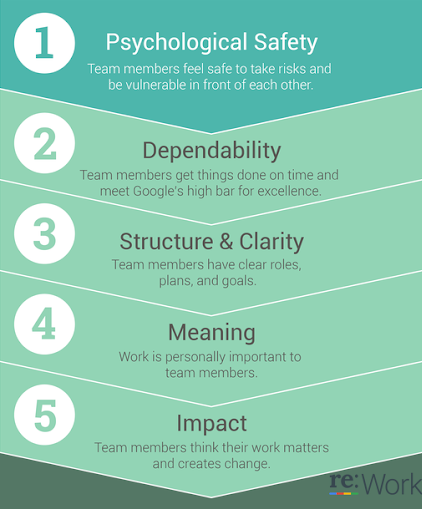

Case Study: Google
In order to build a high performance team at work, psychological safety has previously been identified by Google as one of the most crucial components. A two-year in-depth investigation into “What makes a Google team effective?” was carried out a few years ago by the people operations team at Google.
More than 200 interviews were done with 180 active teams. The Google teams were certain that after conducting the research, they would be able to determine the ideal combination for forming a high-performance team and pinpoint the abilities and characteristics that compose a perfect team.
They were mistaken, though. Instead. The team’s members were determined to be less significant than their relationships, organizational structure, and perspectives on their contributions.
This led to the conclusion that, in order to build a high-performing team, “psychological safety” is the most important factor. Dependability, structure and clarity, meaning of work, and impact of work were the other four criteria that the researchers discovered to be quite significant to the team dynamics.
Additionally, it was discovered that fostering psychological safety at work was not a simple process. It is very normal for people to feel hesitant to act in ways that could harm how others perceive their awareness, competence, and positivity.
A Security Baseline
According to Maslow’s hierarchy of requirements, safety is one of the fundamental demands, and this holds true for the workplace as well,” claims Angus. Psychological safety is tied directly to a company’s culture. At our company, which is over 350 years old and has been built on a foundation of deep respect for others, it’s easy to leverage that culture into an inclusive workplace.”
Specific programs provide an illustration of how this culture is codified. Employee Resource Groups (ERGs), which are grassroots organizations that enable leaders like me to obtain feedback from a range of groups, were created as a result of our mutual respect for one another. It broadens our horizons and makes us more varied, inclusive, and equal, according to Angus. Networks representing women, veterans, LGBTQ people, Asian Americans, and a multicultural organization called Leading Efforts to Ancestral Diversity are among the ERGs (LEAD).
Innovation Is Fostered by Employee Engagement
“If people come to work exactly who they are, they are going to be more engaged. And engagement is a global metric for the company. It’s also part of every leader’s performance metrics at our company,” Angus notes.
Saint-Gobain conducts an annual engagement study to gauge employee engagement, and each year the results have increased. As 80% of all employees are not engaged, this is particularly crucial in a market where jobs are competitive.
Additionally, there is a compelling business justification for guaranteeing staff engagement. As was already noted, an atmosphere that fosters psychological safety makes innovation easier since staff members are less prone to fear failure and more likely to question the status quo. This aids in solving challenging issues and locating innovative methods of operation.
Angus shared the following on LinkedIn since she believes so strongly in the relationship between this kind of security and its relevance to innovation:
At one stretch of my 11-year career with Saint-Gobain, I was responsible for running a very technical area of our business. In this role, I saw firsthand how psychological safety supported employee engagement—because I was not as technically savvy as other members of my team. Despite lacking certain technical skills, I felt empowered to ask questions, try new things and bring a fresh perspective to the team. Most importantly, I knew I could share when I didn’t understand something without being judged or dismissed. We had each other’s full support, which created a collaborative forum for knowledge sharing and peer-to-peer encouragement. We leaned on each other’s respective expertise and, as a result, it was one of the most productive and innovative teams I’ve ever been a part of.
Specific Steps Must Be Taken to Ensure Psychological Safety
Companies had to implement a number of physical and mental safety precautions when the epidemic first started. Saint-Gobain was able to make use of a safety framework that already existed. According to Angus, “We have always had specific tools, such as a robust EAP [employee assistance program], ERG groups and a strong EHS culture,” explains Angus. “So, we created a COVID taskforce as a way to leverage those tools to address workforce needs during the pandemic.”
The procedure included giving individual sites the authority to decide on their own facilities. For instance, the staff at one of the Midwest sites saw childcare as a problem and developed a community-wide program to solve it. There were some places, she adds, “We had sites that shifted their schedules to accommodate family needs as well,”
Additionally, the business is spreading knowledge of its mental health benefits and informing employees that there are still unlimited therapy sessions as the epidemic transitions from pandemic to endemic.
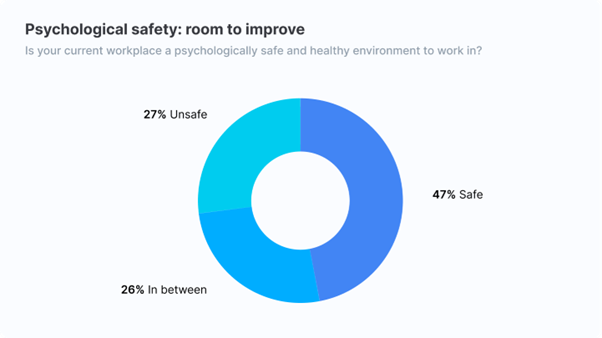
Other businesses, like Saint-Gobain, are employing a range of strategies to deal with mental health difficulties, which have become more prevalent as a result of the pandemic.
Vice President LuAnn Heinen works with the nonprofit Business Group on Health, which specializes in enhancing workforce strategy through health, benefits, and well-being solutions. She points out that the Best Employers Award for Excellence in Health and Well-Being winners this year employed a range of strategies, including the following:
• Well-being/engagement platform (98%),
• Employing a network of well-being champions (89%),
• Assessing employee satisfaction with health and wellness benefits (95%),
• Using employee testimonials to communicate health and wellness advantages (91%)
The rise in communication channels and volume is another crucial strategy for combating the epidemic and one that will persist. “We had ‘CEO chats’ over coffee, which created an open dialogue where employees could ask anything,” according to Angus. “Similar forums were conducted by plant managers. And for employees who aren’t comfortable in group settings, there is a hotline where they can express their concerns. Our message is that if you have something to say, speak up—we are here.”
This was also true for the Business Group on Health award winners, with such practices as:
• use of senior executives, managers, well-being champions, and ERGs in cascading communication initiatives;
• conversations over a campfire with CEOs;
• All employees receive weekly letters from the CEOs encouraging them to share personal tales, such as difficulties with a family member’s health,
• use QR codes to access specific services quickly, and use platforms and hubs for well-being.
An Important Aspect of Psychological Health Is Mental Health
Since health and wellness initiatives have long been a component of business services, there has been an increased emphasis on mental health, which is connected to psychological health, beginning even before the epidemic and continuing now. According to EHS Today’s 2022 Mental Health in the Workplace Report, many businesses indicate they prioritize mental health as part of their wellness initiatives, with 81.8% claiming to have such a program in place and 6.3% claiming to have one in the works.
A lot of people are interested in mental health, according to the Business Group on Health. Employers are highly concerned about mental health in 2022, according to Heinen. Based on the profiles of the winners, she offers the following statistics:
• 88% provide assistance for family, adolescent, and/or pediatric mental health;
• 86% have initiatives and benefits that address suicide;
• 91% have changed how they approach fatigue;
• 82% of organizations have champions or supporters for mental health, and
• 80% offer programs and perks that deal with substance use issues.
Although those numbers only relate to that particular group of winners, a survey conducted by EHS Today revealed that many firms lack defined rules. In actuality, 33.9% of respondents admitted they “don’t know” if they have a mental health policy in place or that they “don’t have” one. Respondents describe the programs offered by the companies that have them as only adequate (21.7%) or inadequate (13.7%).
This will be a challenge for businesses to get over since COVID-19 virus uncertainty will continue to affect planning in terms of both physical safety and mental safety.
Given the company’s response to the pandemic, Saint-Gobain will find it easier to adjust to whatever the future holds. “We have created very clear guidelines on how to respond during the pandemic, so those will be used going forward as well as continuing to assess the situation,” according to Angus.
The combination of that level of security and a keen understanding of how crucial it is to also provide psychological security is the secret to success for both the individual employee and the business as a whole. According to Angus, “When employees can bring their best self to work, they prosper—as does the company,”
Give Attention To Psychological Safety
Your company ought to be a center of growth, innovation, and learning. Interpersonal trust, self-awareness, and psychological safety are prerequisites for learning and growth.
A “good to have” employment benefit shouldn’t be psychological safety. It should play a significant role in the culture and future of every business.
If companies want to build a successful business, team psychological safety must be given top attention in the workplace. Furthermore, psychological safety supports a welcoming, varied, and inclusive workplace. a setting where workers feel free to share their opinions.
The team members of a good organization are ultimately what distinguishes it.

Exercise 3.1: Icebreaker Questions
Course Manual 2: Measuring Safety
Assessing Psychological Safety
We are aware that psychological safety is crucial for high performance teams because it promotes idea sharing, the acceptance of mistakes and the ability to learn from them, the identification of risks, and criticizing (and improving) existing practices. The main pillar for team effectiveness, organizational agility, and transformation is psychological safety.
Developing products that satisfy customers and meet essential business objectives requires creativity, and psychological safety is a key enabler of innovation. Building psychological safety in organizations has many other wonderful advantages.
17 Warning Signs Of Poor Psychological Safety At Work
If your employees frequently hold their tongue during meetings even when they have something to say, that’s one of the telltale symptoms that their employment doesn’t make them feel psychologically safe.
Psychological safety enables you to “feel safe enough to bring up problems or tough issues, to share a fresh idea, to seek for support, and celebrate variety,” according to Katherine Kirkinis, PhD, an expert in job counseling and career evaluation in New York City.
The reason for your silence at work in this situation has nothing to do with your personality or general tendency to speak up or keep quiet.
According to Kirkinis, “workers will keep their mouths shut when they fear rejection or that their thoughts and ideas aren’t valued.
Although there are many team dynamics that could cause you to feel this way, here are 17 probable indicators of low psychological safety:
1. You can never be certain how others will react to what you have to say.
2. The majority of the members in your team are more likely to remain silent than to speak during crucial discussions.
3. As time goes on, team members get quieter and give fewer ideas.
4. Morale on the team is consistently low.
5. There is consistently high turnover.
6. The feedback gained through anonymous polling differs from that obtained through direct communication.
7. Teammate cooperation is subordinate to competition.
8. Team members hardly ever question the current situation.
9. During meetings and feedback sessions, leaders frequently steer the conversation.
10. Team members, particularly leaders, infrequently or never recognize their shortcomings or errors.
11. Despite feeling overburdened by your responsibilities, you are uncomfortable seeking modifications or assistance.
12. Feedback is not routinely asked or shared.
13. Issues, pleas for assistance, suggestions, or disappointment are heard, but nothing is done.
14. As a result of not including all team members in crucial conversations, assumptions are made in the gaps.
15. You don’t believe your manager has your best interests in mind and are unsure about your relationship with them.
16. Discussions tend to center on the positive rather than on chances for improvement or lessons gained.
17. Not everyone thinks that the senior leadership is inclusive.
Prior to assessing psychological safety:
Engage in dialogue with members of your team and organization. Inquire about the perceptions of the people on the level of psychological safety in their teams and the larger organization. Ask people how much they understand—or even whether they have heard of—the term psychological safety. You will be able to better create the survey language and choose the appropriate course of action thanks to these discussions.
Most critically, though, make sure you have the means—people, power, and authority—to act on the insights that will emerge from the psychological safety measurement. People will lose faith in the strategy if the poll is conducted but nothing is done about it for six months or more. As a result, you risk endangering psychological safety.
For the complete set of tools to measure, create, and maintain psychological safety, download the psychological safety action pack.
Although Measuring Psychological Safety Has Great Potential, Doing So Can Be Risky
Measurement can be a useful exercise when starting a road toward development, but it also contains risks. In addition to “Campbell’s Law,” which states that if decisions are made as a result of the survey, it may incentivize people to alter the ratings accordingly, skewing the results again, we must be aware of sampling bias (where only people who feel safe to complete the survey do so, distorting the results). Even measuring itself can be detrimental to psychological safety, especially if no action is made as a result. Don’t take this lightly, and make sure that it causes change. Imagine how team members would feel if they were asked to participate in this survey, which asks them to be vulnerable, and then felt that the data was ignored later and that nothing was done as a result of the findings.
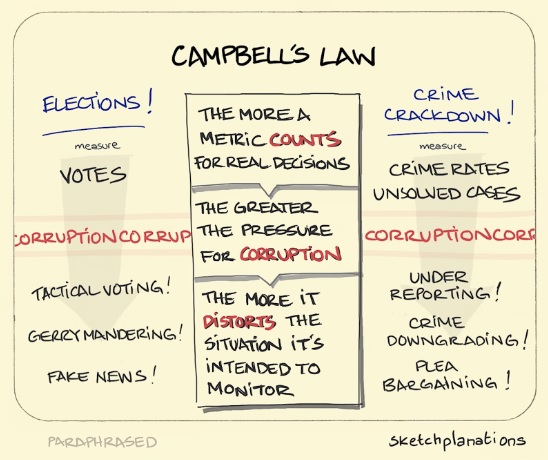
It’s crucial to only carry out this procedure as part of a larger program aimed at enhancing psychological safety practices and in open communication with your workforce. This method only really works for long-lasting teams that have had time to establish routines and practices; it won’t make as much sense for short-lasting or newly formed teams that lack established routines and behaviors. Use the “team performance exercise” instead for short-lived teams (which is also a fantastic practice for long-lived teams!).
Four Significant Effects
By asking respondents if they agree with these statements, you’re actually accomplishing four significant tasks:
1. exposing any problems that have an impact on psychological safety;
2. educating people about what psychological safety is;
3. creating a safe space for discussing psychological safety;
4. most importantly, making explicit and promoting the very behaviors that improve psychological safety!
The 10 questions listed below can be used to gauge the psychological safety of your team by you or your team members. Be mindful of how linguistic and cultural variables may affect the survey’s significance. Any questions that your team might find confusing should be changed, and terminology should be adjusted as appropriate. We are attempting to have the best relevance and influence for our particular context rather than trying to replicate this across many organizations (so we don’t need to worry about replicability in diverse contexts).
When conducting this exercise with your team, it is better to conduct the survey anonymously since, if your team is psychologically unsafe, they will be more likely to be honest. Whether the survey is anonymous or not won’t matter if the team feels highly secure psychologically.
A short-lived team should not participate in this exercise, which is wonderful for long-lived teams (such as a temporary project team). Utilize the workshop on the psychological safety matrix instead to address and establish psychological safety in a more qualitative manner.
Effortless But Effective Communication
Dialogue is more effective than measurements, therefore you can utilize these remarks more as a talking point and discussion starter with your team rather than as a survey. This is a good illustration of the Action Research methodology.
If at all feasible, make sure that each question has a “comment” option so that respondents can add further information if they so choose. In order to facilitate and clarify some of the steps you may need to do in order to create psychological safety in the team, it is crucial to get qualitative feedback on each assertion.
Measurement
Ask your team to rate how much they agree with the following assertions on a scale from 1 to 5 (also known as a “likert” scale), with 1 representing a low score and 5 a high one.
1. I know what is expected of me on this team.
2. Outcomes are valued more highly than inputs or outputs, and nobody needs to “appear busy.”
3. It is never used against me if I make a mistake on this team.
4. When something goes wrong, we collaborate to identify the systemic root of the problem.
5. Every team member feels comfortable bringing up matters that are difficult or problematic.
6. No one is left out and team members never reject others for being different.
7. I can take a chance on this team without fear.
8. I find it simple to seek assistance from other team members.
9. No one on this team would purposefully take actions that would frustrate my efforts.
10. My special abilities and talents are appreciated and used when working with the other members of this team.
These are only examples; you should change them and pick the ones that fit your language and situation the best.
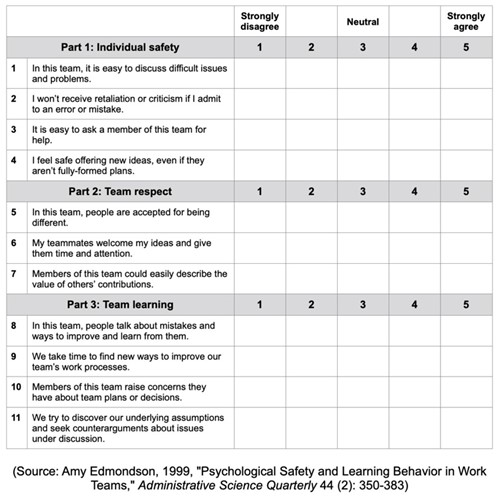
The important thing is to make sure that you utilize the words, phrases, and actions that are most appropriate for your teams and setting.
Repeat the survey after some time has passed (you decide how long) to assess any changes in the various psychological safety areas and to show your team that you are dedicated to continual improvement.
Metrics
The most psychologically secure squad in the world would have a team average of 50. This is a little improbable. In actuality, a score of 50 may indicate a problem where people feel unable to respond honestly; if that’s the case, look into it more.
The general psychological safety decreases as the team’s overall score rises. The strength of this poll is in the specifics, though.
Find the statements with the fewest votes and the greatest variety of answers. Regardless of whether you are in charge of the team or not, these are the areas where you need to take action and where you can have the biggest impact. For instance, there can be new team members who don’t feel as secure as team members who have been on the team for a longer period of time.
Consider what steps you can take or behaviors you can promote to improve the scores after reading the justification for each of the statements below.
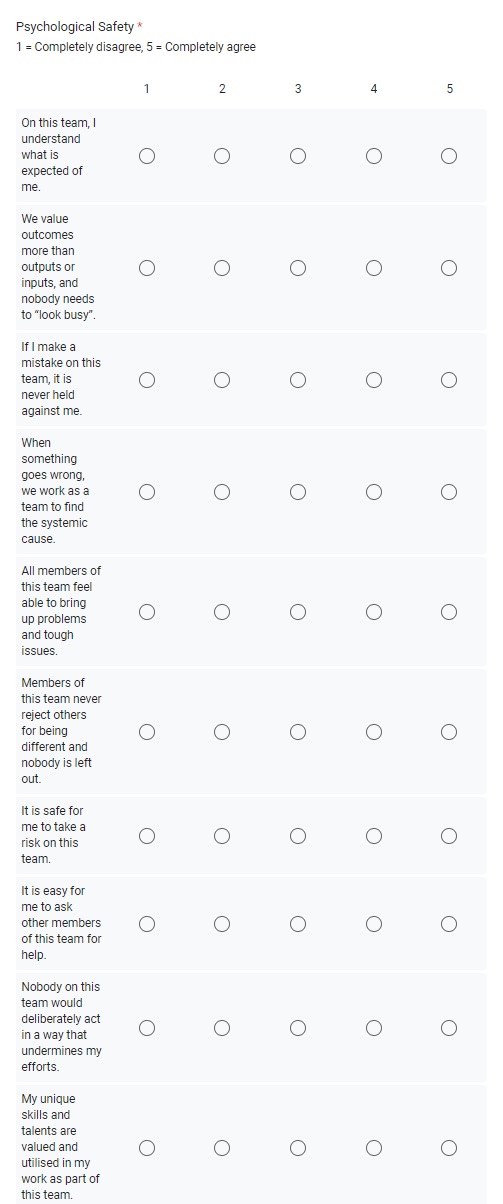

Case Study: Wegmans – Psychological Safety Done Right
Wegmans Food Markets, Inc. is based in Gates, NY. It consistently ranks first among the best-loved and most-admired firms according to Fortune, Bloomberg, and other publications.
The privately held company has been in the Wegman family for 100 years and is run by CEO Danny Wegman and President Coleen Wegman.
You might assume that because of its reputation for exceptional customer service and loyalty, its employees are content with their jobs. “We empower our people to make decisions that improve their work and benefit our customers and our company” says Jo Natale, director of media relations at Wegmans.
The National Down Syndrome Congress, Working Mother, American Society of Training and Development, Supermarket News, Dale Carnegie Training, Ethisphere Institute, Forbes, and the National Council on Aging have all given Wegmans honors and recognition in the past. All of the accolades support the employee-centric organization Wegmans promotes in its PR, hiring, and employee development efforts.
Wegmans’ culture and organizational behavior are governed by its publicly stated ideals. The values presuppose that there is a strong bond between customers and employees. Their own words:
• Every person’s success and well-being are important to us.
• A life of high standards is the norm. We strive for excellence in all that we do.
• In each community we serve, we have a positive impact.
• We value and pay attention to our people.
• We provide our employees the freedom to make choices that will enhance their performance and profit both our business and our clients.
• Clear, persistent, and forceful attention is placed on the people. The rhetoric itself causes individuals to prioritize a cause and effect relationship.
Wegmans decided to match advantages with its objectives and values. For instance, Wegmans claims that when it comes to medical benefits, “When our people are well, Wegmans can work toward a single objective and can completely live our values.” With proactive wellness and fitness initiatives, they assist employees in maintaining their health.
They support programs for childcare, eldercare, financial planning, adoption aid, and dependent care savings accounts in addition to the all-employee comprehensive health policies.

Exercise 3.2: Blind Snake

Course Manual 3: Inclusion Safety
The fundamental human desire to connect and belong is satisfied by inclusion safety. Everyone wants to fit in, whether it’s at work, school, home, or in other social contexts. In actuality, the want to be accepted comes before the need to be heard. We establish a sense of shared identity and a perception that our presence matters when others welcome us into their society. Our confidence, resiliency, and independence are increased when we can interact with other people in a social group without being afraid of being rejected or shamed. But what if you don’t receive that fundamental human acceptance and validation? It is, in a word, crippling. It causes the brain’s pain centers to become active. It is morally required to provide another person with inclusion and safety. In fact, the only thing that can exempt us from this obligation is the threat of harm. Regardless of our differences, when we create an environment where people can feel secure and included, we recognize our shared humanity and reject pretentious elitism and false conceptions of superiority.
11 Exceptionally Effective Ways To Promote Inclusion at Work
Humility and inclusion are similar concepts in the workplace.
Although everyone likes to believe they have it, they actually don’t.
According to a recent Deloitte survey, 80% of workers believe that inclusiveness is a crucial consideration when choosing a company.
But what does having a diverse workplace environment actually entail? Does it equate to a diverse workforce?
Let’s look at it.
Diversity Is Not Possible Without Inclusion
Think about throwing a dinner party.
Each visitor has a unique set of preferences. While some people are vegans, others are vegetarians. Some people can’t have gluten, while others can’t stand eggs.
You have a fixed menu, which is the issue. You have even accidentally alienated half of your visitors.
The following time you hosted a meal, you made a few adjustments after realizing the issue. and the week after that. and the following week. Until you eventually come up with a menu that each visitor can eat and appreciate.
Diversity has been invited to dinner. Making sure everyone enjoys the food is being inclusive.
Simply fostering a varied workplace culture is significantly different from fostering an inclusive workplace culture.
A diverse workforce entails having a headcount of people of different sexes, races, and sexual orientations just for marketing purposes.
An inclusive corporate culture, on the other hand, sets itself apart from any potential unconscious bias in the workplace. No matter who they are or how they identify themselves, employees feel accepted.

Case Study:Balloon
Amanda Greenberg is leading the crucial effort required to reevaluate team meetings. Her goal is to offer a remedy that raises unseen voices and lessens the tendency toward groupthink that is frequently promoted in conventional meeting settings. As a co-founder of Balloon, our insights-based platform addresses organizational problems at the systemic level, such as cognitive biases and group dynamics, by rethinking team collaboration and fostering more productivity, innovation, knowledge sharing, and inclusivity. The platform gives leaders a structure where each team member’s input is valued, embraced, and supported – a system that fosters greater innovation.
Balloon has been instrumental in helping the teams at Amazon, UScellular, TrueCar, Estée Lauder, and other organizations cut meeting times by 70% while increasing the participation of participants. Flights, a sequence of open-ended questions designed to elicit responses and collect votes from team members and potential consumers, are used to do this. Flights can be finished asynchronously and are versatile for distributed and remote teams. In order to provide team members, regardless of their position or role, the chance to have their views heard and participate to crucial choices, they are also completely anonymous. “Everything is organized by a balloon score, which gives a leader and a team information about approval, buy-in, consensus. So you know where you have alignment and where you don’t,” Greenberg added. In order to receive credit for their contributions and export everything, their users can also remove their anonymity and place their names next to their thoughts. All these data are available to the company.
11 Practical Steps To Increase Inclusion At Work
The main obstacle to inclusion is creating a culture of inclusion in the workplace.
You go through a lot of difficulty to attract different types of talent to your company. Therefore, why not make sure that their employee experience is excellent?
Here are 11 outstanding approaches to develop a successful inclusion strategy.
1. Informing managers on inclusion at work
Managers have a critical role in fostering an inclusive workplace atmosphere.
A manager serves as a liaison between staff and management and is frequently on the front lines. Therefore, it is crucial that they have experience managing a diverse staff.
But consider this: Accidents happen. For this reason, managers need to receive education and training in order to comprehend, encourage, and foster an inclusive culture among all employees.
Starbucks was recently the target of an unseen racist act that rocked the business to its core.
In response, the coffee shop business performed a required “unconscious prejudice” training that some 175,000 Starbucks staff members attended. Furthermore, it shuttered nearly 8,000 of its locations until the diversity training was finished.
While you don’t have to take such extreme steps to inform your team on diversity and inclusion (D&I) in the workplace, the following advice will be helpful:
• scheduling diversity workshops and cultural training, as well as working to eradicate unconscious bias by informing staff members of the value of everyone’s inclusion.
• Make a thorough assessment of the workplace. Take a look at how inclusive the workplace is. Exist non-gender-specific restrooms? People that identify differently in terms of their sexual orientation are they excluded from projects? Do people covertly discuss racial or gender issues?
• having a system for employee feedback and its appropriate evaluation. You won’t ever truly understand what went wrong unless you offer employees a voice of their own.
2. Rethinking workforce policies will help to create an inclusive workplace culture.
Developing an inclusive culture may require the adoption of new regulations or the abolition of existing outdated ones. These regulations may cover everything from hiring to performance appraisal.
Adapting your company’s policies to a more diverse workforce can be done in the following ways:
• Encourage hiring consultants, career fairs, and various community outreach activities to submit prospects for consideration. That guarantees that you have a wide range of unique talents.
• In 2019, women still earn only $0.79 for every dollar earned by males. Ensure that your organization pays people according to their job title and skill set. Being paid less than you deserve shouldn’t be based on your gender, color, or sexual orientation.
• Different holidays for many cultures. Ensure that your staff members receive time off for holidays not listed on the official business holiday calendar.
3. Share Inclusion Objectives And Track Progress
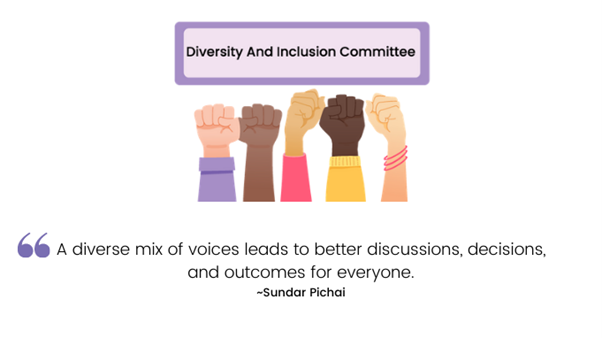
It is not sufficient to just create inclusive workplace policy. It’s more crucial to let your employees know what you expect of them.
Employees should feel comfortable approaching their bosses if they experience any form of prejudice.
In turn, managers must maintain an open mind by refraining from forming any assumptions and encouraging staff to speak freely.
Here are a few strategies for opening up a line of communication regarding inclusion-related issues:
• Ask for opinions about the working environment in your company on a regular basis.
• Establish specific diversity committees to guarantee that inclusion objectives are realized. A varied panel with representatives from many departments ensures that the procedure is open to all parties.
• Some people are reluctant to speak out against persistent prejudice in the workplace. The diversity panel should support continuous initiatives to eliminate any unconscious bias from the workplace.
4. In order to make everyone feel included, celebrate differences.
One of the finest ways to show that you respect your employees is to encourage them to exercise their culture and customs at work.
Here are some strategies you may use to encourage inclusivity at work:
• People bring food that represents their culture to potluck lunches.
• Observe and commemorate holidays that are important to various communities, such as Black History Month in February and Pride Month in June, among others.
• Make certain that workers from various racial, cultural, and ethnic backgrounds can participate in decision-making at your company.
• Every employee carries the stigma of being from a group that experienced prejudice in some way. Through an organizational publication, they should share their experiences with prejudice in the organization as well as their perspectives and beliefs.
5. Opportunities For Employee Engagement That Are Diverse
For a better employee experience, developing an inclusive workplace culture has become essential and not simply a choice.
• Allow employees access to your company’s various sites so they can experience the local work culture. Employees will then get the chance to observe how various cultures have distinct ways of doing things.
• Take a pulse survey of your staff to determine the experiences they would need to have in order to fully comprehend the advantages of diversity.
• So that the mentee has a better possibility of finding inspiration and someone to look up to who would demonstrate that talent is what matters despite differences, assign a diversity mentor from a different community.
6. Early Inclusion Introduction (During Onboarding!)
Starting from scratch is crucial if you want to develop an inclusive culture.
Make it a point to explain, defend, and promote how your company values include inclusion. Send it to your social media pages, websites, or interviews so that everyone is aware of your commitment to ensuring that diverse staff feel included and your inclusion goals.
When a new employee is being onboarded, stress the value of inclusion and diversity in the company.
• Make sure every new hire understands that your business is a safe environment for people of all genders, races, cultures, and disabilities.
• Inform new hires of the D&I policies in effect and the steps they should follow if they become the victim of discrimination.
• Promote the fact that discrimination in the workplace will not be tolerated and will be handled with strong measures.
• Find out how you can enhance your D&I-focused hiring and orientation process by taking an onboarding survey.
7. Pronouns Must Count
People cannot be included in the workplace if they are not respected for who they are.
It is up to each individual to determine their preferred pronouns.
It has to do with who they really are. A pronoun mistake can cause a lot of stress for a worker and lead to an identity problem for them. In order to make your business “pronoun-friendly,” take the following actions:
• Provide a section on the preferred pronouns on the employee identity cards.
• Promote the importance of finding out the preferred pronouns of other employees when you first meet them.
• Any job description or advertisement should use terminology that is gender-neutral. Amazingly, there is an app that determines whether your job advertising contain any implicit bias.
• Consider using tools like Alex to make it easier to communicate using the appropriate pronouns in teams. During team communication, Alex assists you and your staff in determining whether they are unintentionally being insensitive to their teammates.
8. Communication Channel for Diversity and Inclusion
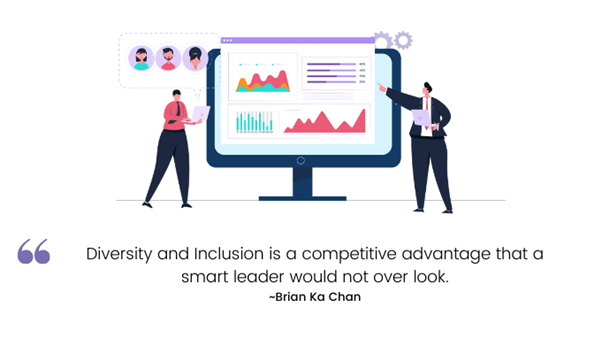
Inclusion shouldn’t only be a policy at your organization. It ought to promote candid communication as well.
Utilize your current resources, such as Microsoft Teams and Slack, to share articles, news, and assistance for your diverse staff.
Conduct diversity and inclusion lectures as well, inviting experts or advocates to educate your staff.
Additionally, you can provide volunteer opportunities for staff members who want to support areas that experience discrimination on a daily basis.
It’s critical to promote ongoing education on the overt and covert bias minority experience and how your company may be considerate of their needs and rights.
9. Create A Committee for Diversity and Inclusion
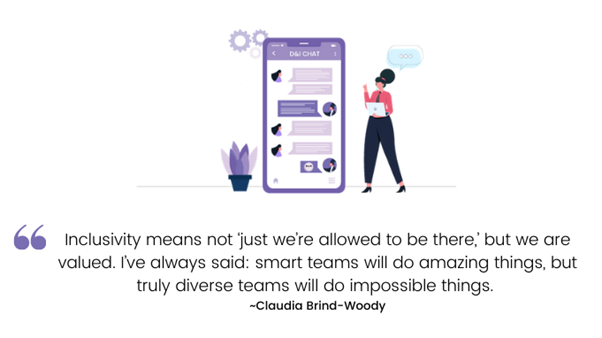
Every inclusive organization needs to establish a diversity and inclusion (D&I) committee.
You would be represented by a D&I committee that would advocate for the need for inclusiveness in the workplace. Most importantly, these committees assist in monitoring the effectiveness and adherence to the inclusion strategies.
D&I committees also act as a link between you and your staff. The D&I committee’s members are actual workers.
As a result, it becomes simpler for people to identify and relate to any unconscious bias at play. These committees appear to be more reachable to staff members than approaching a management and voicing any concerns.
10. Roundtable discussions
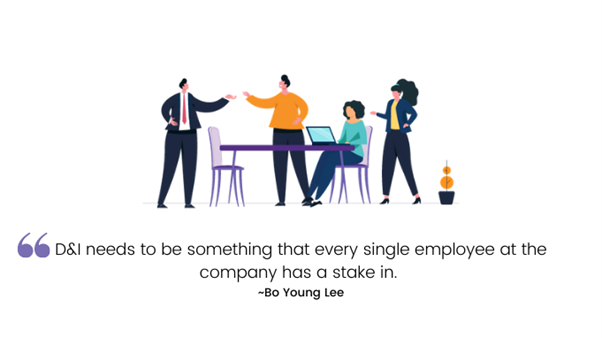
Meetings are an excellent way to determine whether or not your company is truly inclusive.
Do your male employees tend to voice their thoughts more often? Do certain workers constantly interrupt others when they’re speaking? Do the members of your diverse workforce hesitate to speak up and share their ideas?
The chances are that your varied workforce has not been provided the proper opportunities to advance professionally if the response to the aforementioned questions is “yes.”
Making the meetings honor everyone’s opinions by using the “round-robin method” is an excellent place to start. Using the round-robin method, each participant in a meeting is given an equal opportunity to talk, contribute, or demonstrate without interruption from anybody else. This guarantees that every employee has an equal opportunity to join and engage in discussion.
11. Connect D&I Initiatives To Normal Conversations
Making ensuring that workplace inclusion becomes a part of your regular work-life culture is the final but most important stage.
Rewarding and recognizing positive actions is an effective strategy to motivate staff to develop their ability to be more considerate and hospitable to every other employee.
Therefore, be careful to publicly commend an employee’s efforts if you observe them going above and above to respect the cultures and demands of their widely disparate colleagues.
Even while being open and nonjudgmental is the absolute minimum, identifying particular behaviors can help set expectations that you reward those who treat others with respect.
The Drama Isn’t Over Yet
Better teamwork, more innovation, and more effective decision-making are all benefits of diversity in an organization. However, inclusion is what binds individuals to the group and encourages them to stick around.

Exercise 3.3: What’s My Name?

Course Manual 4: Learner Safety
Everyone Has a Part to Play in the Learning Process, Regardless of Title
Only a leader who continually reduces vulnerability through a pattern of positive emotional response will be able to maintain a culture of learning. A key sign of learner safety is how an organization’s leader handles criticism and bad news.
Never will a leader who values learner safety allow hierarchy to get in the way. C-level executives and CEOs are not exempt from taking part in the learning process. The team’s leaders are in charge of setting an example for successful and interesting learning.
Learner safety is an advantage
Leaders that are dedicated to preserving Learner safety is aware that the source of competitive advantage is learning. An organization will stop innovating if it stops learning. A cycle of competition is a cycle of learning. Either develop competitiveness, or run the serious risk of becoming irrelevant.

Case Study: Heineken
86% of senior leaders at Heineken expressed a desire to collaborate with the younger workforce—the future generation—in order to acquire fresh knowledge and experiences. This prompted Heineken to launch a program of reverse mentoring, in which younger staff members serve as mentors to senior leaders and executives. A program like this tries to give leadership fresh perspectives on the workplace of the future and potential growth opportunities.
Heineken also has an international diversity and inclusion program. The goal of this program is to equip participants with the tools they need to practice inclusiveness and celebrate the diversity of the nations where the organization does business. In order to assess how inclusive employees felt the organization was and what could be done to make it more inclusive, Pascale Thorre, the head of inclusion and diversity, performed a round of 45 introduction interviews when developing the program.
The objective at that time was to develop a program that concentrated on “[their] people’s prospective requirements throughout the full five layers of Maslow’s Hierarchy of Needs theory.” This required taking into account demands related to physiology, belonging, self-actualization, self-esteem, and safety. Thorre continued,
“[I]nclusion starts with open and honest communication with everyone in your company … After all, Inclusion can translate differently in different environments and for diverse people.”
Do You Adopt a Learner Safety Policy?
Now is the right time to step back and assess your own life. Ask yourself these questions as you assess your progress in fostering learner safety in your immediate environment.
• Does your team penalize mistakes? Do you punish incompetence?
• In your own learning, do you exhibit vulnerability?
• Do you encourage the other team members to take risks when learning?
• Do you make a snap judgment about a new employee’s aptitude right away or do you hold back?
• When was the last time you fostered someone else’s motivation and curiosity in a learning environment?
• How can the most reticent and afraid team member come out and participate if the learner anxiety barrier has been lowered?
• Do you have a proactive, self-directed learning attitude?
• Do you have an open mind and a desire to learn?
• Do you exhibit the capacity to pick up knowledge from people at all levels of authority?
• Do you serve as an example for your team in this zeal for learning?
Understanding learner safety is not enough; you must put specific behaviors into practice. Examples of how you can improve learner safety include these actions. What can you do to actually increase learner safety if you aren’t doing anything to decrease it?
1. Make learning a collaborative process rather than a contest.
Learning shouldn’t be a bitter rivalry. Yes, you can organize friendly competitions for learning that are enjoyable, but avoid letting the educational process generate harmful divisions and set individuals against one another. The very competitive people will be eager to play, but the non-competitive ones will choose not to if learning turns into a win/lose competition on your team, if people perceive it that way. That could severely hinder your team’s ability to succeed as a whole. Assist your team in realizing that learning is a collective as well as an individual activity. Set the assumption that they have a duty to assist their peers in learning. Asking your team to purposefully support one person’s learning each day is a simple method to develop this norm on your team. Every time your team gathers for a meeting, you can reiterate this expectation. Ask your team members to provide examples of how they contributed to or were contributed to the learning process once you’ve gained some momentum and experience doing this. Remember to make learning a collaborative effort rather than a contest.
2. Take on a learning attitude.
The idea of being a student suggests that we are constantly learning and will never reach a point where we have internalized everything. To avoid being arrogant or complacent in our learning, we want to adopt this mindset. A learning mentality suggests that we approach learning with some humility. Even though you could be a specialist in your industry, you’re ready to pick up knowledge from others when you adopt this approach. Some people adopt the opposing viewpoint. They grow a superiority complex and true arrogance as a result of their skill. Isn’t that irksome? Who wants to work with an expert whose only motivation is to brag about how knowledgeable they are? You don’t want those individuals on your team. Both credit and airtime are things they seek. It’s draining! Help your team members realize that while they may acquire knowledge and experience in their areas of responsibility, we are all lifelong learners and will never reach a point of absolute mastery. Think about the following: Do you have an open mind and a desire to learn? Do you exhibit the capacity to pick up knowledge from people at all levels of authority? Do you serve as an example for your team in this zeal for learning?
3. Evaluate each person’s disposition and learning style.
Your team consists of individuals with various learning preferences and character traits. Others learn best visually. Others like to study alone. Some people prefer to study aloud. Some people are independent. Some people adore learning on the job but detest the classroom. It is your responsibility to comprehend how each team member learns. You can achieve this by both watching them and questioning them during an interview about their preferred methods of learning. Keep in mind that one of your duties as a leader is to facilitate and support each team member’s learning. An approach from a factory where one size fits all won’t work for that. People differ greatly in their learning preferences and inclinations. You must understand how each member of your team learns best if you want to help them advance their learning. You might be traveling on a mutual discovery journey with them because, in some cases, they don’t even know. Once you’ve identified the preferred learning styles of your team members, assist them in developing some learning and growth objectives and personalize their education as much as you can.
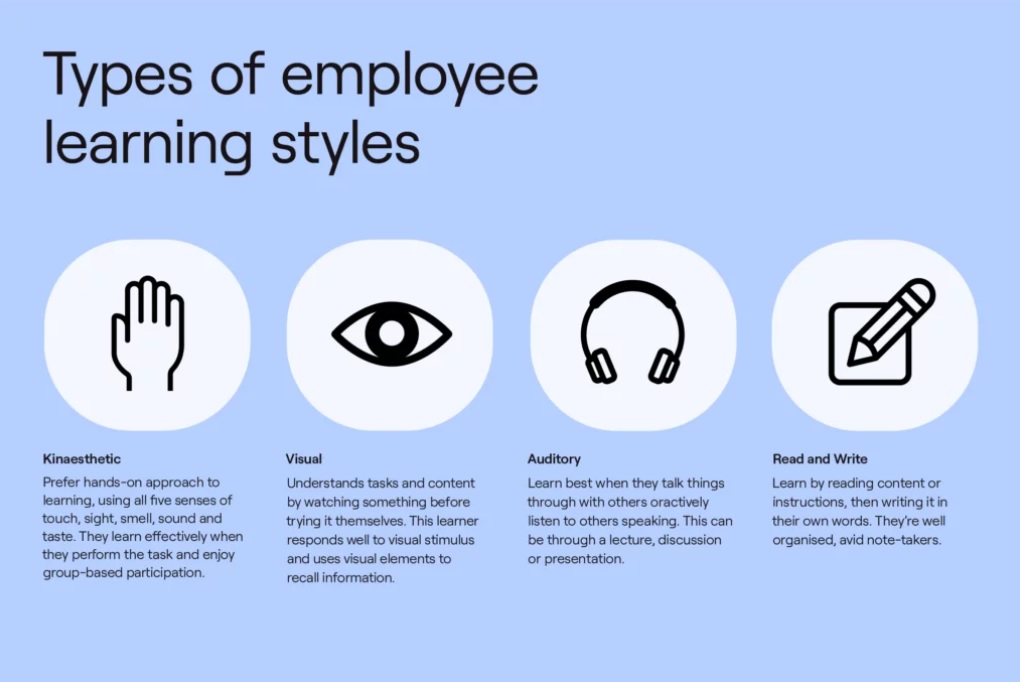
4. Support both your private and public students.
It’s your responsibility to lessen the hesitation and anxiety that are frequently connected to learning. Most likely, both public and private students make up your team. Some team members might not want to learn in a group situation, as you may have noticed. They are known as private learners. If you see this resistance, work one-on-one with those team members in a setting that is familiar to them or in their space to assist them learn. Of course, they enjoy working independently. Private students enjoy solitude, stillness, and concentration. They enter their flow state—what we refer to as their groove—in this manner. Additionally, certain team members will learn best through social engagement. When you remove them from a social learning setting, they get bored and lose focus because it is their source of energy for the learning process. Do you know who the team members that are public learners are? Ponder this question as you consider your team members. Do you recognize your team’s private learners? The majority of us skew more toward one than the other. Private education presents the apparent difficulty of not allowing for real-time cooperation. Your group need that. Because your team has a fantastic brain, you may frequently learn more quickly while you’re learning together. You can exchange thoughts and criticism with one another. What you can do is: Identify your private students first. Second, even if they might not like it, urge them to contribute more to public education. Third, keep the talkative public learners on your team who could be inclined to talk more than they listen out of their personal area.
5. Share the knowledge you acquire.
Sharing what you’re learning with others is one of the most effective methods to motivate them to learn. Talk about the subjects, the discoveries, and, most importantly, the pleasure and fulfillment you find in learning. You spread positivity and excitement for studying. “What have I learned recently that I’m excited about,” ask yourself. You might have picked it up from a book, a video, or a podcast, among other sources. It could have come up in a quick conversation at lunch or during your team meeting in the morning. You might have discovered it by asking a question or trying something out. The options for learning are countless. Consider this: Happiness is a result of learning. When we learn anything new, we now own that knowledge, insight, skill, or realization. Every new skill you acquire alters who you are as a person. Simply put, you have a little more knowledge, experience, competence, and self-assurance. Do you recall the day you first learned how to ride a bike? Most likely, you stumbled a few times and scraped your knees. Then, in a seemingly supernatural turn of events, the person assisting you released go, and you found yourself balancing the bike all by yourself. You probably squealed with delight. Humans have an innate desire to learn and improve, therefore learning is enjoyable. The call to action is what? Exchange your knowledge. Share your excitement about your finding with others. Encourage the rest of your staff to follow suit.
6. Help your teammates achieve
Some team members will have aggressive learning styles and be self-assured in their general aptitude for knowledge and problem-solving. Some won’t. Even though it may seem stupid, they will be hesitant and believe they need to seek permission before participating in the learning process. However, it is exactly how they feel. Sometimes all someone requires is a request to participate in the learning process. A person’s attitude toward and confidence in learning is largely influenced by their earlier experiences. The actual meaning of devastation is having no one care when you fail. There’s a good chance that some of your team members have experienced that. They were demoralized. Your responsibility is to sincerely care about their education and to put them in a position to succeed. How do you go about that? Determine what inquiries, issues, or difficulties you may provide to your less confident team members as learning assignments. Avoid assigning them difficult homework that will only serve to demotivate them further. Make them relevant and manageable. Help your teammates achieve minor victories.

7. Get people to think outside of their roles.
It’s virtually always true that people want to talk about their specific roles because they take pride in what they do. What you can do is: Ask the team members to describe their responsibilities or to share something recent they did in those responsibilities and how it affected the other team members. This might be done during a weekly meeting. A “Share Your Role” showcase opportunity can be scheduled. This can inspire everyone in the team to value one another and learn something new about each position. Every employee must develop the capacity to think beyond their assigned responsibilities in the twenty-first century. But that’s not always simple because most professions have a limited range of responsibilities. As a result, we adopt a tactical approach and exhibit compartmentalized thinking. We are familiar with our duties and little else because that is all the organization has requested of us. That is altering. We require team members that can soar in their hot air balloons and view the broad picture in the 1920s. Why? If you simply consider your own role, how can you innovate and improve? You must be able to recognize systems, processes, and cause and effect connections. If you’re in charge of buying a few different types of widgets as a procurement officer, that’s great. But what if you could comprehend our purchasing strategy at a higher level and make suggestions for improvements that go beyond the specific scope of your position? Wow. That is useful. Do that right away. Get people to think outside of their roles.
8. Discuss prior blunders.
If a team has a culture that conceals mistakes, it is difficult to learn from them. If you look closely, you’ll see that each squad has its own philosophy towards errors. More than any other component, the leader’s influence is mostly responsible for that mindset. There are two fundamental types of teams when it comes to errors, at the risk of oversimplifying. Teams who view mistakes and failure as learning opportunities that help us advance and those that equate mistakes and failure with dread. As a team leader, it is your responsibility to establish a culture within your group that separates failure and mistakes from fear. Don’t penalise errors unless a team member commits one out of carelessness, irresponsibility, or egregious neglect. Encourage them. Why do you do this? How can you encourage your team to discuss mistakes and failures and to do so with courage and confidence? Simple. Use this opportunity to share some of your failures and missteps. Make fun of them and then explain what you learnt. Others will feel more at ease expressing their errors and mistakes and attempting to learn from them as a result of this. It’s important to admit mistakes and display vulnerability in order to motivate others to learn.
9. Ask individuals with lower status for assistance.
Find strategies to approach others beneath you in the hierarchy for assistance. You can demonstrate humility in learning by doing this. Additionally, it provides the other person the ability to instruct and assist, which boosts confidence and involvement. Take a step back and consider this: What is the relationship between status and education? The answer is null. Are you smarter if you have more status? Are you right if you have more status? Obviously not. That is absurd. But a lot of people act in that way. We show respect for those with more status. We don’t approach learning and collaborative problem solving with complete assurance. Why? because the status disparity—which is really just an artificial restriction—becomes the barrier. There is a universal pattern that permeates every community and culture in which individuals with lesser position show deference to those with greater status. And that’s not surprising given that being at the bottom of the food chain makes you more exposed to personal risk. As a result, you are aware that this pattern already exists. It existed prior to your birth. How can you help? Ask for assistance from persons with lower status in a sincere and honest manner. It cannot be manufactured, synthesized, or written. Give it life. Ask others who may know but may have a lower standing than you for assistance with genuine queries or difficulties. That will go a long way toward eradicating the poisonous status difference issue that frequently obstructs our progress. It’s your time now.
10. Before you solve a problem, frame it.
Teach your team to frame issues before finding solutions. We frequently hear someone describe a problem and the desire to remedy it, so what do we do next? We get right in to try to solve it. That’s good, isn’t it? Although the approach is flawed, the intention is good. Consider what we would do if we jumped right into problem-solving. We’re presuming that the issue has been appropriately stated. That’s a significant supposition, and if we move further, we’ll solve the incorrect issue. The greatest teams spend a lot more time up front evaluating the problem before they ever consider potential solutions, which is fantastic if your team is aggressive and skilled at finding answers. Choose a challenge and state, “I need help framing this challenge, not solving it. Before attempting to address the problem, I want to be certain that I have defined it accurately. Here’s a quick method for your team to adopt that pattern. Make it a routine to ask your team, “What are we solving for?” On Clayton Christensen’s idea of “the work to be done,” a comparable query is founded. How about this for a question: What exactly has to be done? By posing one of these two queries, you can inspire your team to consider the breadth and nature of the problem at hand before attempting to solve it. Let me sum up. Before solving a problem, frame it with these two potent questions: What are we trying to solve? Alternatively, what needs to be done?

Exercise 3.4: Pest projects
Intimacy Level 2: What one thing about yourself would you alter, if you could?
Level 3 Intimacy: What are you most concerned about?

Course Manual 5: Contributor Safety
We feel secure to contribute as a complete team member, using our knowledge and skills to take part in value creation, when contributor safety is present. We approach our work with vigor and excitement. We naturally want to use what we’ve learnt to contribute in a significant way.
Your drive to add value and make a significant contribution is diminished in the absence of contributor safety. You turn into a glorified order taker who performs necessary things apathetically. Why do we detest micromanagers so much? They prevent us from having the judgment and freedom necessary to fulfill our potential.
Humans Must Change the World
Contributor Giving someone the chance to change the world is part of being safe. The majority of people aspire to change the world. They seek significance and purpose in their work because they want to shoulder their fair share of the load and contribute. They wish to act. They want to contribute, and failing to do so makes them feel bad about themselves. It would be comparable to being a part of an athletic team but never being able to participate in a game if you wanted to contribute but weren’t given the chance. It’s just no fun.
Giving Guidance with Autonomy in Return for Results
The area of performance known as Contributor Safety is distinct from Inclusion Safety. No one has a right to it. People don’t have to give it to you. This is not a right. You must demonstrate your ability to produce results. You must work for it. You are qualified to receive Contributor Safety when you are capable and prepared to accept responsibility for your actions.
As a person learns to contribute more, the autonomy-for-results exchange that defines contributor safety broadens in scale and breadth.

Case Study: DealNews
DealNews seeks to provide customers with the best, lowest-cost bargains available online, guaranteed. The business partners with the most recognized companies in the globe to market electronics, apparel, dining establishments, travel, and more using online tools that help clients expand their customer bases while also offering great prices on high-quality products to online buyers.
Although there is a hierarchy at DealNews, employees work more as a single team to achieve a common objective. Employees are at ease approaching anyone, regardless of their title, at any time to express ideas or concerns, and everyone collaborates to develop and carry out projects that can help the business move forward in the future.
Discretionary Effort Is Encouraged By Contributor Safety
Every person makes a discretionary effort, which is the portion of their effort that goes above and beyond merely complying. Determining whether to participate or not is a matter of personal choice. Employees’ discretionary effort is unlocked when an organization offers them the freedom and direction to generate results. The team can concentrate on creating results rather than on finishing duties.
Encourage others to think outside of their roles—one it’s of the most effective things you can do to promote contributor safety. One is given more freedom to participate when they are encouraged to think outside of their current function, which shows higher respect for them. People must be freed from their tactical and functional silos by the Contributor Safety provided before they can think strategically.
The Performance Is Shut Down In A Toxic Environment
Because people are more concerned with their psychological safety than their performance in a toxic atmosphere, performance suffers. Teams that are terrified offer you their hands, a portion of their heads, but not their hearts. Contributor safety must be encouraged, promoted, and modeled by the leader.
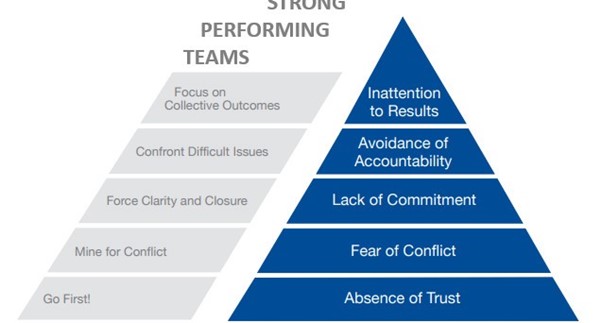
Are You a Contributor Safety Advocate?
Now is the right time to step back and assess your own life. Consider your answers when you assess your progress in implementing inclusion safety.
• Do you work well with other team members to collaborate?
• Do you admire everyone who is successful and educated, or do you also realize that sometimes the most unlikely people have the answers and insights we need?
• Can you truly rejoice in other people’s accomplishments?
• Do you let go of the need to micromanage others?
• Have you ever refused to provide someone contributor safety after they have earned it?
• Do you openly impart your knowledge, talents, and experience?
• Are you emotionally developed enough to no longer require hearing yourself speak?
• Do you recognize the potential in the other team members?
Concrete Actors Who Contribute to Contributor Safety at Work
Understanding Contributor Safety is not enough; you must put specific practices into practice. You can boost Contributor Safety by engaging in these actions, for instance.
1. Alternate who runs meetings.
Giving others the authority to lead team meetings is one of the most effective methods to encourage their participation. Meetings are often led by the team leader, but if you alternate that responsibility, your team members will feel more confident to contribute. Simply assigning them the task indicates that they are capable of finishing it. Of course, you’ll need to assist them in creating the agenda and provide guidance as they go.
2. Define roles.
Greater teamwork is required as complexity increases, yet increased role ambiguity leads to presumptions about how people should contribute. Clarify duties up front to ease tension and uncertainty. To ensure role clarity, you must repeat this process on a regular basis.
3. Realize your successes.
Although success on its own is a reward, getting sincere praise from your peers makes it even more satisfying. Recognize your team’s accomplishments as a leader as soon as possible. Never hesitate, and never miss the chance. the accomplishments of others and exhibit sincere enthusiasm for their success.
4. Avoid correcting with rage, blame, or embarrassment.
It won’t always work out perfectly. People make mistakes, and occasionally those errors are the result of laziness and complacency. Even then, don’t correct with resentment, blame, or embarrassment. Any form of public jeering is forbidden. Instead, encourage the individual to acknowledge their errors and assist them in accepting responsibility. Even direct, constructive criticism can be delivered in a polite manner.
5. Recognize the stall points.
There are instances when your team members are unsure about how to proceed or what to do, and they might feel ashamed to ask. Make an effort to foresee and pinpoint this moment. Engage with them and ask them what you should do next rather than making them feel bad about it. Make it secure for them to be in this impasse.
6. Celebrate modest victories.
Small victories boost self-esteem and create momentum. A sense of progress is created when your team members see a string of modest victories. Although ultimate victory may be a long way off, minor victories show progress and success along the way. The team members’ motivation to keep providing high-caliber contributions is fueled by the minor victories.
7. Ask instead of telling.
The continuum of coaching for a leader starts with telling and ends with asking. An effective leader employs the whole continuum. Telling people too much leads to dependence and learned helplessness. As much as you can, move toward the ask end. Lead more via questions than through solutions.
8. Share your principles.
Your core values determine who you are and what matters to you. They always lay out how you wish to operate. As you share your beliefs with your team, ask them to do the same for you. This is a crucial initial step in establishing a team’s ground rules and conditions of engagement.
9. Describe your preferred methods of communication and working.
Beyond your principles, let your team know how you like to work and communicate. Share them with the rest of your team as well. Based on our unique personalities, we each have a particular work style and communication preferences. Most of these tastes and inclinations are merely different; they’re not necessarily bad. You’ll be able to collaborate more successfully with your team members if you have a deeper understanding of their working styles and preferences.
10. Set up favorable settings for maximum participation.
In our professional lives, we’ve all experienced moments of peak engagement—moments when we’re in the zone and producing our finest work. When did you experience this? Tell your group about this. Ask them to exchange stories about their most fulfilling moments of engagement. Team members will contribute more as a result of your efforts to help each other reach their peak levels of involvement.
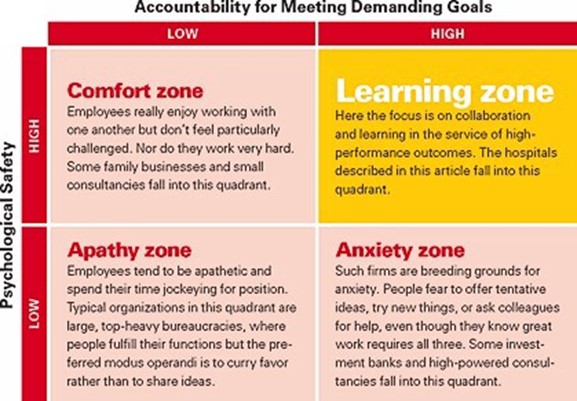
In her book, she explains that when an organization has a high level of psychological safety and accountability, a team operates in a learning zone. High levels of learning and collaboration are fostered in this area. However, the organization enters a state of worry if performance expectations are high while psychological safety is inadequate. A person may have good ideas in this zone, but they would rather not share them.

Exercise 3.5: What’s My Name?

Course Manual 6: Challenger Safety
Challenger Safety: What Is It?
Challenger safety satisfies our innate need to improve things. It gives us the encouragement and self-assurance we require to inquire, “Why do we do it this way?” “May I offer a better way?” or “What if we tried this?” It gives us the confidence to question the established quo without fear of reprisal or the possibility of losing our reputation or place in society. It matches the elevated vulnerability and personal risk connected with questioning the status quo as the highest level of psychological safety. We provide air cover in exchange for candor when we build challenger safety.
When we believe something has to change and it’s time to voice it, Challenger Safety respects and allows us to disagree. It provides us permission to create and be creative while enabling us to resist the pressure to fit in.
If no questions are posed by your team, such as “Why do we do it this way?” or “What if we tried that?,” then your company will continue to have the same failure patterns. You won’t be able to develop quickly enough to stay ahead of your rivals.
The Innovation Process
Because there are basically only two things that happen in organizations—execution and innovation—innovation is ingrained in every role. Execution is what creates value today, but innovation is what determines how to create value tomorrow. Two different sorts of invention exist.
Incremental and derivative innovation is the first category of innovation. Derivative refers to an innovation that is constructed and based on what industries are already doing, while incremental refers to gradual moves based on what businesses have already accomplished or are now accomplishing. In fact, incremental innovation accounts for 99% of all innovation.
The second kind of innovation, which includes hazardous and cutting-edge concepts and experiments, is radical and disruptive. This category includes all additional advancements.
The objective of an organization isn’t always to come up with innovative new concepts, but rather to keep improving and giving their clients value. Although it frequently happens in slow, modest stages over a lengthy period of time, it can sometimes happen in large jumps.
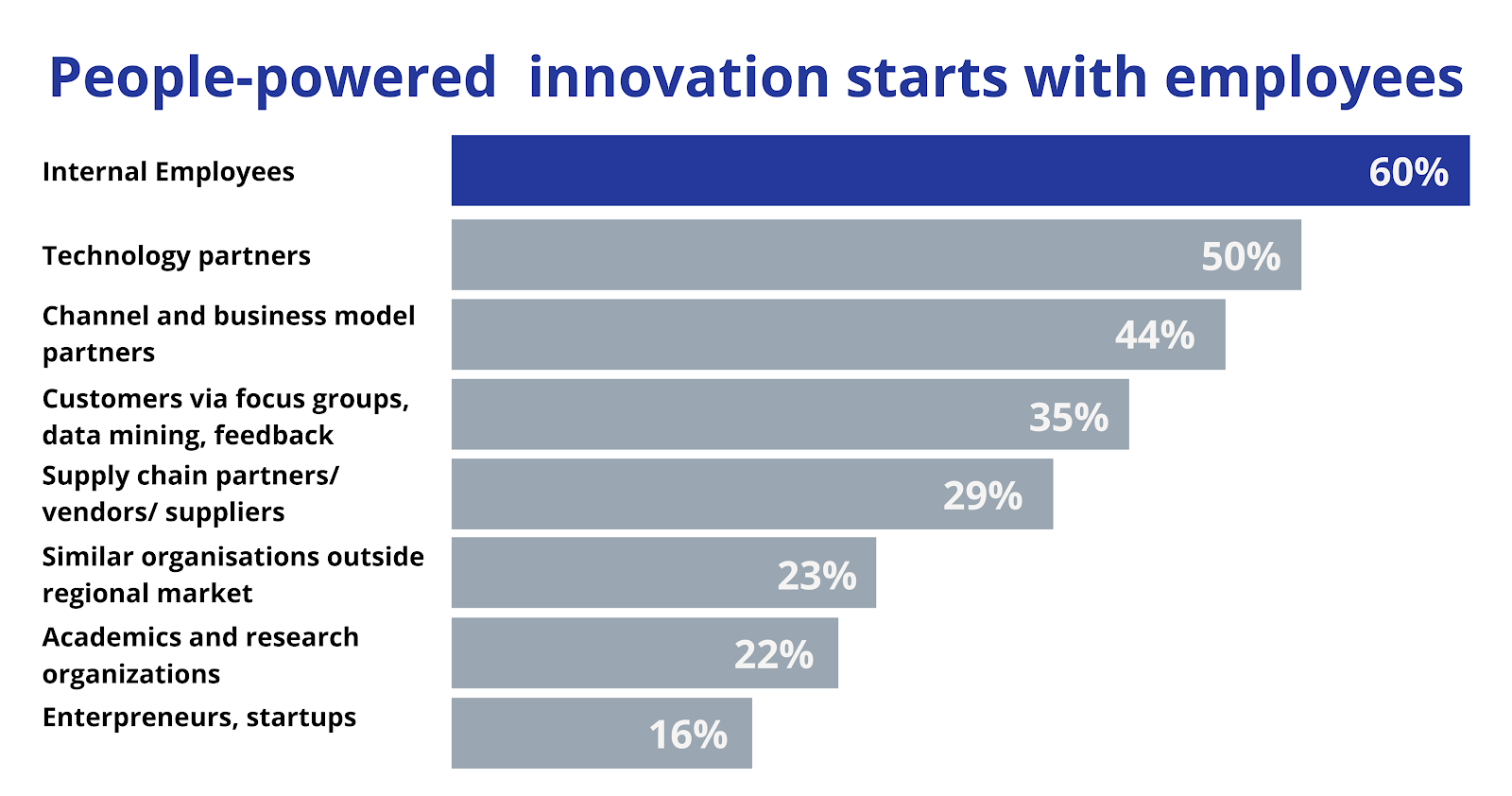
Increase The Social Friction While Reducing The Intellectual Friction
To solve issues, develop solutions, achieve breakthroughs, and, most crucially, innovate, you need intellectual friction. Although social friction must be kept to a minimum, intellectual friction should be as great as possible. You’ll run into trouble if you allow social tension to grow along with intellectual tension. The intellectual friction will eventually be shut down by social friction. Why? Because social friction causes us to become temperamental and protective, which is something that humans have a propensity for.
Dissent Is Formally Assigned
The uniformity of mind is a threat to innovation. How will you defend yourself from it? Dissent must be assigned. Formally defining disagreement enables communities to see and understand their own shortcomings. They are then able to develop and enhance their entire structure as a result of doing this. The best course of action is to designate team members to adopt a divergent stance right away. When disagreement is formally assigned from the start, people might exchange their own risk for institutional acceptance.
Are You a Challenger Safety Advocate?
• Do you accept criticism from others?
• Do you grant them permission to disagree and express dissent?
• When someone offers you constructive criticism or proposes a different course of action, do you become defensive or take it personally?
• Do you remain composed and poised under duress?
• Can you stand a great deal of honesty?
• Can you genuinely engage in a merit-based discussion in a high-stress setting without resorting to personal attacks?
• Can you let down all of your egotistical defenses in team interactions and bring humility?
• Can you maintain high intellectual and low social friction?
• Does your staff welcome inquiries?
• Do you worry about your team being mocked?
• When was the last time you shown courage and questioned the norm?
Challenger Safety at Work: Concrete Behaviors.
Understanding Challenger Safety is not enough; you must put certain practices into practice. You can boost Challenger Safety by engaging in these actions, for instance.
1. Stop pressing the fear button.
People withdraw into quiet and personal risk management in response to fear, which sets off the tendency to self-censor. A leader who instills fear typically does so as a punitive measure motivated by dissatisfaction and insecurity. But more crucially, it’s a surrender of authority.
2. Identify dissent.
You can significantly reduce an individual’s personal risk and replace it with institutional permission if you designate certain team members to question a course of action or point out problems with a suggested decision. This enables intellectual fearlessness to stop being the exception and start being the rule. Make it clear to the team members that you have given them permission to disagree and that you expect them to do so.
3. Persuade others to look beyond their responsibilities.
More opportunities for divergent thinking are created when people are encouraged to leave their tactical and functional silos, enabling them to connect dots that wouldn’t otherwise connect. Naturally, you must carefully monitor the process and recognize when helpful dissent is transitioning to harmful derailment.
4. Be receptive to negative information and disruptive ideas.
You may tell you have a high tolerance for candor and will defend your people’s right to dissent by the way you emotionally react positively to disruptive ideas and unpleasant news.
5. Explain your reasoning if you reject suggestions.
Explain your decision to not adopt a team member’s feedback or recommendation when you do so. Your thoughtful response will encourage the person to continue providing comments.
6. Weigh in last.
When you have positional dominance, speaking first subtly filters your team. Pay close attention, thank those who have contributed, and then express your point of view.
7. Don’t smugly proclaim your authorship.
Let your team know that your thoughts are not superior to anyone else’s. There are occasions when team members show too much respect for the leader’s opinions just because they are the leader. Avoid that, and don’t put too much stock in your own thoughts. Embrace feedback on your own concepts. Reiterate that just because you are the team leader, that doesn’t automatically make your proposals better. Accept the fact that many of your own ideas in the past were fruitless.
8. demonstrate sensitivity.
Keep in mind that being vulnerable means you could suffer injury or lose anything. Others will imitate you if you demonstrate and promote a pattern of vulnerability.
9. Praise gullibility.
Keep in mind that challenger safety must present the person and the team at their greatest level of interpersonal and personal vulnerability. Challenger safety is about developing and then utilizing different viewpoints, even disagreement, without causing hurtful social conflict or emotional escalation. A tendency to disrupt the status quo will become the norm if you reward it. Encourage them as you lead them through the vulnerability using your positional power.
10. Reward goals scored.
This entails encouraging and praising your team members when they make an effort to disrupt the status quo. Not every proposal or suggestion will be good, but if you promote tries (shots on goals), you’ll get more of them and are more likely to have some worthwhile challenges (goals) that advance the team.

Case Study: Amazon
The American online behemoth Amazon is not exactly renowned as a friendly, considerate employer for its staff. The society is cutthroatly competitive. Hard agreements and ice cold numbers rule everything. However, the company culture promotes open communication amongst coworkers.
At Amazon, transparency and honesty are the norm. Political games are not permitted, and you should never try to hide behind others. People are supposed to be brave around one another. that they discuss and disagree with one another. that they acknowledge their errors and take all appropriate steps to learn from them. Knowledge is spontaneously exchanged between people, and new concepts are voluntarily put forth. Sincere discussions serve as the cornerstone upon which the success of the business is based.
Jeff Bezos, the founder and CEO of Amazon, is directly accountable for this. On the nameplate of his study, it reads, “Tell me even more candidly.” Bezos does not feel the need to surround himself with yes men, in contrast to his directors. He is seeking individuals with various viewpoints and creative ideas. There is only one requirement: all statements must be supported by verifiable evidence. Avoid making assertions based solely on what you think or feel.
The anecdote that follows demonstrates how this actually functions. Bezos happily declares during a meeting with his top management that the site’s turnover is exploding in accordance with the new data system. Marilyn, who was invited to the meeting once and is in charge of managing sales in the warehouse, finds it hard to accept what she is hearing. The numbers are at least two to three times exaggerated. Marylin speaks calmly while all present celebrate the boost in sales.
She says, “Jeff, those figures don’t stack up.”
Bezos responds, “But they come straight from the database.”
Marylin insists, “Yet they don’t add up.”
Whether she is able to support her claims? Marylin reads aloud from some warehouse data listings she has taken out of her backpack. The meeting room is unusually quiet for a brief period of time. In the end, it becomes apparent that the data system did not evaluate the actual purchases but rather the contents of the virtual shopping carts. The programmers failed to account for the fact that many customers placed more items in their shopping basket than they ultimately purchased. Marylin kept everyone on edge to ensure that the mistake was immediately fixed.
You identify a problem, make it public, and then make an effort to fix it—it seems like the most natural thing in the world. Additionally, you carry out that action in front of the top boss. How difficult can it be? According to research findings, quite challenging. In the US, 85% of workers claim they struggle to communicate their own opinions and bring up mistakes on their own. The Netherlands has a smaller rate, yet it is still 69%. The root of the problem is a lack of courage to speak up, even if it means that you can influence something.

Exercise 3.6: Office Debates

Course Manual 7: Fear
Avoid Letting Fear Ruin Your Team By Learning To Control It And Adapt
In many respects, we need a healthy dosage of fear to survive.
Fear keeps us from doing things like teetering on the edge of a cliff or crossing busy streets.
Fear, which has its roots in the amygdala, is a crucial element of wise decision-making.
But like with any emotion, moderation and management are crucial.
Our worries take over if we are unable to manage them.
We cease taking chances. We take in. We become unmoving.
On the other side, when we are not afraid, we act carelessly as if there are no repercussions.
The same thing occurs across teams, and it can undermine the success of an entire business.
More Than You Would Realize, Your Team Is Anxious
Do you know which team members are anxious? Chester Elton and Adrian Gostick, authors of Anxiety at Work: 8 Strategies to Help Teams Build Resilience, Handle Uncertainty, and Get Stuff Done, advise against assuming you can tell. According to Elton, only one in ten of the 18% of people who were living with an anxiety problem felt comfortable discussing it with their manager before the pandemic. This is amazing when you compare mental health to physical health because, in the words of Gostick, “You can’t imagine 20% of your workforce walking around with a broken leg and they don’t talk about.”
In order to avoid being passed over for raises, promotions, and great assignments—not to mention the danger of losing their social standing or being shunned by coworkers—many persons with anxiety decide not to report the problem at work. However, because anxiety is so pervasive in society, employers must take action to attract and keep workers. Here are six suggestions to help you identify which team members require your assistance in managing their anxiety and how to do it.

How Fear is Keeping Your Workplace Paralyzed
On a sailboat, terror can be felt all around us due to the turbulent ocean, strong winds, and the unknown.
Even relying on fellow sailors can be frightening because what if we can’t rely on them to make the proper decision in choppy waters?
Any business is the same in this regard. Everyday worries for workers include dissatisfied customers, reprimands from superiors, disappointing coworkers, and possible layoffs.
If these worries aren’t addressed and managed, they can paralyze a company like they might on a sailboat.
We are unable to make logical conclusions when we are afraid. Long-term fear can affect memory, emotions, and other psychological functions.
Consider the fight-or-flight reaction.
It’s helpful if you unintentionally walk onto the road, spot a car coming your way, and swiftly cross the street. However, sustaining a fight-or-flight response would result in severe generalized anxiety since everything would seem dangerous.
Even when our fight-or-flight response takes over, we don’t want it to entirely impair our decision-making and control our behavior. Jumping into another lane of moving traffic while trying to dodge a car won’t help.
What Does Organizational Behavior Look Like When It Has Fear?
Burnout develops over time as a result of continued fear mishandling.
Fear spreads easily. On a ship, we’ll quarantine a sick seaman to keep the rest of the crew from becoming infected. A calamity would be an outbreak aboard a ship at sea.
Fear is contagious inside a company. It affects specific employees, divisions, roles, procedures, connections, and revenue.
Here is how a firm could manifest a fear outbreak:
• Personal fears include: alienating oneself from objectives and results, disappointing coworkers, missing deadlines, being unprepared for meetings, etc.
• Fears in the workplace include: frequent departmental conflict, ambiguous goals, low confidence, dishonest communication, low morale, etc.
• Existential concerns include: uncertain markets and economic prospects, automation and AI, shifting cultural norms, job losses, etc.
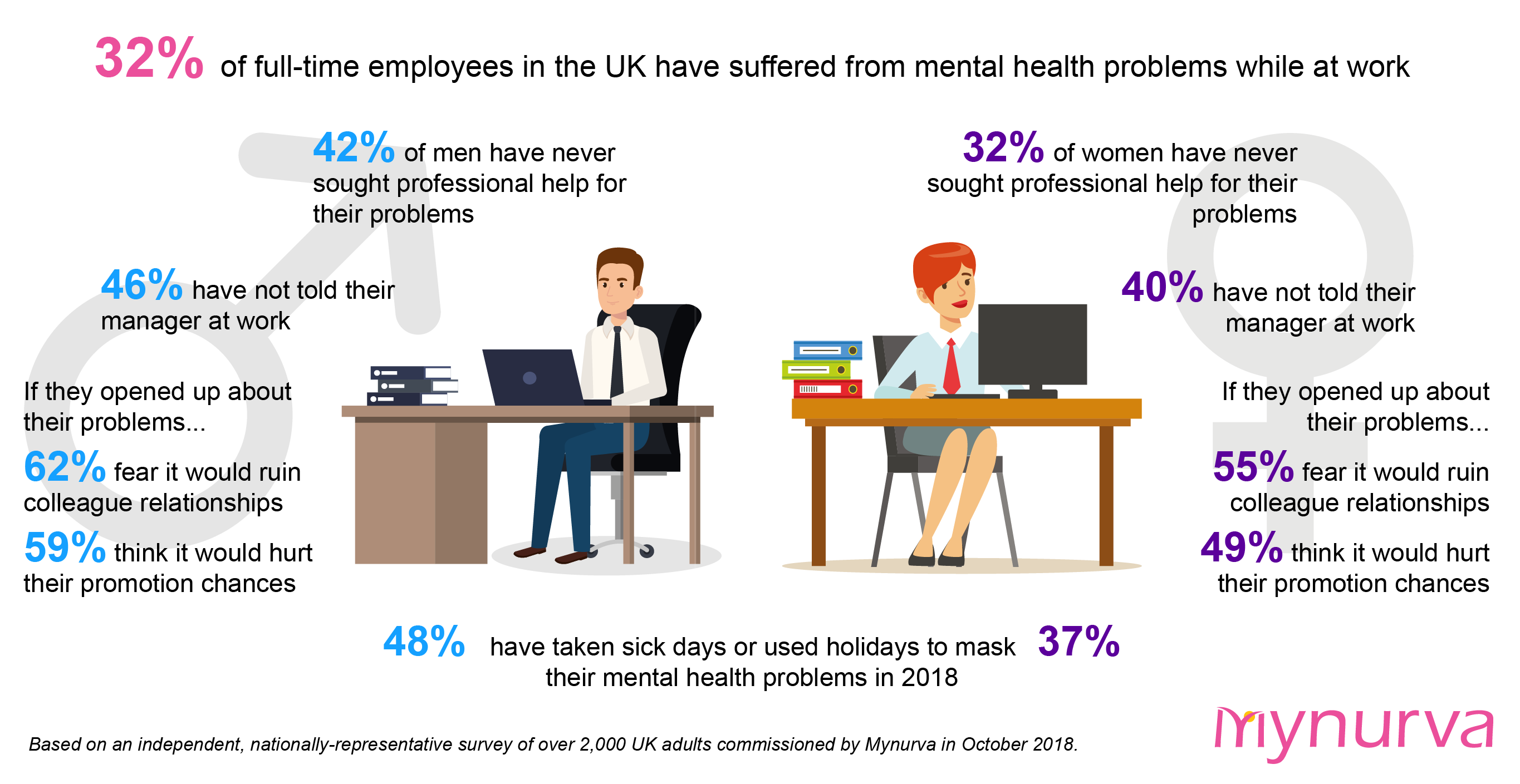

Case Study: HubSpot
According to chief people officer Katie Burke, the Boston-based sales and marketing company HubSpot launched an anti-burnout effort last year in part because quarterly staff surveys started to indicate that the pandemic’s persistent “ambiguity and uncertainty” were seriously affecting individuals. The company eliminated Friday internal meetings, provided training for managers who wanted to better support their teams, announced an annual “week of rest” for the entire staff, and provided resilience workshops to all employees. This allowed everyone to take a break without returning to a deluge of emails.
Burke claims that the company is “looking at the things that cause the most stress for people” and working to find solutions, such as standardizing workloads year-round (instead of having busy and light seasons), automating certain tasks, delaying deadlines for non-urgent products, and assisting people in determining how much they can realistically accomplish in a given amount of time. Burke claims that “we are seeing [the outcomes] in how happy and engaged our staff are, as well as honestly just in the anecdotal comments we’re hearing from individuals.”
5 Techniques and Strategies for Managing Fear and Preventing Sabotage
You can’t totally get away from fear. It’s a sensible response to unpredictability and risk.
Instead, concentrate on facing and controlling your fear. Transform your fear into a tool for cooperation, commitment, and development.
1. Prioritize Psychological Safety
Everyone has had times when they feel psychologically uncomfortable.
Verbal abuse, gaslighting, emotional blackmail, and lying all have negative effects. We develop maladaptive coping mechanisms and adopt learned helplessness over time. We cease establishing limits and speaking up.
Lack of psychological safety is hazardous at sea. Imagine if the first mate failed to warn the captain of an approaching iceberg because he was frightened of upsetting people. The Titanic sank in this manner!
In the workplace, the same holds true. A person won’t speak up if they are worried about getting in trouble or attacked.
A psychologically secure setting is one that:
• When something is wrong, people feel compelled to speak up.
• People are made to answer for their deeds.
• Even though disagreements might be hostile, not all disagreements are.
• It is not considered bothersome or bad manners to ask for assistance.
• Risks and decisions are made with the organization’s best interests in mind.
It’s not about making a place where everybody may act or say anything they want without repercussions. It is not safe for others if someone feel psychologically secure enough to act rudely or offer harmful advice.
Accountability is essential because of this.
2. Create a culture of strength-based organizational behavior
Everyone despises performance evaluations, right?
Why? Employee evaluations and performance reviews may be intimidating experiences. They trigger several forms of anxiety, including
• Have I made enough progress this year?
• Are layoffs expected?
• Is my increase in jeopardy?
• What went wrong this time, exactly?
Nobody likes having their vulnerabilities brought to their attention, this may come as a surprise. We all have areas that we might stand to get stronger in. Why are flaws even important to correct unless they consistently make other people’s life more difficult?
Instead, overcome fear by concentrating on your advantages.
Consult team members on their strengths and weaknesses.
Teams succeed best when everyone plays to their personal strengths, whether on a sailboat or at business.
This does not imply, however, that we should overlook serious flaws in order to spare someone’s feelings. However, by encouraging the utilization of someone’s talents right away, we can typically prevent a circumstance where their flaws are on full display.
3. Encourage healthy conflict and responsibility
Too often, conflict is portrayed negatively.
Everybody has witnessed partnerships between partners who never argue. It almost seems supernatural because nobody can escape fighting forever.
A lack of confrontation typically indicates that people aren’t raising issues.
These issues merely bubble away until they pressurize and blow up.
People avoid fighting because they are afraid of:
• being assaulted or yelled at
• causing emotional harm to another person
• appearing foolish or sentimental
• not enforcing limits
A worker is frequently ready to voice their complaints at first. They eventually stop speaking out when no one is held accountable, boundaries are broken, and nothing changes. What is the purpose?
Conflict changes for the better when two things occur:
• People have faith that speaking up won’t result in attack or hardship for anyone.
• Respectfully, others are made accountable for their words and deeds.
4. Obtain their trust and discover their fears
We cannot believe that after years of negative experiences, people will suddenly feel confident speaking up.
We must inquire about their anxieties if we wish to know what they are.
Trust must be earned over time. Before speaking up, people need to feel like their opinions will be appreciated. They must have confidence that leaders will respond honestly and openly.
Team-building activities are great instruments for kicking off a new culture focused on trust.
Leaders and teams must collaborate in ways they have never done before to achieve a single goal while sailing on wide ocean.
Teams can use the fundamentals of trust at work by bringing their new mindset with them.
Trust is crucial.
5. Offer stability and transparency during tumultuous times
Right now, all of us are in choppy waters with no clear end in sight.
Employees are concerned about acquisitions, automation, economic downturns, and layoffs.
They owe leadership stability and openness.
Say so if you are unsure of something. Do not sugarcoat the truth.
Routines and rituals can also contribute to building a rock of stability in choppy waters. Your guiding light is routine.
Science demonstrates that routines, no matter how tiny, help us to relax. When everything seems to be beyond our control, they provide some measure of control.
Consult a sailor. They’ll share with you their favorite pre-departure rituals, such as wearing a particular headgear or donning a life jacket in a particular way.
Do not let fear rule your life or the behavior of your organization.
We’ve witnessed several companies on the verge of failing due to widespread fear. Business leaders can change the culture of their entire firm by encouraging steward leadership.
It won’t happen immediately. It takes time, effort, and dedication to establish a successful team, especially for those in leadership roles.

Exercise 3.7: Fear in a Hat

Course Manual 8: No-Blame Culture
No Blame Culture for High Performance Organizations
An initiative can only be successful in a large matrixed organization if cross-functional teams collaborate and have a single goal. High performance organizations place a premium on how each team handles setbacks and bounces back from them. Blame-based leadership identifies a bad individual so that someone can take the blame and others can escape punishment. You are operating in a blame-based culture when you see someone being blamed in your teams for not being able to accomplish planned goals or when anything fails in the team because of a person or a group.
No-blame cultures sound sensible in conversations but are challenging to implement. A typical human propensity is to assign blame for problems on others in an effort to ease personal pressure; nevertheless, this leads to no one taking ownership of the issue, which keeps it from being resolved. Blaming gives some of us a sense of power and prevents us from having to consider our own contribution to the issue. A more challenging circumstance is when responsibility is assigned but no one even realizes it.
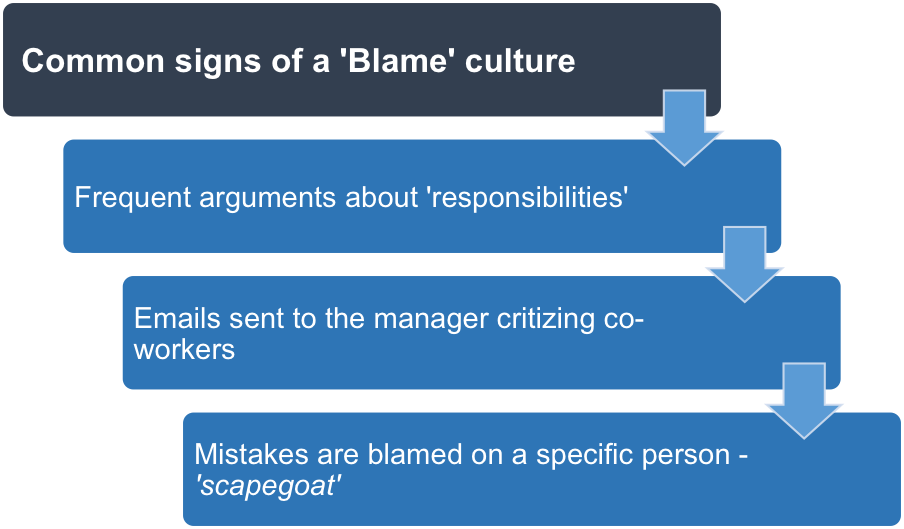
Organizations with a zero-blame culture include hospitals and airlines because even the smallest mistakes can have disastrous results. Due to how disastrous errors may be in these businesses, the airline industry receives the majority of citations. It is risky to do business in an environment where employees don’t feel secure enough to report mistakes that have been committed or voice worries about shortcomings that could lead to mistakes in the future.

Case Study: Mercedes Benz F1
The secret behind the Mercedes Benz F1 team’s seven consecutive constructors titles by 2020 is the team’s very strong No Blame culture, which has been ingrained in the organization. James Allison, the team’s technical director, said that “Pointing a finger at people and saying they’re to blame for something is verboten in our world”
John Owens, the principal designer for the Mercedes F1 Team, continued by going into further detail. “Culture is everything. If you have a team where people feel afraid to make mistakes, or afraid to try for fear of how they might be viewed or, even worse, whether they keep their job, all those kinds of things promote a culture of conservatism in design and approach to problems.”
Lewis Hamilton was in contention to win the 2017 Azerbaijan Grand Prix until a loose headrest forced him to pit, which dropped him to P5. John Owens recalls that Toto Wolff, the team’s principal and CEO, stated, “I will not name an individual,” which is absolutely correct. He went on to say, “Because my department could have designed something that couldn’t have been possible to be put in wrong, or someone could have double-checked it – there’s so many reasons why something happens. And to sort of try and single out one person, it’s just not our culture.”
Leaders and every employee of the company are constantly working to create a culture where there is no room for blame. In creating this culture, it is important to take into account:
a) Differentiate between responsibility and blame
We can better appreciate the distinction between blame and accountability with the aid of a lexicon. To blame is to place the blame for a negative or unfavorable event or phenomena on Being entirely accountable for results—good or bad—and having the ability to explain decisions and results in a transparent manner are all parts of being accountable.
We have all heard the expression “they need to be held accountable” in reference to the person responsible for the unfortunate incident or error. In this situation, only one person’s actions are being closely monitored, which is known as “selective accountability.”
Blame is frequently allocated before all the information is examined and thinks that it is people, not the systems in which they function, that are the issue. In order to address the bad behavior, the focus of blame is on finding the culprit and punishing them. Blaming offers a quick and artificial answer to a challenging issue.
A focus on accountability acknowledges that everyone has the potential to make mistakes or break promises. Accountable staff members internalize the company’s mission and strive to realize it via their work. They are self-assured enough in their abilities to take on challenging job, sometimes failing, but using the lessons learnt to produce better outcomes in the future.

b) In the mirror, face your fears.
A leader cannot expect his or her team to adopt new behaviors while continuing to operate under the old blame-based paradigm. Because of this, the first step in developing a culture of no blame is for the leader to examine his own propensity for blaming others and the underlying fear that motivates it. Fear of failing, fear of being unprepared, fear of not being in charge, and fear of accepting responsibility are a few typical offenders.
The leader needs to decide which habits to alter in order to provide a better example once those anxieties have been identified. A fearless leader takes responsibility for his errors and sets an example.
c) Embrace making errors and take the lessons from them.
“Where no problem is perceived, there can be no improvement,” says the Kaizen Institute. Never forget that we are all still learning how to do our professions better, and that the greatest way to achieve this is to make errors. Most crucial, let those you lead know that you believe as you do.
Yacht racer turned businessman Mark Turner served as CEO of Volvo Ocean Race and used his leadership style to revolutionize the organization.
He claims ” This is the number one culture problem in many organizations: blame.
If you’re not making mistakes, you’re not pushing the boundaries of performance hard enough. You also need to create an atmosphere where people are not afraid to share their views, so they bring new solutions to the table.” When a project fails or a team performs poorly, for example, there is comprehensive accountability and not just one person’s actions are highlighted.
Businesses that are committed to improving have established procedures for reporting errors, reviewing them, and learning from them. Employees are invited to publish their blunders and lessons learned on certain organizations’ MISTAKES WALL. This fosters transparency and trust inside the organization.
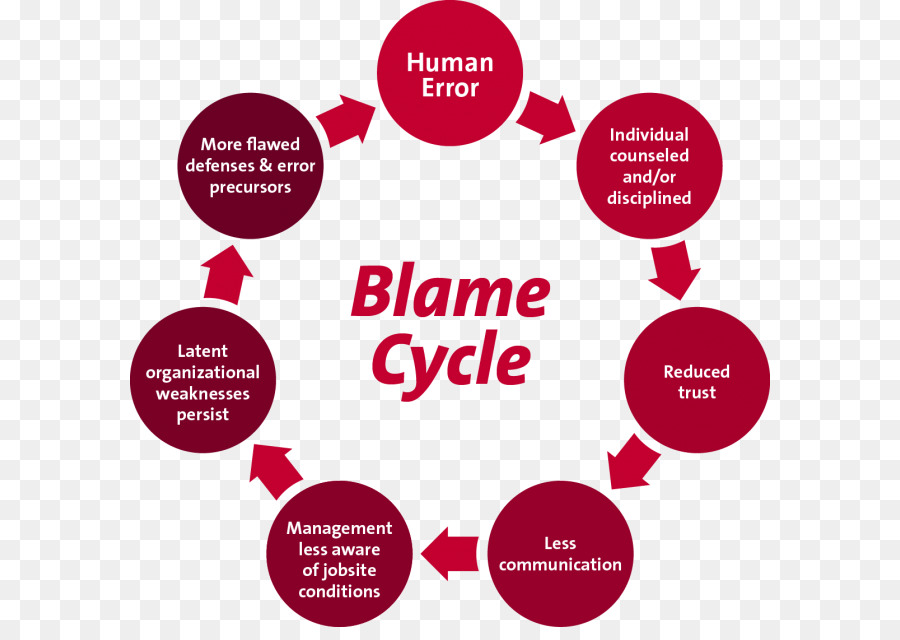
d) Affirm the good faith of others
Each of us has a propensity to think that our actions are reasonable in this situation. Recognize that people are acting logically from their own perspective – they are doing the best they can given what they know, the pressures they are experiencing, and the organizational structures that are impacting them. Assume the best about other people.
Unfortunately, even when a systemic reason is present, people tend to blame individuals for mistakes. Make an effort to educate staff members about the complexity of your organizations so they may more accurately attribute errors to systemic factors.
e) Lead with curiosity and be aware of your feelings
Making decisions as a team leader is simple when no one can contest your authority. Don’t presume to know all the details. Sincere inquiries that are motivated by a desire to learn are less likely to elicit a defensive response.
Once the individual on the receiving end detects angry and agitated tones, feedback and guidance become blame. They will probably interpret the anger as blame even if it is not directed at the person responsible for the outcomes.
It’s possible that your actions are having unforeseen consequences and are influencing other people’s behavior. Remember that you have a propensity to minimize the viewpoint of others in order to justify your own actions and beliefs.
f) Cultivate ties with employees outside of the workplace
Beyond the regular job we conduct, it is crucial for the team to develop an understanding of one other’s belief systems. Going on a walk or participating in team-building activities like a bowling night can help people better understand one another’s perspectives and worldviews, which might make them friends who otherwise might not have been. Due to their close friendship, they will be less likely to point the finger at one another if something like this occurs. At that time, a manager is more likely to observe cooperation and trust than malice and accusation.
g) Establish a shared purpose and vision.
Beyond excel spreadsheets, powerpoint presentations, and monetary goals, leaders must convey the team’s overall mission. The team must comprehend their mission statement and north star in order to function effectively.
Groups occasionally operate toward different goals, which may result in a blame game, when corporate goals, strategies, and values are unclear. Leaders must express clearly what is important to them, how they operate, and what is expected of them in that capacity.
Advantages Of A No-Blame Culture
An organization’s internal relationships are strengthened by a no-blame culture, which promotes candor and openness. Customers gain from trust-building within a business since they will receive higher-quality services and more fruitful connections.
Final Reflections
We need to have faith in our abilities, personal fortitude, and high self-esteem as a team and as leaders enabling the teams to tolerate failures. In the team, we must be willing to take responsibility for our errors.
The leaders of a no-blame culture must engage in extensive self-reflection and study of their own attitudes and actions. An organization and its customers can only be transformed by a team that is willing to accept the challenge of changing itself first.

Exercise 3.8: Dumbest Idea First

Course Manual 9: Failure
What do Silly Putty, pacemakers, Post-It Notes, potato chips, and penicillin have in common?
They were all the result of errors. In reality, the inventor believed that his final creation had failed in each instance because he was actually trying to make something entirely different. Of course, with time and money passing by, we may see that these supposedly unsuccessful endeavors were actually successes. It reminds me of the classic saying about Thomas Edison and the light bulb: When asked about his numerous failures, he said that he hadn’t actually failed 10,000 times, but rather had discovered 10,000 different approaches that wouldn’t work.
Failure, blunders, and accidents all play a crucial role in assisting staff members in learning and developing. Organizations, regrettably, penalize errors and produce workers who are risk averse and too timid or anxious to try anything new. The finest businesses support failure, value unconventional thinking, and let staff members make mistakes and learn from them.
Failure Actually Expands Your Brain
When you make a mistake, your brain goes through some remarkable changes. Your brain starts gathering information about the encounter and reportedly becomes larger throughout the learning situation, according to a report in Scientific American. And even while the brain shrinks back to almost its former size after a learning event, it still creates new neural connections by ingesting fresh information and accumulating the most important lessons learned through trial and error. By maturing the brain, mistakes produce more effective connections and fundamentally different neurons. In other words, failure can increase your intelligence.
Leadership Must Promote Errors
Yes, at first glance this could seem ridiculous, but our leadership team supports this outlook. We’ve discovered that it provides staff members the courage to attempt new things and the freedom to fail once without feeling horrible about it. The most effective marketers constantly test out new concepts, identify those that fall flat, and then adopt one or two that stay and produce results. Applying this to our company has led us to the realization that this similar mindset, when used in business management, fosters employee happiness on a deeper level and promotes significantly more innovation.
But how does a company transition from a setting where errors are frowned upon to one where they are celebrated and encouraged? A safer environment where employees feel empowered to attempt something new can be created by making a few critical modifications to the ecosystem of your culture.

Case Study
The experience of Steve, a project manager for a sizable construction company, serves as a good illustration of how a setback can be turned into an opportunity. Steve had a fruitful career and was looking forward to a promising future. But he experienced a crisis of confidence after a project he had overseen failed and cost millions of dollars. The project failed for a variety of reasons, including underbidding and underestimating the expense of the task, doing the work in an unfamiliar market, and dealing with a picky and difficult client. If anything, the project wasn’t a worse failure than it actually was because to Steve’s leadership. He didn’t see it that way, though. He began to doubt himself as he began to personalize his failure. He got considerably more timid and hesitant.
Fortunately, Wayne, a seasoned leader who appreciated the value of a good failure, was Steve’s boss. Wayne was familiar with Steve’s struggles because he had encountered enough setbacks along the way. Wayne was aware that it is tempting to cut back, hide, and take on lesser initiatives following a failure. Wayne also understood that if Steve allowed himself to become smaller, he may grow accustomed to meeting a lower bar for success. Despite the recent setback, Steve was a competent and talented man.
Wayne then did what? He assigned Steve to oversee a significant, intricate project that the business had just won. There was a lot of money at stake because the project was one of the biggest in the business’s history. Note that Steve’s recent setback and the need to move past it were what made him a good fit for the current opportunity. Redeeming himself—both in the eyes of his employer and in his own eyes—was what Steve really needed. If Wayne allowed Steve to accept becoming a smaller version of himself, he would never hold himself accountable to the professional person he was capable of becoming. Leaders blunder. It is inherent in the situation. Steve would benefit much from managing a large, difficult, and complex project in order to apply the lessons he had learnt from his earlier failure.
1. Set a good example.
Management must set the example for staff if they are to understand that failure is welcomed. Organizational leaders must not only emphasize the value of experimenting with new approaches, but also accept and even encourage others to do the same. Although a top-down mentality change may be necessary, keep in mind that employees will follow their managers’ lead.
2. Encourage openness.
Employees should feel at ease sharing ideas across departments and platforms. The desire to hide or cover up mistakes is somewhat diminished in the workplace through transparency. In the end, if everyone feels at ease discussing ideas and mistakes, it establishes a precedent that it’s no big thing and that all employees may benefit from one another’s accomplishments and mistakes. Slack is a tool that we use at our company so that everyone on the team can communicate new ideas, see what projects each department is working on, and always be aware of the company’s overall direction.
3. Promoting “fast failure”
Inform staff members that they should act swiftly if they plan to try anything new (and perhaps fail). That doesn’t necessary entail coming up with ideas quickly; rather, it just means testing something novel before moving forward with significant development. An employee may draft an outline and solicit feedback as opposed to writing a 50-page manual, for instance, to determine whether she is on the correct route. In this manner, if it does turn out to be a failure, fewer resources were expended, and the worker can simply switch to an alternative option.
4. Simulate things.
Use simulations to give staff members a safe environment to practice making judgments if they are hesitant to do so in the real world. It’s easy to recognize some simulations, such learning how to utilize a new piece of equipment. However, scenarios and simulations can also be used to test ideas, such as brand-new sales strategies or team-building activities. Employees are more likely to speak up and offer suggestions when they are aware that the stakes are minimal.
Your team is a goldmine of information, experience, creativity, and innovation whether you’re attempting to develop the next potato chip or improve customer pleasure. Unfortunately, your organization won’t gain from that if they feel restrained or afraid to make mistakes. Your business can formally transform into a center of higher learning by promoting failure and all of the advantages that result from making mistakes.
How Failure Is Encouraged at Work to Boost Employee Engagement
Expecting perfection from your workers can be discouraging to the whole team and bad for the workplace atmosphere. When workers feel that failure in their jobs is not an option, they burn out and lose interest in their jobs.
Your employees must feel comfortable trying new things in order to succeed. Accepting employee failure at work can improve company morale, raise employee engagement, and greatly enhance innovation.
In our podcast, “Team Building Saves the World,” Chief Creative Officer at The Game Agency Stephen Baer explained:
You don’t want someone to say, “Well, I got that wrong, too bad,” at the end of the day. You want someone to admit, “I think if I try again, I might be able to get that right.
To learn more from Stephen Baer about the value of gamifying employee training and how to foster a more positive workplace culture, listen to the whole Keeping Employee Engagement Fun episode.
The Foundation Of Success Is Failure
It’s far too simple to focus only on the short term when analyzing a worker’s lack of quick success. Indeed, mistakes can be expensive. They use up firm resources, and since there is no immediate profit, they could appear like unacceptable losses.
Individual failures, however, become considerably less important when considering employee failure from a larger perspective. It is much better to view errors as stepping stones to achievement rather than as a liability to the business.
The Wright Brothers faced numerous obstacles in their quest to create the first motor-powered airplane. Unexpected failures forced them to start over even when they were certain that success was around around the corner. They didn’t just give up after each failure; instead, they saw it as an opportunity to grow.
The world of today is no different. Businesses that instill a culture of fear in their workers often lose ground to innovative rivals that encourage staff to try new things and take calculated risks.
The Advantages of Fostering Failure at Work
Employees who are anxious about failing are more prone to face excessive stress, worry, and pressure at work. With 61% of respondents saying they experience stress at work, the American Psychological Association ranks employment as the third most prevalent source of stress for Americans.
Even if the fear of failure cannot be linked to all work-related stress, it does play a substantial part. Even worse, stressed-out and anxious employees are less likely to be creative or eager to contribute to the success of the organization.
Giving workers room to fail encourages the innovations a business needs to prosper in this fast-paced world. Employees must feel safe even if their experiments and risks don’t have the desired results in order to motivate them to experiment and take chances.
Additionally, when workers fail, they learn new skills that help them play a more significant role in the organization. They begin to think more imaginatively and start seeking novel answers.
According to Stephen Baer, “When employees are allowed to fail, they try out stuff to see what works. And, hopefully, they get smarter and better in a safe zone.”

Exercise 3.9: News Piece

Course Manual 10: Manager’s Role
How Management Affects Psychological Safety
What occurs when a manager fails to display the behaviors necessary to promote an effective atmosphere of psychological safety?
There are already a lot of postings and discussion articles available on the value of psychological safety. Instead, We wanted to concentrate only on the part a manager can play in this intricate dance in this piece.
We also won’t go into the advantages of a psychologically safe workplace in this article because the evidence is overwhelming that such teams perform better, produce better business and customer outcomes, are easier to recruit and retain, are more collaborative, engaged, and creative, among other benefits.
Let’s Discuss Finances
Without first broaching the unpleasant subject of pay and benefits, we cannot begin to discuss psychological safety. It’s important to note that although though it’s not directly related to psychological safety, if your employees are not compensated adequately for the work they do, you will never be able to maximize the results. Drive by Daniel Pink makes the point that for people to be intrinsically driven to work. Go solve that first if you are not paying enough for folks to simply show up and do their best work.
Leaders vs. Managers
For the sake of this piece, we are focused on “those in control of people,” i.e., “managers,” “senior managers,” etc. We won’t get mired down in this. Please feel free to refer to these individuals as managers or leaders here, but the attention is ultimately on those who are responsible for looking after others.
The Manager’s Responsibility for Psychological Safety
“Effective management” makes a significant difference in how successfully some teams maintain psychological safety compared to others. In other words, you don’t have to be a part of a psychologically safe organization to have a team that acts and behaves in a psychologically safe manner, as Amy Edmondson emphasizes. However, the manager is one of the most important factors that sets a team apart.
“The most important influence on Psychological Safety is the nearest manager, supervisor, or boss.” (2012) Edmondson.
Each of us must be willing to step into interpersonal danger in order to establish an atmosphere where we may exhibit the behaviors required for psychological safety. Psychological safety is very much a “we” problem.
This article focuses on the behaviors that might maximize and magnify a team’s potential to develop a psychologically secure environment. However, the manager of any team plays an enormously outsized role in this.
It is important to note that your value addition for your organization has changed from direct (as it was when you worked as an individual contributor) to indirect in your capacity as a manager. It’s about fostering environments, expanding, encouraging, testing, and growing your teams, and maximizing the context for their work.

Case Study: Clarus Commerce
Clarus Commerce’s CEO, Tom Caporaso, has an unconventional management style. His entire concept is similar to that of a successful sports team: recruit quality players; train, practice, and prepare; encourage teammates to support one another, learn from their errors, and accept wins and losses as a team; get off the field and allow the players to play. There are just a few occasions when a manager will intervene after play has started or after individuals have shown they are capable of handling tasks independently. Goals and finances at Clarus determine the playing field. It is up to the staff to carry out their duties within these restrictions. Clarus is now empowered to act swiftly in response to local situations and diligently address shifting client needs.
Of course, managers must acknowledge that employees will periodically fail when they allow them to work within and somewhat beyond their capacities. Failures are a fact of life for the best businesses and essential for both individual and organizational growth. Such businesses normalize the acceptance of recurring failures as a result.
To Begin With, This Isn’t About Being “Kind”
According to definitions from Amy Edmondson (high psychological safety, high accountability), Timothy Clark, or others in the field (inclusion, learner, contributor, and challenger safety), the highest-performing teams display specific characteristics. Psychological safety without some form of high accountability or challenge will leave employees unfulfilled and is not maximising returns for your organization — it is essentially leaving money on the table.
Starting with the behaviors that foster trust in you as a manager has no drawbacks for newly established teams or those starting from scratch. For the teams to finally perform at their best, it is important to set an example of candor, feedback, challenge, and curiosity alongside it.
Your Behaviors Reflect Your Culture
The foundations of our team culture are ultimately what we are referring to when we discuss psychological safety. Let’s examine the test questions Amy Edmondson used to gauge psychological safety.
1. On this team, mistakes are frequently used against you.
2. This team’s members have the ability to bring up difficult problems.
3. On this squad, people occasionally reject others for being unique.
4. You may gamble on this team with confidence.
5. It is challenging to request assistance from other team members.
6. No one on this team would purposefully take actions that would interfere with my efforts.
7. My own abilities and skills are appreciated and used when working with the other members of this team.
We may all recall teams from our prior employment where responding positively to this question wasn’t always easy. We weren’t performing at our peak, we likely didn’t voice our concerns or ask for assistance, we probably felt some level of dread, and we most definitely weren’t “bringing our complete selves” to work.
The majority of these inquiries are influenced by manager behaviors in a direct and significant way from the outset.
“The culture of any organisation is shaped by the worst behaviour the leader is willing to tolerate” (Gruenter & Whitaker, 2015).
When thinking about management behaviors, we might also substitute the term “create” for “tolerate” in this sentence. Your organization’s values and expectations are nothing more than motivational slogans on the wall if staff are shouted at, disrespect is present in the team, underperformance is allowed to continue, or questionable practices are not addressed. Your culture is not represented by these artifacts, but rather by the observed behaviors you observe.
In his study of human aspects in system safety, Dr. Ron Westrum outlined three unique organizational cultures:
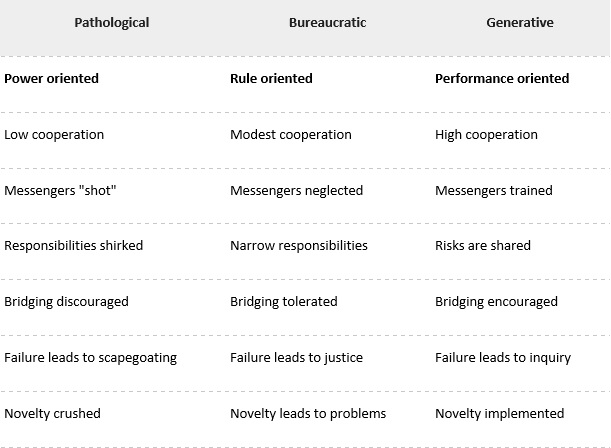
It won’t surprise anyone to see behaviors in each that have been greatly emphasized and defined by managers.
Where Ought A Manager To Begin?
We’ve written a little bit about manager behaviors in the past, and we could start much worse than with some of the fundamentals. You’ll be on the correct track by defaulting to servant leadership in this situation. If you foster the proper climate as a manager, you won’t necessarily need to be in charge of or on top of everything. Your team will have some autonomy and authority, and it will act in ways that help it achieve its goals.
A participative, collaborative “Theory Y” approach to people is also a fantastic basis, if you have addressed the needs to organically inspire individuals (Autonomy, Mastery, and Purpose).
Even clever people require the proper management and setting.
The qualities that were essential to good management were emphasized by Google’s Project Oxygen in 2008, and Project Aristotle expanded on this to examine what created an effective team. Naturally, psychological safety was a major theme, but so were many of the traits of servant leadership and the Theory Y approach.
Creating Behavior Models
As a manager, it’s simple to get into a rut where our actions don’t reflect the ideal behavior we would like to see from our people. Here is a list of actions that will move us toward psychological safety and those that will move us further away from it.
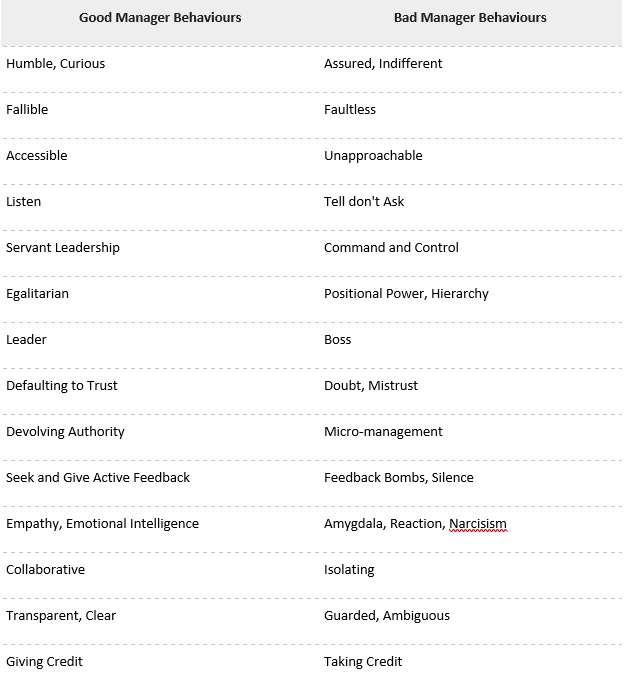
What consequences could a management face if they don’t set a good example?
We work in a majority of VUCA (Volatile, Uncertain, Complex, Ambiguous) situations. We’re in a new location. The issues we are facing are not execution issues; rather, they are circumstances where every opinion and thought must be heard in order to succeed. Our teams need to work in learning environments where it is safe to learn and where managers may promote positive behaviors.
Power dynamics at work are shifting.
The organizational models and structures that were effective twenty years ago are no longer in use. Employees have higher expectations for both their lives and the workplace.
“As new power models become integrated into the daily lives of people and the operating systems of communities and societies, a new set of values and beliefs is being forged. Power is not just flowing differently; people are feeling and thinking differently about it. A teenager with her own YouTube channel engages as a content creator rather than as a passive recipient of someone else’s ideas.”
But what about risk and failure? Sure, they’re bad.
Even teams in operating rooms can feel secure to take risks and to “fail” because of the environment that is fostered, similar to Amy’s study on psychological safety in hospitals. We truly mitigate and minimize the consequences of risk and failure when a manager increases the safety in speaking up, voicing concerns, challenging authority, and bringing all voices to the table.
Think about the alternative, where team members are more concerned with “image management” and are unwilling to challenge, bring up, or raise difficulties. Although the squad might take less risks, at what cost? Innovation frequently suffers first when a team is unwilling to discuss and assess risk as a unit. However, they will struggle less? This doesn’t seem to be the case; they’ll just carry out their plans without the assistance of their friends, who may have been able to prevent that outcome.
How Will You Increase Psychological Safety, Which Is A Delicate Concept?
We lack all of the solutions as managers. We don’t always act morally soundly. If our teams are not engaged, we can’t possibly complete all of the job that they do.
Managing psychological safety is a never-ending process, and the day-to-day amplifying behaviors become even more crucial. In the office, if our teams don’t speak out, we can’t see it or object, and sometimes silence just means consent.
What chances are you passing up if you don’t pay attention to every query, every worry, and every dissenting voice?
All managers must take the initiative to establish the conditions that will enable staff members to perform at their highest levels and advance the goals of their organizations.

Exercise 3.10: Jumping Ship

Course Manual 11: Hybrid Workplaces
Since the pandemic altered the working environment, much focus has been placed on WFH’s more obvious features, such as the difficulties of managing employees remotely (including diminished trust and changing power dynamics). However, a much less obvious component could have a significant impact on how productive hybrid workplaces are. As implied by the aforementioned quotations, managers will need to reconsider and broaden psychological safety, one of the most reliable indicators of team effectiveness, in order to address employees’ probable concerns about future work arrangements.
New Work Structures and Psychological Safety
It is well known that psychological safety, or the conviction that one may speak up without fear of retaliation or humiliation, is a key enabler of superior decision-making, positive group dynamics and interpersonal connections, more innovation, and more successful execution in businesses. Even in the most straightforward, factual, and crucial contexts, Amy’s work has demonstrated how difficult it is to establish and maintain psychological safety. For instance, making sure that operating room staff speak up to prevent a wrong-side surgery or that a CEO is corrected before sharing inaccurate data in a public meeting Unfortunately, psychological safety is anything but simple when WFH and hybrid working are present.
Managers have typically prioritized fostering candor and disagreement with regard to work-related topics when it comes to psychological safety. The issue is that managers must make staffing, scheduling, and coordinating decisions that take into account employees’ personal circumstances — a categorically separate area — as the line between work and life grows more and more hazy.
One employee may want to work from home occasionally in order to spend time with a parent who has recently passed away or to support a child who is having academic difficulties. For another, it might be impacted by a passion outside of work, like it was for a young professional who also trained as an Olympic-level athlete (something Covid threw into harsh focus). It’s important to note that both of us have heard from workers who feel ostracized, punished, or excluded from this conversation about work-life balance because they are childless or single, frequently being told that they are lucky not to have to deal with such difficulties. Discussions about work-life balance are difficult to have because they are more likely to touch on fundamental aspects of an employee’s identity, values, and choices. As a result, they become both more intimate and risky in terms of bias from a legal and ethical perspective.


Case Study: Reddit
One of Reddit’s corporate values is “evolve.” They made the decision to become a hybrid corporation by adhering to this maxim. Because of this, they provide their employees the freedom to choose whether they want to work in an office, remotely, or both!
They altered their pay plan after deciding to align themselves with the other hybrid businesses throughout the world. They consequently agreed to do away with geographic compensation zones in some nations. How does this affect Reddit? that employees’ pay would be based on wage ranges in expensive cities, regardless of where they worked.
Reddit has put a lot of effort into improving its hybrid work methods. To increase efficiency and foster kinship, trust, and alignment, they put a lot of effort into building workflows and improving the employee experience.
As a result, they establish workspace communities where teams may gather and reserve workstations. They have put in place policies like no more fixed desks, private rooms, spacious reservable restrooms, and collaboration spaces. Reddit sees a variety of advantages in going hybrid:
• Top talent will be attracted, and diversity will rise, if employees are not required to report to work every day.
• As a result of the employees’ perception that their requests are being addressed, morale and engagement will rise.
• They will also be able to encourage teamwork and communication.
We Cannot Simply Continue As We Are
In the past, we’ve treated “work” and “non-work” conversations as distinct topics, allowing supervisors to avoid bringing up the latter. However, many managers have discovered over the past year that previously taboo subjects like child care, comfort levels with health risks, or difficulties faced by spouses or other family members are increasingly necessary for joint (manager and employee) decisions about how to structure and schedule hybrid work.
What You Need to Know About the Return to Work
The change to a bigger share of WFH implies that, while it may be alluring to believe we can re-separate the two once we get back to the office, neither is a practical nor long-term answer. In the future, organizations who don’t change their strategy may find themselves attempting to optimize exceedingly difficult scheduling and coordination problems with insufficient, if not inaccurate, data. Keep in mind that hybrid working arrangements contribute to a concurrent rise in managerial complexity; managers now have to coordinate workflows among workers whose presence cannot be relied upon to occur at predetermined times in addition to the usual issues they faced in the past.
Managerial Strategies
Let’s begin by pointing out that the reasons managers have historically refrained from asking for personal information are still crucial and important now. Given the legal constraints on asking personal questions, the possibility for bias, and the need to protect employee privacy, sharing personal information has real and serious dangers. Therefore, increasing the disclosure of personal information cannot be the solution. Instead, managers must foster an atmosphere that encourages staff members to discuss personal matters that are pertinent to their work schedules or locations and/or to trust staff members to make decisions that are best for themselves, their families, and their teams. It is the role of management to widen the scope in which work-life concerns can be brought up. Today, psychological safety is required for constructive talks to take place in novel, difficult, and potentially dangerous territory.
It’s obvious that telling someone to “just believe me” won’t work. Instead, we recommend a set of five measures to develop a psychologically safe work environment that goes beyond only the work itself to encompass a wider range of employee experiences.
Step 1: Set the scene. As cliché as it may sound, the first step is to have a conversation with your staff to assist them understand not only your difficulties but also theirs. To share responsibility for the issue is the goal of this conversation.
We advise presenting this as a requirement for the group to engage in problem-solving to create fresh approaches to collaboration. Make clear what is at risk. The completion of the task is just as important as it has always been for the mission, the customers, and the employees’ careers, but it won’t be done exactly the same manner as in the past; employees will need to play a (creative and responsible) role in that. You and your staff must collectively come to understand that everyone must be clear and transparent about the requirements of the task and of the team, and that everyone must share responsibility for success, despite the numerous obstacles that lie ahead.
Step 2: Lead the way. Words are cheap, and there are far too many instances of managers demanding openness from their staff members—particularly when it comes to mistakes or other potentially uncomfortable topics—without modeling it for them or protecting it when others do share.
Sharing your own personal struggles and limitations with WFH/hybrid work is the best way to demonstrate your seriousness. Keep in mind that while taking risks of this nature, managers must act first. Be open and honest about your lack of a strategy, and be candid about how you’re considering handling your own difficulties. Why should you expect your staff to be honest with you if you’re not willing to be honest with them?
Step 3: Take baby steps. Expecting your staff to immediately disclose their most intimate and dangerous difficulties is unreasonable. It takes time to establish trust, and even if you have a strong psychological safety culture at work, keep in mind that this is a new field, and speaking out about problematic code differs from discussing personal issues.
You help your staff develop trust that sharing is not frowned upon, begin by making modest disclosures yourself. After that, make sure to encourage others to do the same.
Step 4: Share positive examples. Don’t assume that all the facts you have available to support the advantages of sharing these requirements and difficulties will be available to your staff right once.
Put your salesperson’s hat on and promote psychological safety by expressing your belief that more open communication is taking place and is assisting the team in creating fresh arrangements that meet both individual requirements and corporate objectives. Instead of disclosing information that was given to you privately, the purpose of this is to demonstrate how transparency has enabled you to work with the team to develop ideas that are better for the team as a whole as well as the personnel. The objective here is to provide employees the information they need to willingly buy in, therefore this needs to be done with sensitivity and competence to avoid creating pressure to conform.

Step 5: Be a watchdog. Most people are aware that psychological safety can be destroyed quickly but takes time to create. People tend to hold back and avoid sharing even their most pertinent ideas at work if they are unsure of how those ideas will be received. They will be less likely to speak up the following time if they do take the chance and are met with opposition.
When you hear employees say things like, “We want to see more of you,” or “We could really use you,” which can make them feel as like they’re failing their peers, you as the team leader need to be on the lookout and step in. This is a highly difficult task that calls for expertise. The goal is to help staff members frame these comments in a more sympathetic and constructive way, such as “We miss your intelligent perspective, and understand you have limits,” rather than acting as thought police or punishing individuals who genuinely miss or need their WFH coworkers. If there is any way we can assist, please let us know. So that others don’t interpret requests for their attendance as a criticism, be upfront about your desire to be inclusive and helpful. Be prepared to harshly reprimand people who misuse provided personal information at the same time.
Managers must consider (and discuss) these dialogues as ongoing projects. They are emergent processes that change with time, much like other group dynamics. This is just the beginning; the path ahead will require iterative navigation without a clear road plan. It’s preferable to err on the side of caution and test the waters rather than thinking that certain topics are off-limits because you might overstep and need to correct. Consider this an endeavor for learning or solving problems that might never get at a stable state. You and your team will be more successful in creating and upholding true, enlarged psychological safety if you keep that mindset rather of just announcing victory and moving on.

Exercise 3.11: Creating Groups

Course Manual 12: Leadership Development
Protection Of One’s Mental Health And The Need Of Developing One’s Leadership
Although the advantages of psychological safety are well known, a recent survey reveals that leaders may foster a more secure and productive workplace by honing certain skills.
Organizations are more likely to innovate quickly, realize the benefits of diversity, and adapt well to change when employees feel at ease asking for assistance, making informal suggestions, or challenging the status quo without worrying about facing social repercussions—all skills that have only become more crucial during the COVID-19 crisis. However, a McKinsey Global Survey carried out during the pandemic indicates that only a small number of business executives regularly exhibit the beneficial actions that can foster this environment, known as psychological safety, in their workforce.
At the individual, team, and organizational levels, psychological safety is a prerequisite for adaptive, inventive performance, which is necessary in today’s quickly changing environment, as extensive prior research demonstrates. A high level of psychological safety is necessary, for instance, to successfully establish a “network of teams,” an agile organizational structure that enables teams to solve problems rapidly by working outside of bureaucratic or siloed institutions.
Fortunately, our most recent research offers recommendations for how businesses might promote psychological safety. To do this, leaders at all levels must understand and practice particular leadership behaviors that promote the success of their teams. Investing in and expanding leadership-development programs can give leaders the tools they need to model these behaviors, which will help the business as a whole foster a culture of psychological safety.

Case Study: EY
Young potential leaders and young businesses are partnered through the EY EYnnovation program. This aids businesses in their early stages of expansion while also supporting young professionals in developing their leadership styles.
Young individuals are pushed out of their corporate environment and into the startup scene by the project, where they must network with other EY employees, forge new client contacts, inspire others around them, and grow and develop swiftly alongside the businesses they’re working with.
Each participant is already acquiring the technical abilities required to become an expert in their industry when they enroll in the program. They acquire soft skills like networking, building relationships with clients, inspiring and involving teams, sales training, meeting management, and other everyday leadership traits while working with the startups.
The business firmly thinks that executives who are focused on the future require a different profile than those in place now.
Their engagement with these businesses is crucial because EY wants people to have a diverse set of abilities before they advance to becoming partners. Of course, a person’s in-depth expertise in their industry is crucial, but the organization is aware that it needs more.
Timing is crucial as things change quickly in the startup environment, which is a fast-paced and frequently creative atmosphere. As a result, program participants develop and create their own tasks, relationships, and forward-thinking outlook. So much so that EY doesn’t need to find participants for the program—they voluntarily sign up.
Future leaders are eager to have an impact on the economic world. And for just these reasons, the startups are pleased to collaborate with EY. Future EY leaders are given fresh chances to improve operations one startup at a time.
How To Lead In A Way That Fosters Psychological Safety
Leaders can foster a psychologically safe environment within their teams by fostering the proper attitudes, behaviors, and culture. In our experience, individuals who do this well serve as catalysts, empowering and allowing other team leaders—even those without formal authority—to aid in the development of psychological safety by serving as examples of and motivating the team members to exhibit the behaviors they value.
According to our research, the most crucial factor influencing a team’s psychological safety is a positive team climate, which occurs when team members esteem one another’s contributions, care about one another’s wellbeing, and have a voice in how the team completes its job. The largest impact on a team’s psychological safety is exerted by team leaders, who set the tone for the team culture through their own behaviors. Additionally, fostering a supportive environment among the team can be beneficial when things are chaotic. According to our research, teams that have experienced more change due to working remotely have a bigger impact on psychological safety than teams that have seen less change due to the COVID-19 pandemic. However, only 43% of respondents overall claim that their team has a favorable environment.
The most significant factor influencing psychological safety is team environment, which is most likely to develop when leaders first engage in supportive, consultative behaviors before putting their teams through challenges.
One of the four well-known forms of leadership conduct we looked at to determine which ones promote a positive team climate and psychological safety has experienced an accelerated movement away from classic command-and-control leadership during the epidemic. According to the survey, team leaders’ forceful leadership styles are harmful to psychological safety whereas consultative and supporting leadership styles are advantageous.
The findings also indicate that by fostering a supportive team environment, leaders can further improve psychological safety. Both consultative and supportive leadership, though to variable degrees and through various behaviors, contribute to the development of a positive team environment.
By exhibiting particular actions, team leaders can raise the probability of psychological safety for team members.
Leaders that practice consultative leadership consult their teams, collect feedback, and take into account the opinions of the teams on matters that directly or indirectly affect them. Supportive leadership entails leaders displaying concern and support for team members not only as employees but also as individuals. It has an indirect but nonetheless substantial impact on psychological safety by helping to build a pleasant team climate. These actions can also motivate team members to help one another.
Sometimes, additional leadership behaviors can improve psychological safety, but only in the presence of a supportive team environment. This group of actions, referred to as challenging leadership, motivates workers to go beyond what they originally believe they are capable of. A demanding leader pushes team members to question presumptions about their task and the best ways to complete it in order to go above and beyond expectations and reach their full potential. Employees who experience challenging leadership are more likely to express their creativity, feel empowered to make changes at work, and be motivated to learn and grow. The survey results, however, indicate that the greatest likelihood of psychological safety occurs when a team leader first establishes a favorable team climate through regular supportive and consultative actions, followed by challenging their team; without a foundation of a favorable climate, challenging behaviors have no discernible effect. And depending on how their leaders act, Amy Edmondson, the Novartis Professor of Leadership and Management at Harvard Business School, claims that employees’ experiences might seem very different.
Additionally, the survey results demonstrate that an organization’s culture of psychological safety begins at the top. We investigated how senior leaders’ actions affected workers’ feelings of safety and discovered that by setting an example for others, senior leaders can contribute to the development of an inclusive culture that supports good leadership practices throughout a company. If senior leaders act inclusively, for instance by seeking out perspectives that might differ from their own and treating others with respect, team leaders are more likely to display supportive, consultative, and challenging leadership.
Fostering Leadership Development At All Levels
The mix of leadership behaviors that improve psychological safety can be fostered by investing in leadership development across an organization—for all leadership positions. The likelihood that team leaders frequently exhibit consultative, encouraging, and challenging leadership behaviors is higher among employees who report that their firms make significant investments in leadership development. They also rate senior leaders as more inclusive by 64% more often.
The findings, however, imply that the efficiency of these programs differs according on the abilities they target.
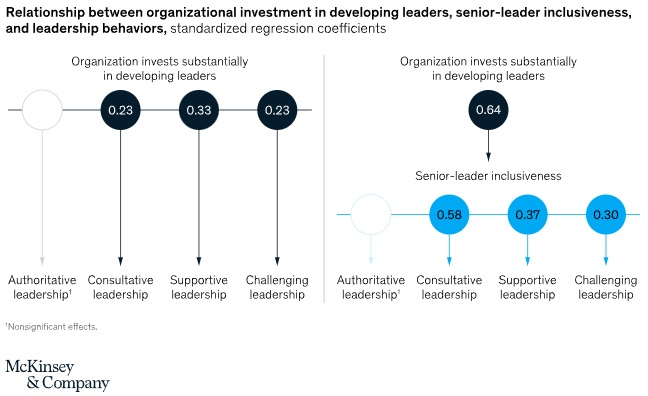
Leader behaviors that promote psychological safety are more prevalent in organizations that invest in leadership development.
Refocus The Abilities Acquired Through Leadership Programs
In their leadership-development programs, organizations frequently try to cover a wide range of issues. However, our results imply that concentrating on a small number of certain abilities and behaviors in these learning programs can increase the chance of beneficial leadership behaviors that support psychological safety and, ultimately, of great team performance. The skills that are most frequently taught in the respondents’ organizations—like open-dialogue techniques, which enable leaders to discuss conflicts and defuse tension in a team—are some of the ones that are most closely linked to effective leadership techniques. However, a number of largely untapped skill sets also produce positive outcomes.
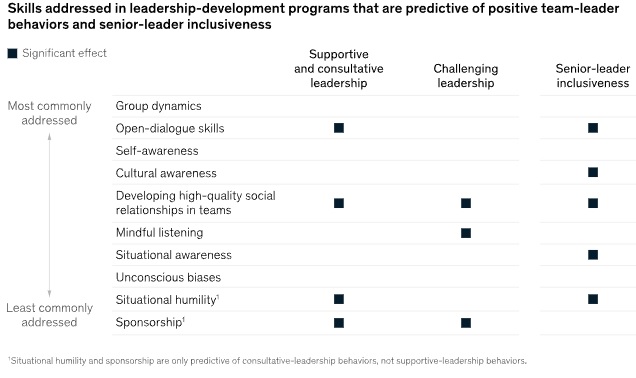
The least frequently addressed abilities in development programs encourage actions that support psychological safety.
Positive leadership is predicted by two of the less frequently covered skills in formal programs. Both consultative and challenging leadership styles are supported by training in sponsorship, although only 26% of respondents said their firms integrate the skill in development programs. Sponsorship is defined as putting the success of others before one’s own. Additionally, executives are taught how to cultivate a mindset of personal growth and inquiry by developing situational humility, which 36 percent of respondents claim their businesses handle. Addressing this competency predicts that leaders will act consultatively.
Top-Level Advancement Is Similarly Crucial
The evidence indicates that creating psychological safety at scale starts with the most senior leaders of organizations creating and modeling the leadership behaviors they desire to be seen throughout the business. Senior leaders can develop many of the same abilities that support strong team-leader behaviors to support inclusivity. For instance, developing social ties within teams and engaging in open discourse are critical skill sets for senior executives.
At the very top of the business, a few abilities are also more crucial. Senior leaders’ inclusion is related to situational and cultural awareness, or recognizing how views can be formed based on picky observations and the norms in many cultures.
Going Forward
Psychological safety is more crucial than ever given the accelerating rate of change and disruption as well as the demand for innovative, adaptable solutions from teams at all levels. Organizations that foster a culture of psychological safety through strong leadership and a supportive workplace environment stand to gain a lot from doing so, including increased creativity, experimentation, and agility as well as improved organizational health and performance.
Even while this is a clear call to action, the most frequently asked questions are still “How can we promote psychological safety?” and, more precisely, “Where do we start?” These survey results demonstrate that, in order to improve psychological safety, it is necessary to develop and fund leadership development at a large scale. Organizations can begin by taking the following actions:
Move beyond one-time training initiatives and implement a large-scale leadership development framework. It’s difficult to change human behavior overnight. Nevertheless, we frequently witness businesses make this attempt by applying only focused training programs. The first step in changing leadership behaviors within a complex system is to define a clear plan that is in line with the organization’s overarching aim and a thorough set of competencies that are necessary to achieve it. The realization of the organization’s overall identity must be supported by a taxonomy of skills that also stimulates development and progress and directly relates to people’s day-to-day work. One such talent is having an open discourse. Practically speaking, even though the learning may be delivered in a series of training sessions—and quickly codified and scaled for all leaders across a cohort or function of the organization—those training sessions will be even more effective when combined with other components of a larger learning system, like behavioral reinforcements. While the nature of learning has changed significantly since the COVID-19 pandemic, digital learning offers large businesses greater chances to use learning to break down organizational silos and forge new relationships.
Invest in leadership-development opportunities that are sensory, emotional, and yield epiphanies. Learning experiences that are intense and interesting are retained for a longer period of time and with more clarity. However, one common mistake made by learning programs is an excessive concentration on the subject matter, even though it is rarely a lack of knowledge that prevents leaders from reaching their full potential. To achieve long-lasting mindset changes, learning programs must therefore encourage leaders to confront and modify their fundamental assumptions, beliefs, and feelings. This calls for a learning environment that is both supportive of the frequently vulnerable learning process and properly designed. Companies might start by creating guided learning opportunities that encourage personal reflection through focused reflection questions and small, private breakout discussions. These settings can foster more self-awareness in leaders, ignite a desire for continued development, and, with the aid of reflection and feedback, promote group development and performance.
Create systems to integrate growth into leaders’ daily tasks. In the context of real work, formal education and skill development act as launching pads; the most fruitful learning journeys take into consideration the rich learning that occurs in regular work and relationships. Learning nudges, or regular, personalized reminders for specific people, can assist students in overcoming challenges and transitioning from information retention to application. Senior leaders must set an example for others by making their own learning processes visible, which calls for them to be the first adopters of this practice inside the organization. The idea of a role model has changed in this environment; rather than acting as an example of the final product, role models now represent works in progress that are strong in self-belief but lacking in perfect solutions. These instances serve as powerful reminders to executives throughout the organization that it is okay to experiment, make mistakes, and learn new things while working.

Exercise 3.12: Centre Stage
Project Studies
Project Study (Part 1) – Customer Service
The Head of this Department is to provide a detailed report relating to the Psychological Safety process that has been implemented within their department, together with all key stakeholders, as a result of conducting this workshop, incorporating process: planning; development; implementation; management; and review. Your process should feature the following 12 parts:
01. The Importance
02. Measuring Safety
03. Inclusion Safety
04. Learner Safety
05. Contributor Safety
06. Challenger Safety
07. Fear
08. No-Blame Culture
09. Failure
10. Manager’s Role
11. Hybrid Workplaces
12. Leadership Development
Please include the results of the initial evaluation and assessment.
Project Study (Part 2) – E-Business
The Head of this Department is to provide a detailed report relating to the Psychological Safety process that has been implemented within their department, together with all key stakeholders, as a result of conducting this workshop, incorporating process: planning; development; implementation; management; and review. Your process should feature the following 12 parts:
01. The Importance
02. Measuring Safety
03. Inclusion Safety
04. Learner Safety
05. Contributor Safety
06. Challenger Safety
07. Fear
08. No-Blame Culture
09. Failure
10. Manager’s Role
11. Hybrid Workplaces
12. Leadership Development
Please include the results of the initial evaluation and assessment.
Project Study (Part 3) – Finance
The Head of this Department is to provide a detailed report relating to the Psychological Safety process that has been implemented within their department, together with all key stakeholders, as a result of conducting this workshop, incorporating process: planning; development; implementation; management; and review. Your process should feature the following 12 parts:
01. The Importance
02. Measuring Safety
03. Inclusion Safety
04. Learner Safety
05. Contributor Safety
06. Challenger Safety
07. Fear
08. No-Blame Culture
09. Failure
10. Manager’s Role
11. Hybrid Workplaces
12. Leadership Development
Please include the results of the initial evaluation and assessment.
Project Study (Part 4) – Globalization
The Head of this Department is to provide a detailed report relating to the Psychological Safety process that has been implemented within their department, together with all key stakeholders, as a result of conducting this workshop, incorporating process: planning; development; implementation; management; and review. Your process should feature the following 12 parts:
01. The Importance
02. Measuring Safety
03. Inclusion Safety
04. Learner Safety
05. Contributor Safety
06. Challenger Safety
07. Fear
08. No-Blame Culture
09. Failure
10. Manager’s Role
11. Hybrid Workplaces
12. Leadership Development
Please include the results of the initial evaluation and assessment.
Project Study (Part 5) – Human Resources
The Head of this Department is to provide a detailed report relating to the Psychological Safety process that has been implemented within their department, together with all key stakeholders, as a result of conducting this workshop, incorporating process: planning; development; implementation; management; and review. Your process should feature the following 12 parts:
01. The Importance
02. Measuring Safety
03. Inclusion Safety
04. Learner Safety
05. Contributor Safety
06. Challenger Safety
07. Fear
08. No-Blame Culture
09. Failure
10. Manager’s Role
11. Hybrid Workplaces
12. Leadership Development
Please include the results of the initial evaluation and assessment.
Project Study (Part 6) – Information Technology
The Head of this Department is to provide a detailed report relating to the Psychological Safety process that has been implemented within their department, together with all key stakeholders, as a result of conducting this workshop, incorporating process: planning; development; implementation; management; and review. Your process should feature the following 12 parts:
01. The Importance
02. Measuring Safety
03. Inclusion Safety
04. Learner Safety
05. Contributor Safety
06. Challenger Safety
07. Fear
08. No-Blame Culture
09. Failure
10. Manager’s Role
11. Hybrid Workplaces
12. Leadership Development
Please include the results of the initial evaluation and assessment.
Project Study (Part 7) – Legal
The Head of this Department is to provide a detailed report relating to the Psychological Safety process that has been implemented within their department, together with all key stakeholders, as a result of conducting this workshop, incorporating process: planning; development; implementation; management; and review. Your process should feature the following 12 parts:
01. The Importance
02. Measuring Safety
03. Inclusion Safety
04. Learner Safety
05. Contributor Safety
06. Challenger Safety
07. Fear
08. No-Blame Culture
09. Failure
10. Manager’s Role
11. Hybrid Workplaces
12. Leadership Development
Please include the results of the initial evaluation and assessment.
Project Study (Part 8) – Management
The Head of this Department is to provide a detailed report relating to the Psychological Safety process that has been implemented within their department, together with all key stakeholders, as a result of conducting this workshop, incorporating process: planning; development; implementation; management; and review. Your process should feature the following 12 parts:
01. The Importance
02. Measuring Safety
03. Inclusion Safety
04. Learner Safety
05. Contributor Safety
06. Challenger Safety
07. Fear
08. No-Blame Culture
09. Failure
10. Manager’s Role
11. Hybrid Workplaces
12. Leadership Development
Please include the results of the initial evaluation and assessment.

Project Study (Part 9) – Marketing
The Head of this Department is to provide a detailed report relating to the Psychological Safety process that has been implemented within their department, together with all key stakeholders, as a result of conducting this workshop, incorporating process: planning; development; implementation; management; and review. Your process should feature the following 12 parts:
01. The Importance
02. Measuring Safety
03. Inclusion Safety
04. Learner Safety
05. Contributor Safety
06. Challenger Safety
07. Fear
08. No-Blame Culture
09. Failure
10. Manager’s Role
11. Hybrid Workplaces
12. Leadership Development
Please include the results of the initial evaluation and assessment.

Project Study (Part 10) – Production
The Head of this Department is to provide a detailed report relating to the Psychological Safety process that has been implemented within their department, together with all key stakeholders, as a result of conducting this workshop, incorporating process: planning; development; implementation; management; and review. Your process should feature the following 12 parts:
01. The Importance
02. Measuring Safety
03. Inclusion Safety
04. Learner Safety
05. Contributor Safety
06. Challenger Safety
07. Fear
08. No-Blame Culture
09. Failure
10. Manager’s Role
11. Hybrid Workplaces
12. Leadership Development
Please include the results of the initial evaluation and assessment.

Project Study (Part 11) – Logistics
The Head of this Department is to provide a detailed report relating to the Psychological Safety process that has been implemented within their department, together with all key stakeholders, as a result of conducting this workshop, incorporating process: planning; development; implementation; management; and review. Your process should feature the following 12 parts:
01. The Importance
02. Measuring Safety
03. Inclusion Safety
04. Learner Safety
05. Contributor Safety
06. Challenger Safety
07. Fear
08. No-Blame Culture
09. Failure
10. Manager’s Role
11. Hybrid Workplaces
12. Leadership Development
Please include the results of the initial evaluation and assessment.

Project Study (Part 12) – Education
The Head of this Department is to provide a detailed report relating to the Psychological Safety process that has been implemented within their department, together with all key stakeholders, as a result of conducting this workshop, incorporating process: planning; development; implementation; management; and review. Your process should feature the following 12 parts:
01. The Importance
02. Measuring Safety
03. Inclusion Safety
04. Learner Safety
05. Contributor Safety
06. Challenger Safety
07. Fear
08. No-Blame Culture
09. Failure
10. Manager’s Role
11. Hybrid Workplaces
12. Leadership Development
Please include the results of the initial evaluation and assessment.
Program Benefits
Production
- Work measurement
- Labor efficiency
- Constraints management
- Workload balance
- Methods standardization
- Manufacturing reporting
- Changeover completion
- Personnel assignment
- Cost reduction
- Capacity utilization
Operations
- Interactive research
- Project execution
- Quality management
- Continuous improvement
- Performance analysis
- Cost effective
- Time effective
- Process improvement
- Performance improvement
- Process decentralization
Human Resources
- Improve engagement
- Improve retention
- Mitigate burnout
- Foster wellbeing
- Human flourishing
- Inclusive environment
- Recover morale
- Inspire workforce
- Reduce absenteeism
- Employee satisfaction
Client Telephone Conference (CTC)
If you have any questions or if you would like to arrange a Client Telephone Conference (CTC) to discuss this particular Unique Consulting Service Proposition (UCSP) in more detail, please CLICK HERE.

























